Nyambe: African Adventures by Libertad!
Land of the Overpower
Original SA post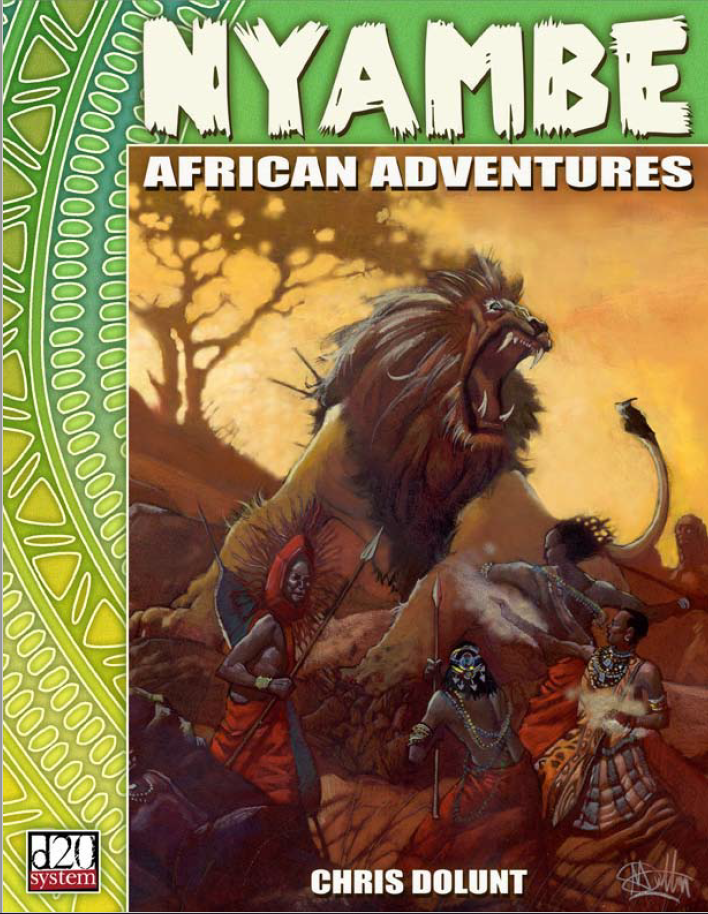
For its near-fifty years of existence, Dungeons & Dragons has branched out into a variety of inspirational material beyond the Tolkien-styled European fantasy. The older AD&D Player’s Handbook sprinkled artwork of adventuring parties, shrines, and equipment from non-medieval time periods, and 2nd Edition had a brief run of “historical fantasy” sourcebooks set during the Crusades and other eras. Al-Qadim, Maztica, and Kara-Tur dipped its toes into Asian, Arab, and Mesoamerican tales, while Dark Sun’s various city-states had touchings of Ancient Greek, Phoenician, and even Sumerian trappings among others.
But sub-Saharan Africa has had a rockier history when it came to holistic settings. Beyond obscure homebrew and third party worlds, pre-OGL D&D had such influences confined to very small and/or specific regions within existing settings. Faerun’s Chult is mostly a trackless jungle with but a few trade cities; Ravenloft’s Wildlands are literally the Darkest Africa trope minus any indigenous humans; Dark Sun’s city-state of Gulg may be the only exception in a primarily-urban example, but when you compare these options to the more fleshed-out regions and countries there’s not much to build a campaign on that ventures outside of wilderness exploration.
And this is not even getting into the insensitive racial portrayals that dotted old magazines and sourcebooks!
Nyambe is often credited as the first holistic “Fantasy Africa” sourcebook meant to be its own self-contained campaign, and it got a lot of talk back in the day due to this.Upon first release in 2002 it definitely qualified for 3rd Edition D&D when the OGL was still a new thing indie game designers were testing out, sometimes to legally disastrous results.
Nyambe actually got its start in 2001 as a free web supplement sans artwork and some newer content featured in this book. I cannot find any active links as most of the domain hosting has long expired, although I found this very brief fraction of a review with the creator Chris Dolunt going into his writing for the game. The line lived only very briefly, spawning a core setting book, the Ancestral Vault (new equipment and magic items and a 3.5 rules update), Dire Spirits (adventure), and several free web enhancements before being discontinued. However, the setting would go on to be mentioned in Atlas Games’ Northern Crown supplement, a pseudo-fantastical version of Colonial America which shares the same Material Plane universe as Nyambe. But the game was not necessarily forgotten; on the contrary, its unique place in what would become the overcrowded 3rd party market made it stand out all the more.
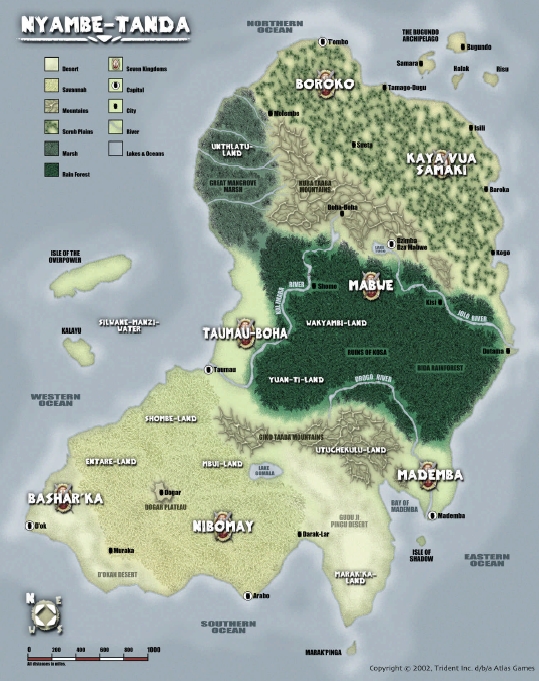
Land of the Overpower
Enough with the history lesson, let’s dive into this book! This first post actually details two chapters: Land of the Overpower is an introductory overview written from the in-character perspective of a scholar from the great city of T’ombo. Chapter Two, Mythology & History, looks over the history of the world dating from its cosmic creation to the present era.
quote:
Hewa-hewa! I am Shomari of T’ombo, a teacher at the great school of T’ombo. I have been selected to guide you through the lands of Nyambe-tanda, a daunting task indeed. Nyambe-tanda — sometimes simply called Nyambe — is a land in transition. Though we have never been completely isolated, recent events have brought us to the attention of the outside world, and I fear that our way of life is about to change for the worse.
As a stranger, you do not know our ways. Pay careful attention and I shall teach them to you.
If you wish to walk beneath our sky, you must learn to walk as we do, or you will surely die. Forgive my gravity, but this is a serious matter. Nyambe is not a safe place for the unwary. Vicious monsters, black-hearted tyrants, and foul magic await you at every turn, and the spirits cry out for brave heroes to fight the evil.
This is not to say that Nyambe is devoid of peace or beauty. To the contrary, we believe that our land is the most blessed in the entire world. But do not take my word for it, read on and decide for yourself.
Land of the Overpower first starts out with the standard D20 fare, along with what to expect: first off, Nyambe is a continent derived from aspects of actual mythology, folklore, and history re-imagined to be placed in a fantasy context rather than relying upon Darkest Africa tropes. The continent takes place within the confines of a larger world, with some implied fantasy counterpart cultures having contact with the people but are meant to be substituted with realms of one’s own creation: Northerners are Europeans, Near Easterners are Middle Easterners, Water People are Ancient Egyptians, and Far Easterners are Chinese/Japanese people.
Nyambe-tanda is the name of the continent, which translates to “Land of the Overpower,” although the sourcebook uses Nyambe and Nyambe-tanda interchangeably at times. The continent’s people are collectively called Nyambans, although this is usually in regards to sweeping comparisons by continental foreigners. The referencing of people in regards to specific races and nations is more often utilized. Virtually every culture in this land refers to the creator of reality as Nyambe, the Overpower. Nyambe used to live among mortals but withdrew, so people see it fitting to attribute the land they live on to the one that crafted it from nothing. Nyambe-tanda sits closer to the global equator than surrounding lands, causing many places to be warmer than average. While heavier armor does exist, it is impractical so many warriors learned martial arts collectively known as “sanguar” which emphasize speed and grace.
The most-numerous people of Nyambe-tanda hew close to fantasy standards: humans outnumber the other races and have 12 major ethnic groups, of which there are many minor ones not mentioned and often subject to change due to shifting regional boundaries, cultural exchange and intermarriage, and so on. In some cases these groups are synonymous with nationality, but others are minority groups within larger kingdoms or scattered nomads with common linguistic and cultural origins. The “non-humans” of Nyambe-tanda are collectively referred to either as demihumans, those friendly to humans, or savage races, for those hostile to humanity. Both examples largely consist of humanoids rather than more exotic aberrations, undead, and so on which do exist but not necessarily in numbers great enough to form their own societies. What is peculiar to Nyambe-tanda is that there are no goblinoids of any sort, and a race of people known as the kosans which orcs descend from once ruled a great empire in ancient history but are now extinct for all intents and purposes.
Animal and plant life corresponds largely to real-world Africa, with some unique fantasy trappings. Dire animals, particularly lions, may sport unusual colorations which their normal counterparts do not have, and that the sight of one may portend a future omen. Many foreigners remark that the unique animals here are large and impressive, from giraffe to rhinoceroses. The plantlife, both edible and not, is bewildering thanks in no small part to the large rainforests. Palm oil and wine are common trade goods, while some exotic crops such as bananas, coconuts, and rice have been imported by Far Eastern traders.
We then go over a variety of monster types. First off, beings native to colder climates do not naturally inhabit the continent (white dragons excepted), and a lot of magical monsters originated as war machines during the times of the Kosan Empire. A few specific setting tropes are that elementals and outsiders are servants of orisha spirits pertaining to their nature, as are fey but they live in the Shadow World, while the most common undead are true zombi and ancestor spirits who are not found in other parts of the world. Dragons have a special place in Nyamban history for their creation of the sei, a sorcerous type of arcane caster.

Religion, Cosmology, and Magic
So far we’ve had some typical and recognized fantasy tropes but with twists. Here is where things get really different. First off, the world of Nyambe-tanda is technically a monotheistic one. The Overpower is the creator of all that is, and all forms of magic spring from them.* The Orisha are spirit servants which hold sway over various domains of reality, and act as intermediaries between the Overpower and mortals. The number of orisha is quite literally uncountable, for there is no overarching orisha of Plants or of Mountains, but represent specific species, geographical features, ancestors of particular peoples, etc. There are some orisha well-known enough that their names spread far and wide, but they are more or less limited to the celestial and fiendish groupings. The concept of a deity is reserved for Nyambe and Nyambe alone, for it can mean nothing other than one who is lord of all.
*the god is not limited to the gender binary
So how does this tie into magic, particularly the arcane/divine divide and the classes? First, divine magic, or ashe, is when a person petitions an orisha for aid, and said orisha sends helpful magic their way. It is by far the more common and socially accepted type of magic, and almost every village has some kind of divine spellcaster acting as a specialist. Arcane magic, or dimba, bypasses the Orisha-Overpower arrangement. Mchawi, the setting’s wizard equivalent, is basically an arcane Ur-Priest who uses ritual items to steal what spells they need directly from the Overpower. They must literally sell their souls to a fiendish orisha in order to learn this secret, and cannot resurrect into the world of the living save as an evil animal spirit. The other type of arcane caster is the Sei, sorcerers born with draconic heritage, drawing spells directly from the Overpower but without any soul-bargaining required.
Finally, the cosmology of the setting is different than that of the standard “inner planes/outer planes/transitive planes” of 3rd Edition D&D. The Material Plane contains four great oceans, upon which the continent of Nyambe-tanda sits at the relative center. Said oceans are held within a giant gourd forming the borders where the Spirit World lies beyond. The “stars” are actually holes in the gourd linking to the Shadow World from where magic flows, and the sun and the moon are a married orisha pair known as Lahu and Masa respectively. Sadly their relationship became abusive, with physical scars: Lahu was ashamed of his wounds and shone so brightly that nobody could see them, while Masa wanted all to know what her husband had done and sometimes reveals more of her form as phases of the moon. Their hostility lasts to this day, and this is why they are never seen in the sky at the same time.
The Shadow World is a combination of the Ethereal and Astral Planes, whose features are much like its Material Plane counterpart but viewed through the lens of a hallucinogenic drug trip. The creatures native to this place are largely unknown and mysterious to mortals. The Spirit World, commonly called Da, is the home of the Orisha. Da is coiled around the Material Plane like a snake, with 3,500 coils above and an equal number below. Each coil constitutes its own universe inhabited as many as one or millions of orisha. Some realms, such as the realm of the dead which manifests as 30 storm-swept universe-oceans, spread out into multiple coils.
Technology and Family Life
The final two portions of this chapter covers technology levels and family units. Nyambe-tanda’s devices and innovations rival that of medieval realms, with the larger kingdoms having master iron making. Hunter-gatherer societies are common, especially among nomadic groups, and there are a few independent city-states, especially in the north. Heavy armor is rare due to impracticality, and while steel-working is known the element of iron has holy properties and many smiths do not wish to “pollute” it with foreign substances. Only glass-working is unknown in Nyambe-tanda, and the Near Easterners have tried introducing glass beads as a currency to hold smaller economies hostage, although most rural people continue to use cowry shells instead of gold and silver coins.
Family is important in Nyambe-tanda, much like anywhere else. In fact, the souls of those who die without children exist in a state of ennui in the after-life’s oceanic depths, waiting to be reincarnated. This places a high emphasis on marrying and having children, and those suffering from reproductive problems procure alchemical and magical fertility aids to overcome this. Such aids are common even in the poorest villages, their demand so high. Polygamy, while not universal, is legal in every land save for Bashar’ka, which enforces monogamy, and the Empire of Nibomay, which is matriarchal and polyandry is permitted. Plural marriages are mostly the province of the upper class, and a married woman joins the extended family of her husband, or husband the wife’s in Nibomay.
Virtually every culture regards the naming of a child as great importance, and multiple oracles are consulted to come up with the best name. Interestingly, adolescence is marked with coming-of-age rituals, often informally known as the “warrior” or “adventurer” stage of life due to the fact that most people in these occupations are under age thirty. Settling down and raising a family marks the transition to a “full adult.” As such, many cultures regard adventurers as having a sort of eternal adolescence. When a person dies, they become an ancestor orisha who can be called upon and consulted by divine spellcasters, as well as watching over their descendants for future generations.
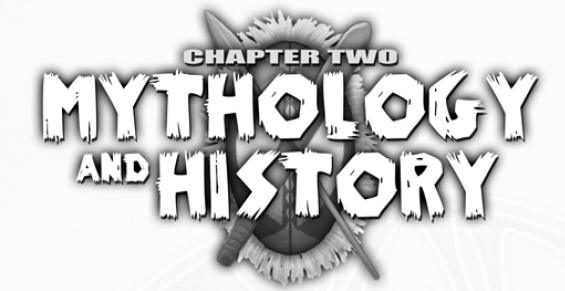
This chapter covers the history of the world, shifting from an in-character narrator to a neutral objective narration. Oral traditions are the most common means of record-keeping; written records and calendar systems are known, but are both rare and differ wildly which prevents a true dating of events. In fact, Nyambans overall view time as cyclical with no true beginning and end: history itself will eventually repeat, so the assignment of dates is regarded as pointless.
This kind of contradicts the preceding chapter, where years in regards to the passing of adulthood are used and thus implies an annual or even seasonal system of sorts. Most communities have five-day weeks, with four of those days work and the fifth for religious observance. Magical divination is used for tracking solstices and equinoxes, meaning that non-magical astronomy is more or less pointless. The Mbanta nomads are the exception, who have a developed calendar system which is used for enhancing magical spells.
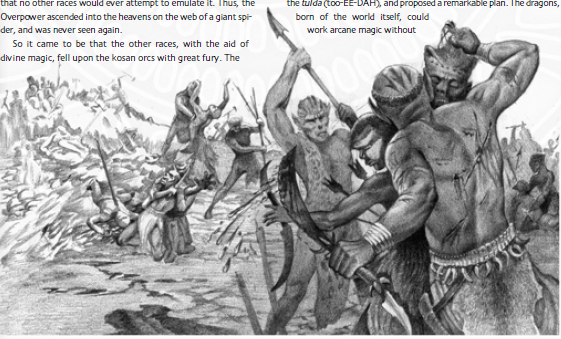
Mythical Ages: This covers the pre-history of Nyambe-tanda, beginning with the creation of all that is and ending with the downfall of the Kosa Empire. The Overpower was the first entity in reality; both male and female, the god became pregnant with an idea and gave birth to the world. The Overpower gazed upon their creation, and found that the continent of Nyambe-tanda was the only place beautiful enough to make a home. Soon the Overpower created other beings, from animals and plants to orisha and mortal humanoids for company. The intelligent beings sought to please their creator in various ways:
quote:
The races of people possessed a desire to please the Overpower, and quickly learned to emulate their creator. When the Overpower used stone to repair its home, the utuchekulu did this as well. When the Overpower grew plants in its garden, the wakyambi did this as well. When the Overpower dug cellars into the ground, the agogwe did this as well. When the Overpower shuttered its windows to keep out the light, the kitunusi did this as well. Finally, when the Overpower forged iron into a plowshare, the kosans did this as well. Only the young humans failed to emulate their creator.
But soon, the various races of peoples began arguing as to which race best emulated the Overpower. This argument went on for many moons, until the kosan orcs discovered how to forge iron into spears.
The kosans grew arrogant and began killing the other races in what became known as the first war. The Overpower grew sad and isolated themself, sharing the secrets of resurrection with a bat and a frog to spread the word and reverse the damage. The bat offered to carry the frog in its mouth while it flew to the various villages, only for the winged rodent to grow hungry and eat the frog. The bat only remembered the first half of the message: “when people die, you must bury them in the ground.” The Overpower’s attempt to teach people resurrection failed, and priests have been trying to master the full secret ever since. Even magical resurrection has its own limitations and requirements, from material components to portions of the body being available.
Those suffering under the kosan’s depredations begged the Overpower for more direct intervention, even asking for violent action. But the Overpower was a pacifist, so they would instead aid indirectly. The god gave the secrets of magic to the orisha to act as intermediaries. Then the Overpower ascended into the heavens on a giant spider’s web, never to be seen again. The kosans began to lose the war but turned the tide when they learned arcane magic from orisha of unknown origin. Some say they are the kosan ancestors, others failed creations of the Overpower, but today they are known as the Fiendish Orisha.
Sadly the Kosans won, and ruled over a continent-spanning Empire of great oppression and dark magic which even reached across the oceans. The descendants of the kosans in other realms would become known as orcs. The orisha retreated from mortal life, a sort of non-aggression pact reached with the Kosan’s fiendish orisha. But one orisha secretly approached the tuIda dragons. Born of the world itself, these creatures could work arcane magic without the orisha, and if they bred with mortals this power would be passed on to the oppressed populace. And so the seeds of rebellion were sown.
Eventually a group of slave-women with sorcerous powers rose up, overthrowing their masters with the very razors used to groom Kosan hair. The leader of the women, Amazonia, led a group of rebels known as the Amazons, liberating the city of Arabo which would come to be the capital of the Empire of Nibomay. Thousands of sei sorcerers revealed their powers in displays of arcane might across the Empire, the first of many slave rebellions that spelled the end of their reign.
Ancient Ages: With the Kosa all but slain, the other races of Nyambe-tanda grew to prominence. The matriarchal Empire of Nibomay’s humble origins began with the city-state of Arabo, gradually expanding to cover the western half of the continent. In the East, the Water People mastered the secret of bronze weapons and worshiped unknown gods. They enslaved the indigenous people and forced them to build great pyramids and monuments before eventually going to war with Nibomay. The rainforest-dwelling Boha-Boha people were one of the civilizations caught in the crossfire, and their leaders summoned legions of demons in desperation to hold back the Water People. Although successful, this came at a terrible cost, where advancing Nibomay soldiers encountered entire villages and cities impaled upon sacrificial pikes for the great summoning.
The other great events in this era included the tale of the great fire priest Bashar, who defeated a powerful blue dragon demanding livestock as tribute among the Marak’ka people. In a rather ingenious move, Bashar had three chances of poisoning the dragon before admitting defeat. First he tried to feed the dragon dragon poison, but he could smell it. He then tried poisoning a goat to feed him, but the poison killed the animal too fast. So Bashar baked the poison into a millet cake, which would digest slower in a goat’s stomach. By offering said goat as tribute to the dragon, his plan was successful and the mighty beast died. Bashar became a war chief, eventually leading a portion of his people into the western grasslands and forming the kingdom of Bashar’ka.
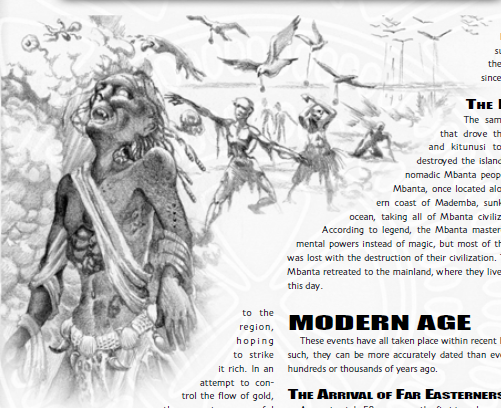
Middle Ages: The Middle Ages occurred sometime hundreds of years ago, far beyond the Ancient Ages thousands. As such, it is considered more “recent history” to the longer-lived races, but to humans is still a long enough time in the past. This era is marked with the rise of Zombi cults, named after a fiendish orisha who holds dominion over serpents and the undead. Zombi entrusted a mortal mage named Zulo with great power if he acted as a prophet, and after achieving lichdom he formed the mighty Zombi Empire. Their long and terrible reign lasted in part because they were wise enough not to directly challenge Nibomay, terrorizing populations unable to resist. But the Zombi Empire made a terrible mistake when they slaughtered an entire village save for a young boy named Kwo. At first wanting a survivor to spread their tale, the boy burned with vengeance, exercising and learning to fight among his adopted family. He soon became a great mounted warrior after buying an exotic horse-like engargiya animal used as beasts of burden on other continents. Kwo took the title the Hungering Lion after he mastered cavalry warfare. He led a strike team against Zombi holdings, rewarded with iron weapons from the grateful populace of Taumau-Boha,* their numbers growing as they ventured to the capital. Zulo’s undead army was defeated by summoning a flock of stone-bearing sea birds to rain rocky ruin upon the unliving legion, each one enchanted with positive energy spells. Zulo was captured by Kwo and beheaded, although nobody could account for his phylactery. Instead of replacing the emperor, Kwo granted self-rule back to the various conquered peoples.
*those once enslaved by the Water People
The other notable events of this era included first contact with the Near Easterners, a Fantasy Counterpart Arab-Muslim civilization whose boats landed in northern Nyambe-tanda. They sought to convert the native populace to their religion, by peace or by force if that failed. They established the theocracy of Boroko, which is now ruled by native Nyambans. The Near Easterners also brought some new technologies and concepts such as steel weapons and university and mercantile houses. In the rainforests of central Nyambe, the kingdom of Mabwe grew rich from striking ample gold veins in the mountains, causing Nibomay to invade them and be repelled. Fearing their empire’s decline what with no longer holding a monopoly on iron, Nibomay sought allies among the gnome-like kitunusi who were engaged in a war with the dwarf-like utuchekulu. Both of the latter races came to the surface realms from a great earthquake, eventually establishing new lands and a nation in the kitunusi’s case once they were granted autonomy by Nibomay.
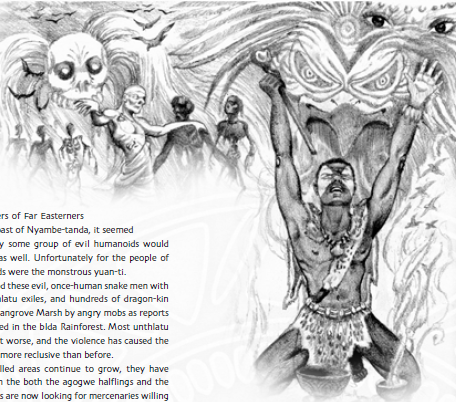
Modern Age: The events of this era stretch back a mere 50 years from the present. The transition from the Middle Ages was with the arrival of the Far Easterners in northeast Nyambe. Although no stranger to violent opportunism, they primarily sought trade and built several cities on the coast. They traded heavily with Nibomay and Mabwe for precious metals and body parts of native wildlife, leading to some species growing endangered from over-hunting. Eventually the Far Eastern trade hubs grew into a powerful alliance of city-states known as the East Nyamban Merchants’ Confederation, although most people call the pseudo-nation Kaya Vua Samaki, or “fish-catching towns.”
The Far Easterners’ arrival made the oba (king) of Mabwe grow paranoid, who commissioned a massive wall to be built around the capital city for fear of an invasion. While most Far Easterners’ run the gamut of alignments, some yuan-ti opportunists arrived in secret among them, seeking to exploit the natural resources of the bIda Rainforest which Mabwe is part of and enslaving the local populace. This has only fueled more xenophobia, not just in Mabwe but also further north, as dragon-blooded unthlatu demihumans are mistaken and blamed for yuan-ti depredations.
The two other major political conflicts include tensions between Bashar’ka and Boroko, and the arrival of the Northerners. In the former case, the Queen of Bashar’ka visited the Caliph of Boroko on a diplomatic mission. Being a predatory and lustful man, the Caliph sought to bed her by any means necessary. With enough pleading and pressure, she eventually claimed that she would only sleep with him as part of repaying a debt or favor. The Caliph responded by ordering his cooks to over-spice the food and remove all sources of water from his palace, causing a now-sweating queen to ask for a drink and thus forcing her into sex.
Nine months later the Queen gave birth to a son, which gave her a great amount of power for he could be the rightful ruler of Boroko. The Caliph denies this of course, and the only thing preventing war is their two kingdoms being on opposite sides of the continent.
Several months ago, a group of people from a distant continent in the north came to raid lightly settled western coasts. Instead of trade, conversion, or setting up nations, the Northerners are primarily interested in gold and slaves. In fact, eyewitness reports say that the Northerners are orcs, their ships fleeing across the ocean once they’re filled to capacity. Coastal villages increased their warriors and defenses, and people fear their return.
Thoughts So Far: Nyambe’s first impressions are neat and interesting. The cosmology and theology is clearly different from most D&D worlds, and I like that they have a clear origin story for arcane magic which a surprising number of settings lack. The animist-flavored monotheism bears a strong resemblance to Vodoun, which has its own supreme creator with a host of spiritual intermediaries called upon by mortals. The setting’s history is interesting and manages to be brief while conveying some overarching information in a legendary storytelling style over that of dry history. I also liked that Nyambe was not depicted as an isolated land, which real-world Africa is all too often portrayed; the Easterners/Northerners/etc are more an auxiliary aspect to be replaced with your own setting’s people, although the religious crusades of the Near Easterners and orc (or at least orc-allied) Northerners makes some inherent assumptions that may not necessarily map to other popular published settings. But overall this is a strong start.
Join us next time as we cover the Races and Cultures of Chapter Three!
Races and Cultures
Original SA post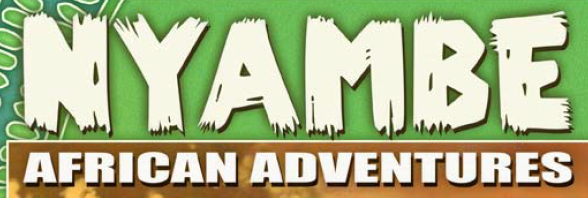
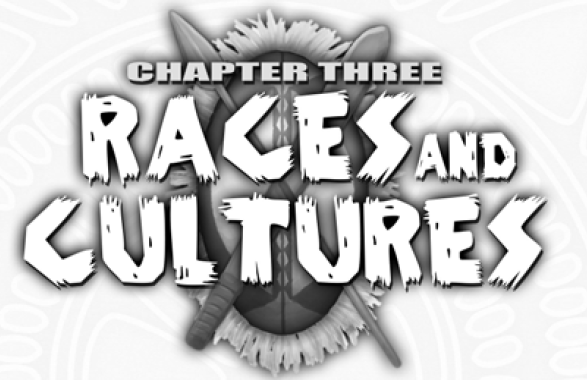
Human Variants
This entry details the twelve major ethnic groups of Nyambe-tanda. The text acknowledges that Nyambe has many more minor ethnicities (such as the near-vanished Boha-Boha) but that the twelve here are most likely to produce adventurers. Like most D&D settings humans are numerous and short-lived. In comparison to demihumans, humans have a preponderance of cultures, languages, and worldviews. Demihumans are quick to point to this diversity as a sign of strife in the manifestation of competing kingdoms, whereas the demihuman races are more monolithic among their respective peoples. There’s some implied humanocentrism and racism in said demihumans often find human lands inhospitable. Many humans reject these characterizations, couching intolerance as competition and strife as a constant desire to succeed and improve upon themselves.
What’s interesting is that each entry (both human groups and demihumans) conveys a good amount of information about various cultural aspects in a short amount of dialogue. We have sections on common religious practices, forms of government, relations with other groups, traditional lands, food, rituals, artwork, favored orisha, names, and languages all in the span of 1-2 pages, including the accompanying artwork. I won’t go over each such entry (that would amount to copy-pasting) but I will highlight what I find the most interesting aspects among the peoples. Due to the relative rarity of writing materials all races are illiterate by default and must spend 2 skill points to gain the ability to read and write any language they are able to speak.
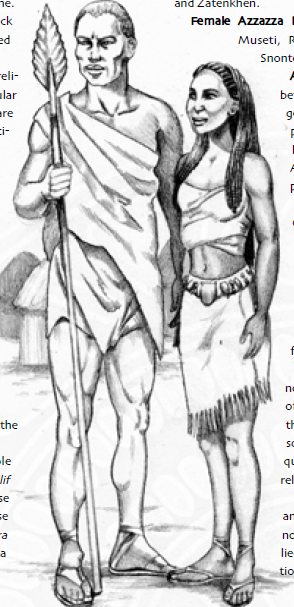
Azzazza: The Azzazza people are native to the United Kingdoms of Taumau-Boha and were once conquered and enslaved by the Water People long ago. Most Azzazza live sedentary lives as farmers, their nation’s rich soil allowing them to grow a wide variety of crops. The preponderance of papyrus in nearby swamps generates a higher literacy rate than normal, and their society is notable for having rituals for all sorts of daily tasks to avert bad luck and invite good ones. There are rituals for activities as mundane as waking up in the morning, before having meals, or even when leaving their hometowns. They are an overall agreeable people, their only enemies of note the Shombe nomads who they’re trying to teach the “superiority” of farming over cattle-herding.
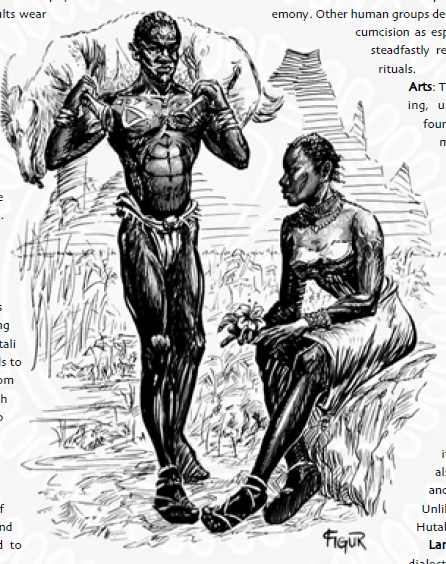
Hutali: The Hutali people have no nation per se, being semi-nomadic people living among the Giko Taaba mountain range and ruled over by the utuchekulu (detailed later). Their society encourages non-confrontational means of avoiding conflict, with many forms of laws taking the form compromises, and they go out of their way to avoid offending others. The only exception in regards to this is their practice of both male and female circumcision for coming of age ceremonies. Most other humans regard the latter to be cruel, but the Hutali steadfastly refuse to give this up.
They are nominally under the dominion of the Empire of Nibomay but do not recognize its authority; their traditional lands are close to inhospitable volcanoes, which makes enforcement more trouble than it’s worth. Their personal possessions are made to be easily carried, with goats a popular animal for raising. Hutali carry the skulls of the dearly departed to keep their ancestors close when communities travel, with said skulls housed in round wooden boxes. Those unable to produce children are regarded as having led worthless lives, and their bodies are instead tossed into volcanoes.
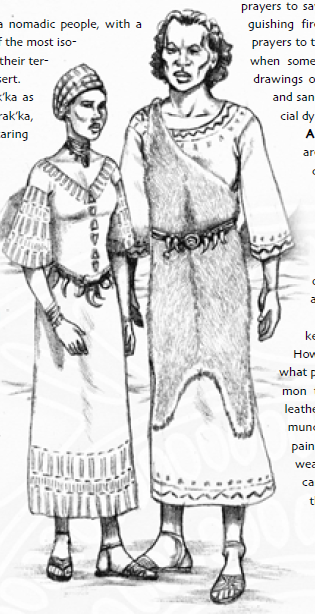
Marak’ka: The Marak’ka are another nomadic group, primarily living in the Gudu Ji Pingu Desert. They are the opposite of reserved, being encouraged to express their emotions in song, dance, and artwork, with percussive instruments being the most popular. Divine spellcasting bards known as ngnoma serve as community elders, and what few personal belongings they have are decorated with paint and beadwork once they gain enough sentimental value over time. The Marak’ka have a non-interference policy with other cultures, not going out of their way to make friends or enemies. The exceptions are the Xon’mo of Basharka who they regard as kin, and resent the Empire of Nibomay who claims dominion over the Gudu Ji Pingu Desert.
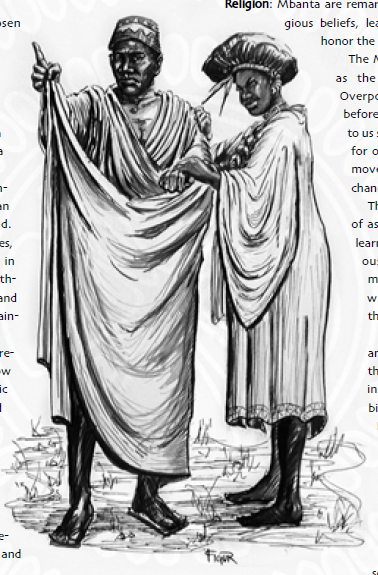
Mbanta: The Mbanta are the only human ethnicity without a homeland or nation to call their own. They used to live on an island in the southern sea, but a massive earthquake in the Middle Ages rent it asunder and forced the survivors onto the mainland. They are often stereotyped as being highly skilled with magic and strange powers, an impression they do not go out of their way to discourage. They are evenly spread out over Nyambe-tanda, deferring to the dominant laws but retaining their own cultural elements. They incorporate magical spells to enhance their cooking which places Mbanta chefs in high demand among royalty. The Mbanta are known for using complex astrological calendars they claimed to have learned from an aquatic undersea race, and they are remarkably secretive about their religious practices. What few things outsides known is that they greet the rising sun as the physical manifestation of the Overpower, kneeling before it and crying “Nyambe shall return to us someday!”
Regarding their magical reputation, the book notes that if psionics are in use that most Mbanta will be the Psion class. Which is interesting, in that none of the other races or ethnicities have a similar statement. Not to mention most of their population will be a bonafide PC class; 3rd Edition D&D has most NPCs 1st-level Commoners by population demographics. Although brought up briefly in the following chapter, the few mentions of psionics in this book are obviously artificially tacked on: there’s no mention of how it would fall into Nyambe’s cosmology, whether it is a form of magic or something entirely foreign.
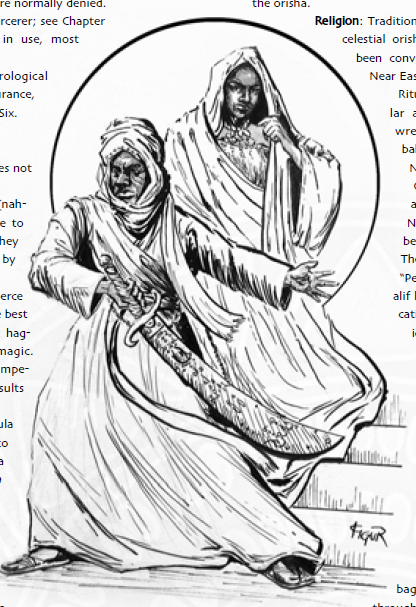
NaBula: The NaBula are native to northeastern Nyambe-tanda, concentrated in the Caliphate of Boroko. Their culture has been heavily influenced by the Near Easterners, ranging from their dress and their undefined religion to even being the only Nyamban people to employ horses in warfare. Ritualized wrestling known as Nuba is a popular sport, and many practitioners are no pushovers when it comes to actual combat. Some have even visited the nearby Kaya Vua Samaki to compete and learn from Far Eastern martial artists.
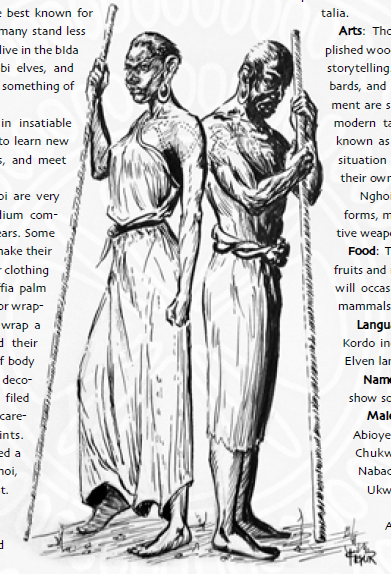
Nghoi: Natives of the bIda Rainforest, the Nghoi are best known for being allies of the wakyambi as well as being short, usually 4 feet or less. They are fans of body modification, from ritual scarring and body painting to filing their front teeth as a sign of valor among their warriors. They are highly decentralized, recognizing no higher authority than the elders of individual families, and their propensity for storytelling produces a high number of bards. A popular kind of story is known as a dilemma tale, where the narrator creates a situation and asks the listeners to come up with their own endings.
Game-stat wise Nghoi are humans, but most have the Small Stature as their racial bonus feat to grant them Small size.
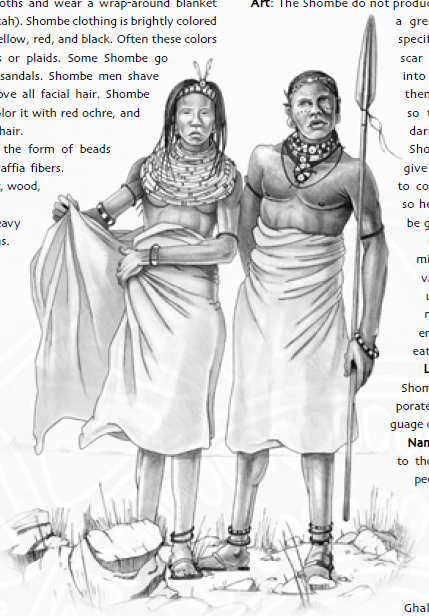
Shombe: The Shombe are cattler-herders who live among the tUbi Grassland to the west of Taumau-Boha, and are known for counting the best warriors of Nyambe-tanda among their number. They relish this perception, preferring to use spears and melee weapons over ranged combat which they regard as cowardly. They have fought the entare (centauresque lion-like humanoids) for generations over cattle and territory, and their rite-of-passage into adulthood involves the hunting, slaying, skinning of a monster of the Beast or Magical Beast type. In 3.0 terms the Beast type meant either a dinosaur or fantastical animal-like creature that does not exist in real life, which means that Shombe teenagers are extra hardcore. Cattle is vital to their society, used for meat and milk for sustenance and their skin and bones fashioned into household items. Shombe live in temporary enclosures known as kraal, whose natural fence is made of thorn bushes for an effective defense.
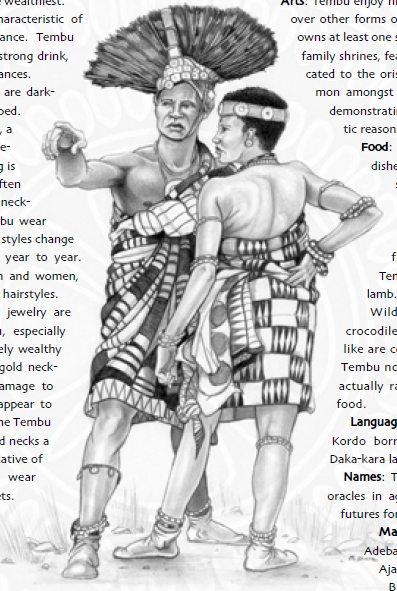
Tembu: The Tembu hail from the Empire of Mabwe, whose central position on the continent means that they are one of the most widespread people barring the Mbanta nomads. The wealth of their nation provides a high standard of living for the populace, and even common-born citizens sport jewelry. Their domesticated elephants are one of the most feared sights of their enemies, with howdah-bound archers raining sharp death on those their war beasts’ tusks cannot reach. Most honor the celestial orisha, the average home containing a family shrine bearing a magical statue known as a nkisi n’kondi (nail figure). When one wishes to swear an oath or seal a contract, the guest hammers a nail into the statue. Mabwe’s nobility is known for peculiar practices such as women with layers of gold necklaces which elongate their necks, or the raising wild animals not normally eaten such as fried baby crocodiles and monkey brains.
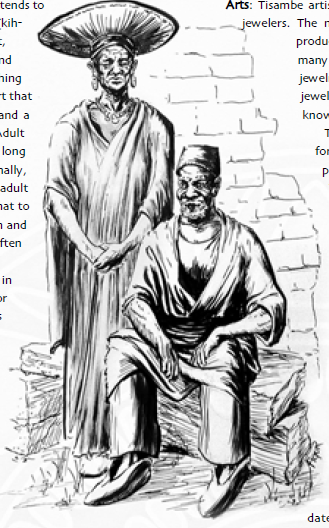
Tisambe: The Tisambe are one of the oldest continual ethnic groups of Nyambe-tanda. They are strongly connected to the Empire of Nibomay, and are the only society which is matriarchal in nature. Women hold the reigns of business and government as well as serving in the army. Their elite Amazon units fight with signature greatbows and razor swords, the latter banned from ownership by commoners. The Tisambe’s proud history bestows in them a sense of arrogant patriotism, and they tend to look down on other cultures. Their weddings are religious in nature, sometimes planned years in advance with celebrations lasting up to a week.
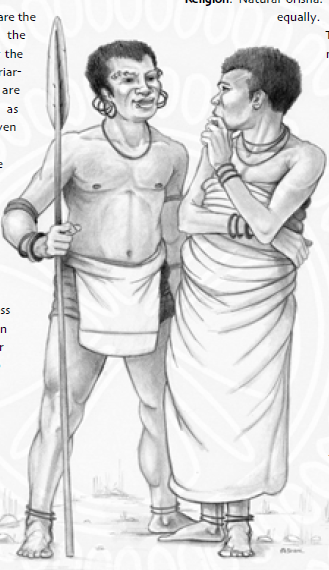
Tuslan: The Tuslan are a minority group within the Empire of Nibomay, organized into seven major clans sharing a common ancestor. Due to strong cultural taboos against iron they hunt and fight with wooden and stone weapons, and are renowned for producing expert hunters and scouts. While marriage ceremonies exist, there is little taboo in divorce or for one to desire finding a new partner, even as frequently as every year. They honor all orisha connected to the natural world equally, and offer up a prayer to the spirits of any animals they kill. For this very reason they almost never hunt animals for sport.
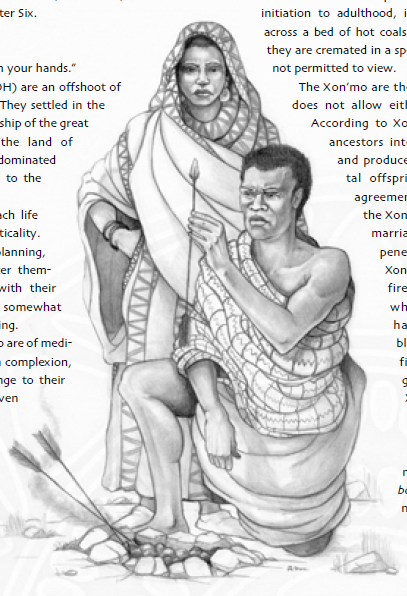
Xon’mo: The Xon-mo are related to the Marak’ka people, primarily living in the kingdom of Bashar’ka on the continent’s far west. Their society is ruled over by a theocracy of fire worshipers who provide protection and land to the common folk reinforced by oaths of fealty. This is not a one-way street, for Xon’mo rulers who grow lax in their duties find armed revolt a distinct possibility. Xon’mo are known for employing alchemist’s fire in warfare, and their merchants sell exquisite textiles all over Nyambe. They are also the only culture which enforces monogamy. This is said to be the result of an ancient pact with fire elementals to avoid plural marriages, and in exchange the elementals bred with mortals.* Xon’mo born with bright red hair are said to have the “fire blood,” a sign of great honor.
The Fire Blood feat in a later chapter will reveal that said elementals were actually efreeti.
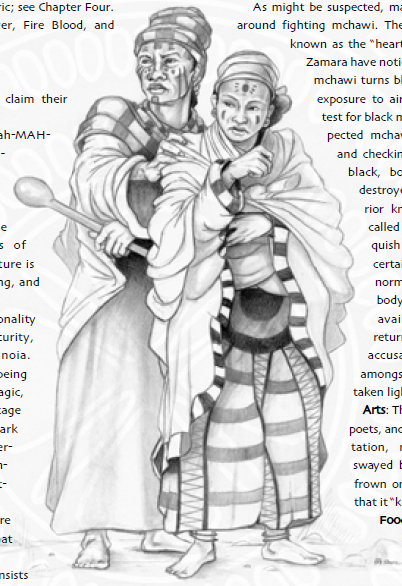
Zamara: The Zamara get a bad rap among other Nyambans. Their people were the backbone of the Zombi cults and later empire of the same name, and produce more mchawi wizards among their number than any others. But in spite of, or perhaps because of this, the Zamara hate arcane magic more than any other culture. Even the sorcerous sei are not immune to witch-hunts. Zamara are native to the Kaya Vua Samaki region, and their close proximity to Far Eastern traders makes various “eastern” weapons and equipment more common among their number than elsewhere in Nyambe.
As much as they’re associated with black magic, the Zamara have an order of warriors known as Magic Eaters. The “heart test” is a lethal trial by witch a suspected mchawi’s heart is ripped out. If their heart turns black after a few seconds of exposure to air then this confirms their guilt. If the heart is normal, it is returned to the body and a cleric with knowledge of resurrection magic is called for to return them to life if one is available in the region. This is not a mere “floats in water” superstition; mchawi hearts really do turn black as a result of unholy pacts subtly altering their bodies.
Demihuman Races
What separates a “demihuman” from other non-human beings is their ability to peacefully coexist with humans. Technically this means that races other than those listed here can qualify, but the six below are the most common in Nyambe.
Perhaps one of the setting’s most controversial aspects, the new races are technically subraces of existing Player’s Handbook options and are presumed to share (distant) lineage with their more Tolkien fantasy counterparts. The unthlatu are perhaps the only “new” race here, and some of the criticism I recall is that Nyambe did not have more “original” African-flavored playable folkloric beings.
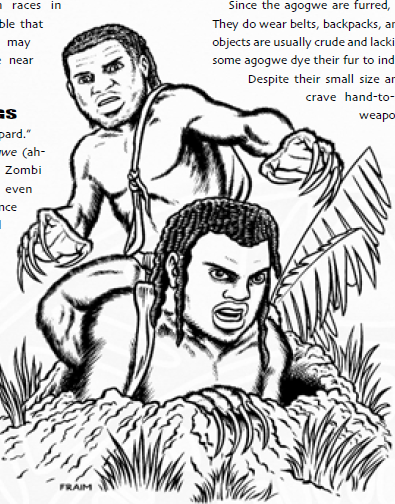
Agogwe Halflings: These short, isolated people mostly live in the bIda Rainforest, maintaining good relations with the wakyambi and Nghoi. They look like short humans with long claws capable of burrowing through the earth, and live in nomadic family units inhabiting dug-out underground shelters.
Stat-wise they are much like Halflings, save they have natural weapon claws that deal 1d4 damage, a burrow speed of 10 feet in soft earth, and can cast Speak With Animals once per day in regards to burrowing animals only.
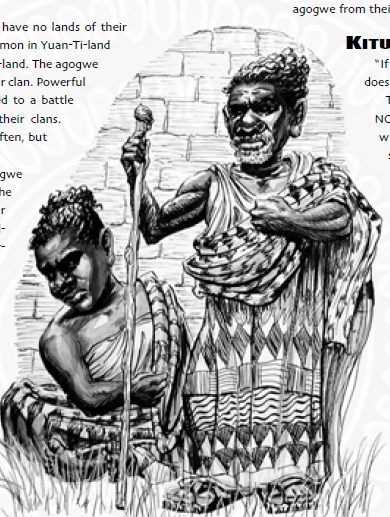
Kitunusi Gnomes: The Kitunusi have a magical bond to shadow and darkness, and their society discourages any displays of emotion in public. Outsiders find their quiet nature disturbing, and their ancestral homes were deep underground much like the utuchekulu. Every kitunusi has a personal kente-cloth tabard which act as a symbol of rank and honor. As such they will go to great ends to recover a stolen or lost one, even those not personally belonging to them. Most kitunusi live in their own nation of Mademba, ruled over by a labyrinthine bureaucracy intentionally designed to be opaque to most people. They’re also the only culture on Nyambe which does not produce any form of artwork besides their notable kente cloth, and their only form of cuisine is a thick gruel made of grains they simply call “food.”
Statwise they are similar to Gnomes, but can cast the Darkness spell once per day, have darkvision out to 60 feet, possess Spell Resistance against divination spells which increases with level, and others attempting to use Sense Motive on them suffer a -4 penalty.
Link instead of image due to bare breasts
Ngoloko Half-Orcs: Technically speaking the ngoloko are not half-orcs so much as a race of their own with kosan heritage. Whereas the kosans were slaughtered almost to the last number by their slaves, the ngoloko were half-orc children born to human female concubines and therefore ruled innocent of any wrongdoing. Instead of death they were met with exile, forming their own communities. The ngoloko are self-conscious of their legacy and tend to wear heavy, concealing clothes when among others. In spite of attempts at reconciliation, separatists which formed their own militarized communities on the Isle of Shadow led to new rashes of xenophobia. Ngoloko society is the only major culture with democratic forms of government, where chieftains are chosen via public elections of seven year terms and forbidden to run for office again afterwards.
Stat-wise they are half-orcs. No real changes from the PHB standard besides having Mchawi as their favored class and -2 to Wisdom rather than Intelligence.
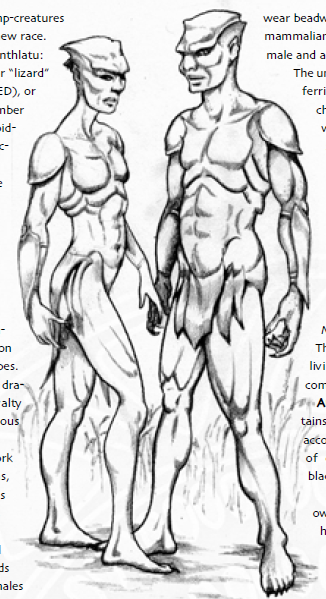
Unthlatu Dragons: When disguised dragons mated with slaves of the Kosa Empire, the sorcerous sei came into being. A group of human sorcerers exiled to the Great Mangrove Marsh inbred with themselves and some reptilian swamp-creatures to the point that their more draconic features grew apparent. They are introverted and are pretty much Futurama’s Neutral Planet: they have neutral relations with other cultures and are solidly True Neutral in alignment. They bear some resemblance to humans, save that they have scales covering their skin matching the color of true dragons, and possess no body hair of any sort.
Statwise they have +2 Strength, -2 Dexterity, -2 Wisdom, a slow 20 foot base speed, 60 feet of darkvision, +1 natural armor and 1d4 natural claw and bite attacks, immunity to sleep and paralysis, and suffer -2 penalty on all skill checks due to poor education and little parental supervision. But their most notable feature is their Dragon Heritage, where they select a single true dragon type from which they derive their ancestry. It determines the specifics of their Breath Weapon and Energy Resistant racial feats if and when they’re taken.
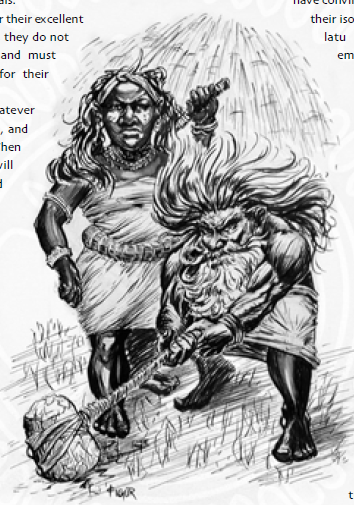
Utuchekulu Dwarves: Utuchekulu once lived underground, but they and the kitunusi were driven to the surface from a volcanic eruption. They are primarily split into two regions; the ones in Nyambe’s Kuba Taaba eastern mountains are allied with the Empire of Mabwe, while those in the western Giko Taaba mountains distantly rule over the Hutali humans. They are dour and gruff like other dwarves, and dye their teeth blood-red with berries. One such tooth is capable of growing long enough to be a veritable weapon. The utuchekulu are ruled over by absolute dictators who are regularly overthrown by coups every couple of decades which leads to a rather unstable system of government. They are not automatically evil, but practice some immoral traditions such as honoring fiendish orisha (out of respect if not agreement) and non-consensual ritual cannibalism where they feast upon the flesh of fallen warriors in the belief that this will keep their ghosts from returning to enact vengeance.
Stat-wise they are dwarves but gain a 1d6 natural bite attack. They do not begin play speaking Kordo, the “common tongue” of Nyambe, and must purchase it as a bonus language which can be awkward for some PC parties.
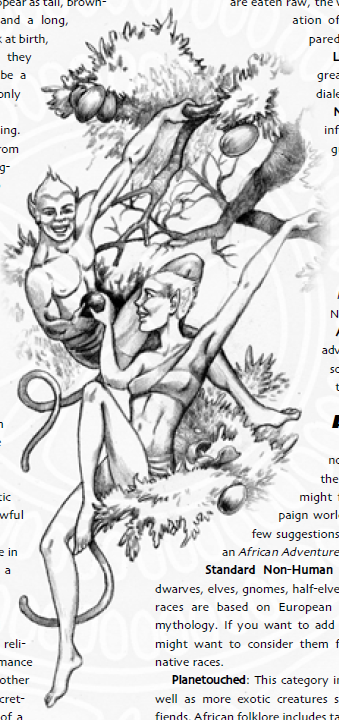
Wakyambi Elves: Our final entry, the wakyambi were once the favored slaves of the Kosans. When they too rose up, they sought to shed the stigma of traitors by expressing even more hatred than usual against ngoloko and other creatures with orcish ties. But otherwise they are benevolent and nurturing, sometimes to an annoying extent in patronizing others of failures. Wakyambi appear as humans with pointed ears and fleshy tails, and their black hair gradually turns white as they approach adulthood. They have a knack for climbing in trees and make their homes among the treetops of the bIda Rainforest. One of their religious traditions involves anonymous gift-giving, where they may covertly slip some of their own cattle into a human farmer’s herd or leave a pouch of coins where a beggar may find it.
Stati-wise they are much like elves, save they do not gain immunity to sleep spells and instead have a Climb speed of 20 feet (along with a +8 bonus on Climb checks). Like utuchekulu they must learn Kordo as a bonus language.
Alternate Races
Our final very short entry talks about other non-human races in the core rules and their place (or lack thereof) in Nyambe. For one, the standard 6 non-human PHB races would be foreign immigrants if they do show up at all, while bugbears, kobolds, orcs, goblins, and hobgoblins similarly restricted. Planetouched, on the other hand, are people possessed by spirits while still in the womb and born with supernatural powers. There is no distinction between aasimars and tieflings or even half-celestials and half-fiends, all collectively referred to as n’kaa.
Additionally, this was touched upon back in Chapter One but I wanted to detail it here on account that the human ethnicities and demihumans were listed alongside them in the introduction. The Savage Races of Nyambe are self-centered and evil humanoids who are impossible for others to peacefully coexist with in any reasonable fashion. The below list is by far not exhaustive, but evil humanoids not listed here tend to be far smaller in number and thus more secretive. The most well-known savage races include:
Entare: centaur-like lion people of the tUbi grassland who live in an honorable and organized Klingon-like fashion.
Getiet: deformed and stupid kosan descendants who operate as bandits across the continent.
Ingogo: smaller, weaker, and more primate-like kosan descendants who are the most hated of all the savage races for their propensity at throwing their own highly-diseased feces at people.
Kosans: this ancient race of ur-orcs possessed great arcane power and once ruled over all of Nyambe-tanda and lands beyond. They are (canonically) extinct in the present setting.
MbUi: Gnolls, need i say more?
Silwane-Manzi: shark-like amphibious cousins of sahuagin who live in sunken ruins off Nyambe’s northern coast.
Yuan-Ti: Far Eastern immigrants setting up shop in the western bIda Rainforest, searching for the remains of an ancestral civilization.
Thoughts So Far: I do like the in-depth look at the various ethnic groups and demihuman races. The six new demihumans felt distinct enough mechanicswise but a bit too close to their PHB counterparts; the unthlatu is the only real novel edition. Due to being 3.0 races they are underpowered by more modern Pathfinder standards.
Join us next time as we cover the Core Classes of Chapter Four!
Core Classes
Original SA post
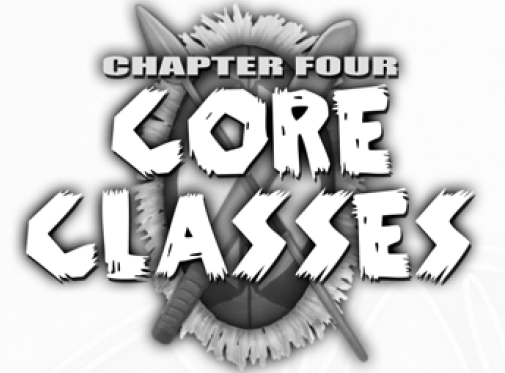
Nyambe takes a different approach than most 3rd Edition D&D settings. For one, the Player’s Handbook classes are not native to the setting with a few exceptions, usually originating among one of the three foreign groups: Northerners, Near Easterners, or Far Easterners, with only the Cleric, Fighter, and Monk common to indigenous Nyambans to any degree due to cultural contact with the latter two groups. Psions and Psychic Warriors, who are not “core,” tend to either be Far Eastern foreigners and Zamaran disciples or developed among the Mbanta. And no, we do not have an explanation for what psionics is other than “weird foreign magic.”
Instead, Nyambe has five core classes of its own design, mapping out evenly to the warrior/thief/priest/mage classic schematic, with the fifth a variant “mage.” A few of the PHB classes, such as the bard, monk, and ranger, have become Prestige Classes of their own. So technically speaking the Barbarian and Paladin classes are the only two you cannot replicate using Nyambe’s new choices. Overall this entire system feels unnecessary when the base rule options already give you all this and more. Nowadays we’d make such options alternate class features in Pathfinder.
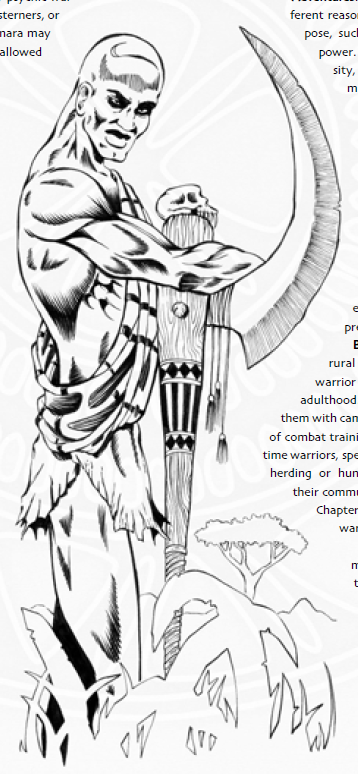
Gamba Fighter: The gamba is a rural village warrior who are either part-time warriors with little formal training or join proper warrior societies. As standing armies are an overall rarity in Nyambe, most gamba spend a majority of their lives hunting, herding, or farming, taking up arms only in times of war.
They are basically the Fighter class, but they trade in 4 of their 11 bonus feats for Fast Movement and the Barbarian’s Damage Reduction progression, and have a d12 Hit Die and more skill points. Nothing really spectacular.
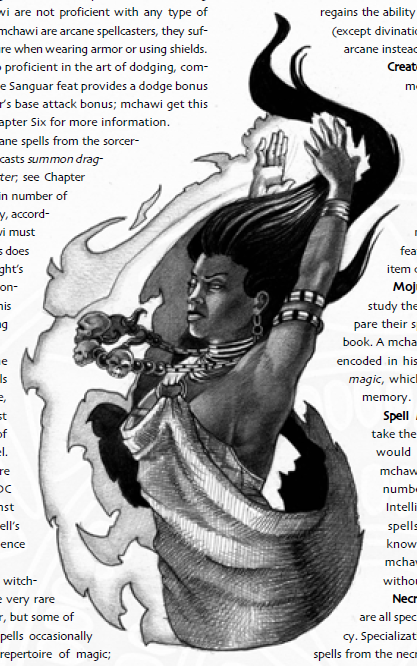
Mchawi Wizard: One of the two arcane casters of the setting, the mchawi are effectively ur-priest wizards who learned how to steal magic from the Overpower by selling their immortal souls to fiendish orisha. As such they cannot be of good alignment, and most are neutral evil on account that the fiendish orisha have a vested interest in making the world a worse place and don’t choose their bargains lightly.
They are much like Wizards, but with some deception and trickery-based class skills like Disguise, Escape Artist, and Intimidate. Instead of using spellbooks they prepare spells by making use of magical trinkets carried in what is known as a mojuba bag. They are also all specialists in Necromancy and can prepare extra spells from that school, but are forever barred from learning or casting Divination spells. At 2nd level they can summon a Fiendish Servant like a blackguard, and at 5th level their souls are damned such that if they die they automatically reincarnate into a barozi animal (evil spellcasting animal template), but cannot be truly resurrected into their “base form” by any other means.
I like this class; although the barozi animal death opens up various balance concerns, it is a good example of setting fluff and crunch melding together to create something truly unique.
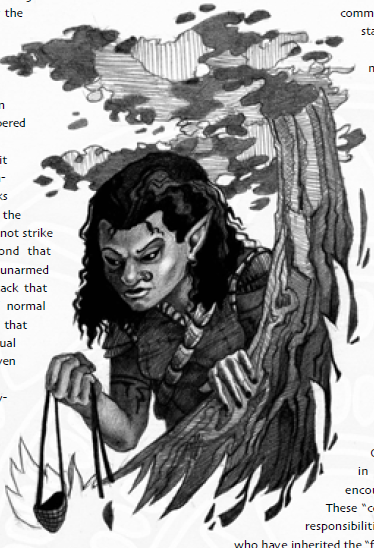
Nanala Rogue: This is the rogue class, and is just as broad for all manner of occupations relying upon deception and stealth. What makes them different than PHB Rogues is that Sneak Attack is their only fixed class feature; at 1st and every even numbered level they get bonus feats for Roguelike choices such as Dodge and Point Blank Shot, or they can “buy” iconic class features such as Evasion or Trapfinding.
Being 3.0 the bonus feat list is not very impressive, but overall I love the concept of a custom-built mix-and-match Rogue class.
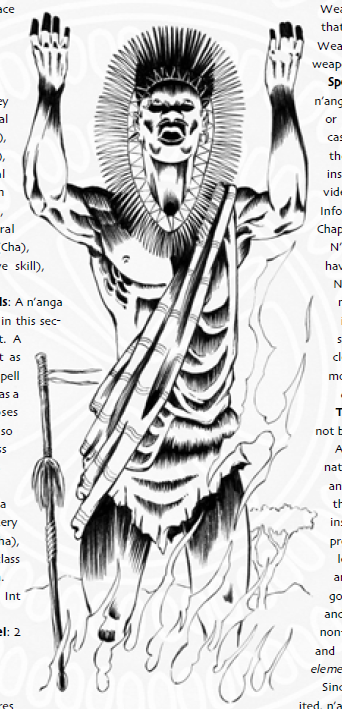
N’anga Cleric: This represents all manner of religious functionaries of Nyamban society; although anyone can honor the orisha, the n’anga devote their whole lives to serving as their emissaries in the mortal world. They can cast spells of up to 9th level, but derive spells from either the cleric or druid spell list depending on their patron orisha, or an orisha towards which they dedicate special veneration. They are otherwise clerics, choosing two domains related to their patron orisha and all that entails. There’s also a flavor effect of when they prepare for spells as their honored orisha possesses their body; a n’anga who undergoes this is known as a “farasi,” or horse, as the orisha is taking control of their physical functions. Technically speaking the player still retains full control of their PC, but they take on personality traits and motivations of said orisha and may do things like stand in the sun for minutes if a plant orisha, be polite and charitable to everyone they meet if a celestial orisha, etc.
Finally, n’anga gain unique special abilities based upon their worshiped orisha, most of which correspond to existing PHB class features: an Animal Orisha grants druidic wildshape, Ancestor Orisha gain bonus feats, Celestial/Fiendish Orisha may turn/rebuke undead, etc. The ones which I’d describe as “new” in a 3rd Edition context include shapechanging into an elemental form for Elemental Orisha or casting Tree Shape and gaining some permanent plant immunities for Plant Orisha.
The n’anga is a Swiss Army Knife of non-paladin divine spellcasters, and I like its versatility. It also handles the whole superfluousness of Clerics of nature deities and how they’re different from Druids in standard D&D by making them one and the same.
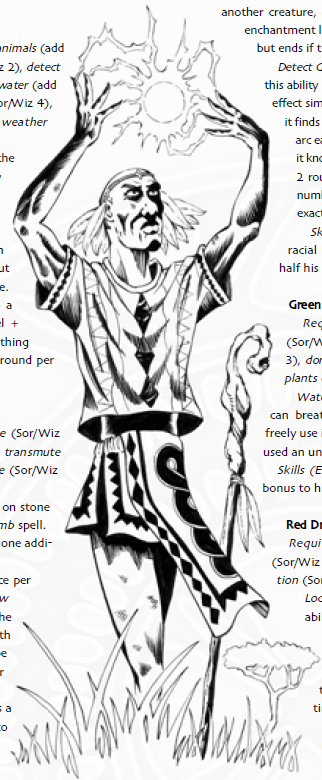
Sei Sorcerer: The sei are effectively sorcerers, although they have an explicitly draconic origin rather than more generic supernatural bloodlines. Although instrumental in overthrowing the Kosan Empire, the sei’s association with arcane magic makes them controversial in Nyamban society. As to why, it is unknown whether the Overpower approves or disapproves of the sorcerer’s loophole in accessing arcane magic.
They are PHB sorcerers, but get more class features depending upon their primary draconic heritage. They must learn a set of thematic spells as soon as they can qualify for a new heritage feature at certain levels, but in exchange they gain some of the abilities of true dragons. For example, a black dragon-blooded sei can breathe underwater indefinitely, a brass dragon-blooded can summon a djinni once per day, a gold dragon-blooded can imbue gems with good luck, etc. They tend to be more utility than directly offensive or defensive, but a few are clearly better or worse options than others. The green dragon-blooded gets water breathing and an underwhelming bonus to Climb skills equal to their class level both at 1st level, whereas a silver dragon-blooded can breathe a cone of paralyzing gas once per day at 10th level. The DC for sei abilities is 10 + their Charisma bonus + their class level, which is leagues better than the D20 default of 10 + Charisma + half your Hit Dice/class level, meaning that the aforementioned paralyzing gas can be very effective.
Finally Sei are a special case; due to being an inherited condition one cannot multiclass into it unless the character is unthlatu or the GM makes a special story exception for latent dragon blood.
Thoughts So Far: Back in the 3.0 days I could see several of the base classes as visible improvements, notably the Rogue and Sorcerer, and the mchawi wizard is my favorite mostly due to thematic reasons. However, in more modern 3rd Edition and Pathfinder games they’d feel artificially limiting. The magical classes are all full 9-level casters which makes them strong options, whereas the gamba and nanala have no magic and so are batting around their PHB counterparts.
Join us next time as we cover Nyambe’s Prestige Classes in Chapter Five!
Prestige Classes
Original SA post
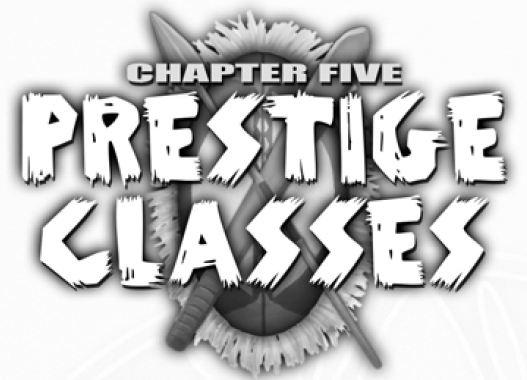
In Nyambe-tanda, Prestige Classes are a cut above the common crop, associated with specific organizations and special trainers to separate them from the more general and self-taught core classes. We first start off with looking at what existing PrCs can convert to Nyambe, and given this is 3.0 won’t include such vaunted options as the Archmage, Arcane Trickster, and so on. Arcane Archers are renamed Arcane Shongo, unthaltu warrior societies who specialize in throwing blades. The Assassin’s arcane magic association makes them explicitly tied to the Kosans and their descendants. Dwarven defenders are found among the utuchekulu and are not proficient with heavy armor, and Shadowdancers are limited to the kitunusi. Loremasters are those renowned for being repositories of generations’ worth of knowledge, and they are most common among women in Nibomay on account of being the oldest surviving Nyamban civilization.
A peculiar thing about Nyambe’s Prestige Classes is that they all have their own spellcasting progression rather than adding effective caster levels to the existing base class. In most cases this is a bad option mechanically as it stunts a character’s spellcasting progression, but a few of the ones in this book go all the way up to 9th-level spells in a 10-level PrC. This is a bit weak early on, but at mid-higher levels is on par with other primary casters and include the Mganga, Soroko, and Zombi Cultist. The other classes go up to 5th or 6th-level spells, with the exception of the Dembe who goes up to 4th-level much like the Ranger.
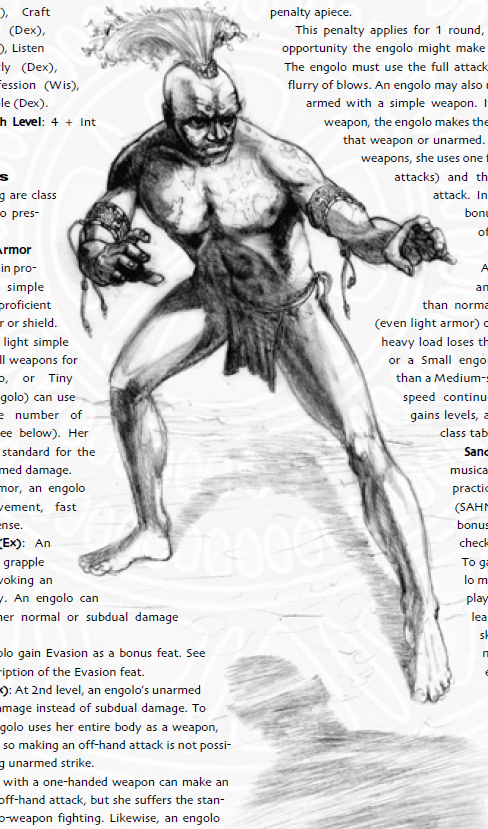
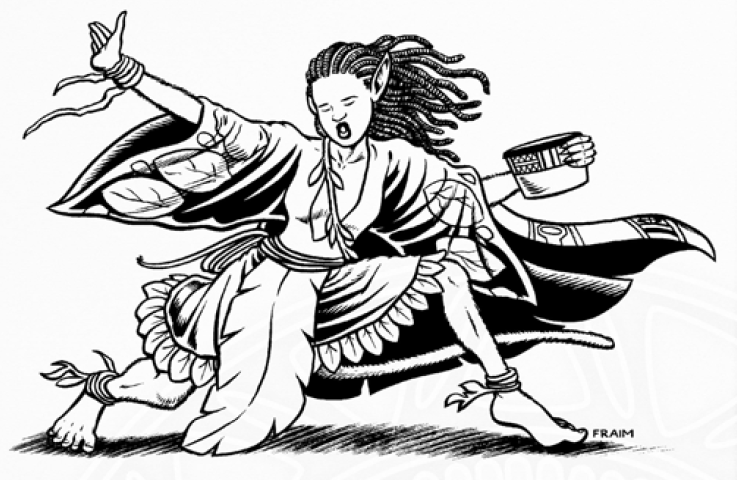
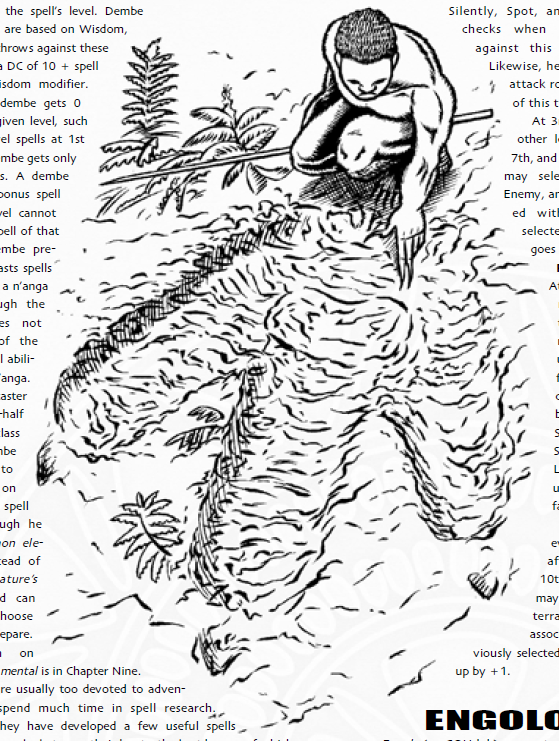
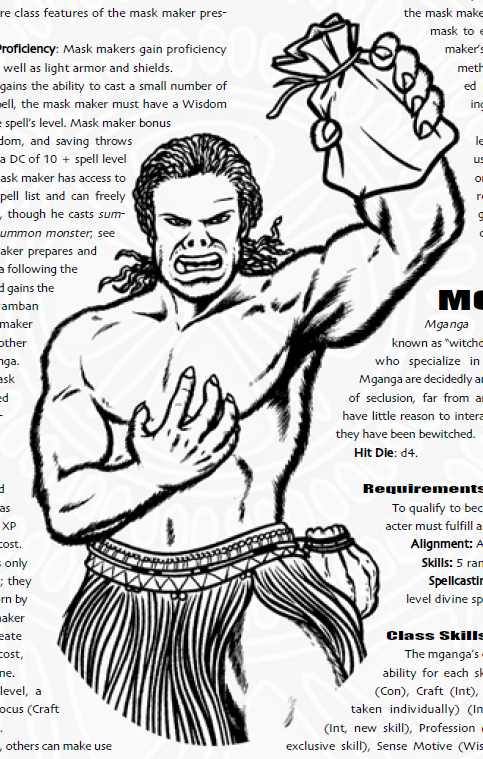
Dembe, Engolo, Mganga, and Ngoma: I’m grouping these four prestige classes together on account that they are “prestige” versions of existing D&D core classes and do not noticeably differ from them save in a few areas. Dembe are rangers, members of monster-hunting societies. In addition to favored enemies they also gain Favored Terrain granting them bonuses on skill checks in certain areas, a concept which standard 3.X would not see until the advent of Pathfinder. Engolo are ritualized wrestlers whose traditions originated among the NaBula people, and their AC bonus increase only triggers when someone is playing a percussion instrument nearby. Engolo also become immune to all forms of nonlethal damage as a capstone 10th level ability. The Mganga are witch-doctors who specialize in fighting evil magic, but statwise they cast spells from the wizard spell list which are treated as divine instead of arcane magic and gain familiars instead of fiendish servants. Finally, the Ngoma are divine bards who invoke the powers of the orisha through dance, music, and/or poetry. Their bardic knowledge is reflavored as secrets the orisha whisper to them.
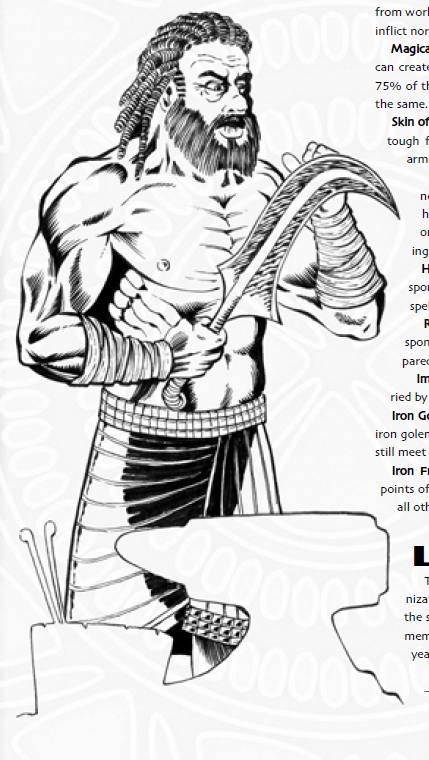
Inyanga Yensimbi: Known as “doctors of iron” in the Kordo language, these artisans possess a supernatural knack for working with this holy metal. They are a 5-level PrC which needs the Craft Magic Arms and Armor feat to quality and 5 ranks in related Craft skills, so they’re easy to enter. They can cast cleric spells of up to 5th level, and most of their class features are background or downtime related: +10 bonus to crafting non-magical iron items, reduced XP cost for crafting magic iron arms and armor, and learning how to craft an iron golem cheaper than usual as their capstone ability. Some of their more ‘active’ class features include their skin toughening up to be a natural weapon and natural armor bonus or the ability to spontaneously convert spell slots to heat metal or rusting grasp spells.
Overall this class is too situational and weak for most adventuring parties.
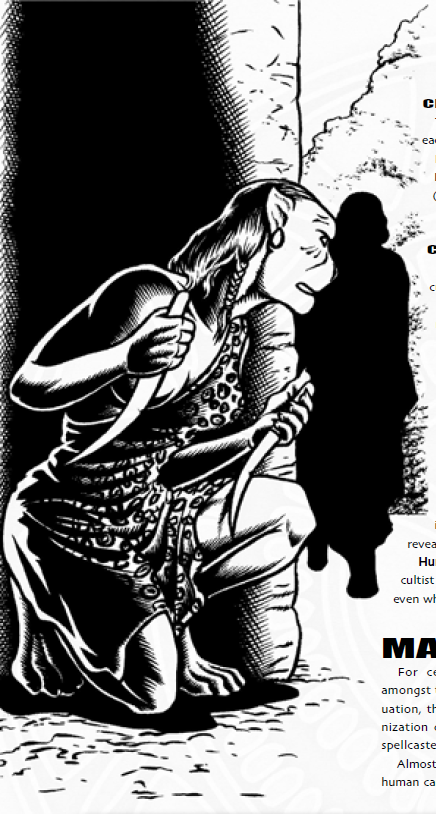
Leapord Cultist: The Leopard Cult originated as an anti-immigrant group in Kaya Vua Samaki seeking to drive Far Easterners off of their shores. Over time they became compromised by real wereleopards to the point that they’re now a fiendish cult operating like an organized crime syndicate. The prerequisites are easy: 1 rank in Control Shape and must be a wereleopard. Their 5 levels have a host of useful abilities, from retaining full intelligence and memory in any shapechanged form, enhanced natural attack damage, immunity to spells which reveal their true form, and Damage Reduction 15 as their 5th level capstone ability which can only be overcome by animal horns and weapons made from such material.
Overall a strong class, but since wereleopards are evil this is not exactly PC-appropriate.
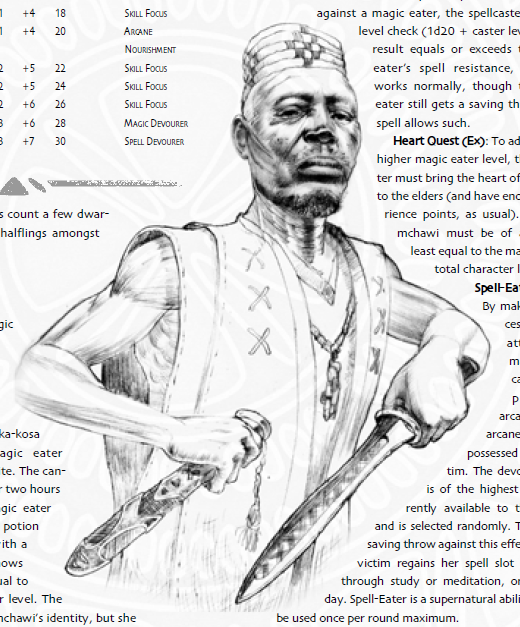
Magic-Eater: The magic-eaters are part of an organization dedicated to the eradication of all arcane spellcasters in the Kaya Vua Samaki region, both mchawi and sei. They are a rather humanocentric organization, dismissing demihumans automatically save in a rare few situations. In order to gain their first level and further levels in the PrC, a Magic Eater must undergo a ritual vision where they learn the location of a powerful mchawi. They must kill this spellcaster and bring back their hearts to an elder in the organization.
In exchange, the Magic-Eater is a martial class with no spellcasting ability, and gain a very high Spell Resistance (10 + twice their PrC level) against arcane magic and spell-like abilities. Their signature ability is to “eat magic” with a touch attack: initially this takes the form of automatically making a target lose their highest-level spell slot, but can be used to auto-cancel spells affecting the target (positive or negative) and regain hit points for every spell the Magic Eater “eats.” At 9th level they can cast mage’s disjunction on arcane magic items (permanently render them nonmagical), and their 10th-level capstone lets them “eat” 1d4+1 spell slots at a time.
Overall a pretty strong class for a noncaster, although their organization’s anti-arcane nature means that you better not have a sei or mchawi in your party if you want to join.
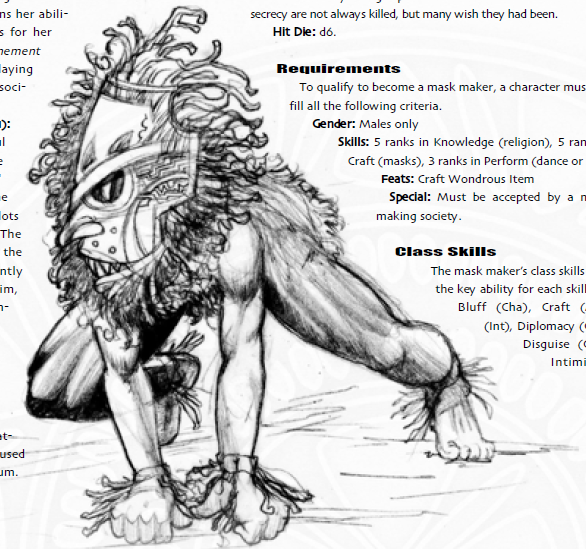
Mask Maker: Not any one organization per se, mask-making societies are popular all over the continent. They are fraternal male-only orders who build magical masks with which a spirit can be channeled. In some areas they rule over communities as a form of shadow government, using their masks to adopt alternate identities.
The Mask-Maker is a 5-level PrC and can cast spells from the cleric list of up to 5th level. Their special abilities are much like the doctor of iron, being able to craft masks with less GP and XP cost and gain Skill Focus (Craft-Masks) as a bonus feat. Their later-level abilities include the ability to permanently meld a mask into their face, effectively wearing it as a slotless item and are able to bestow this upon others as the capstone ability.
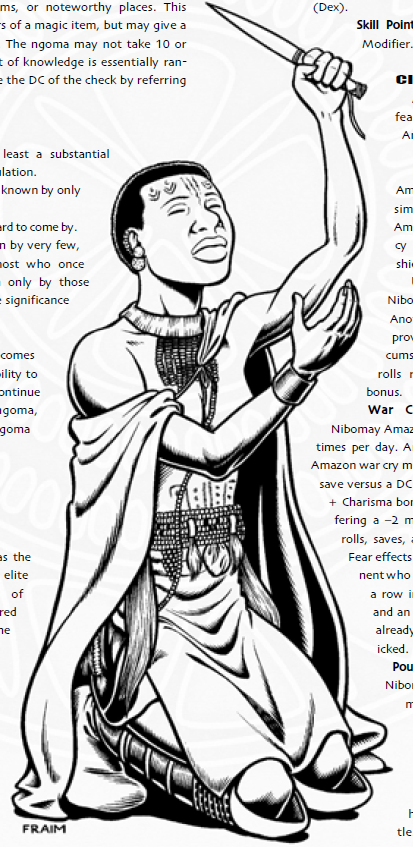
Nibomay Amazon: One of the iconic martial traditions, the Amazons are called the Ahosi among their own and perhaps the most famous warrior society in Nyambe. They only accept women, but the prerequisites are otherwise lax requiring Exotic Weapon Proficiency in their two signature weapons: the greatbow and razor sword. They are a noncasting martial class with a host of good abilities: increased aid another bonuses, an at-will AoE fear-generating war cry, the abililty to move their normal speed and full attack on the first round of combat, and can accept temporary ability score damage to Charisma via ritual scarring and gain an equivalent bonus to one of their physical ability scores. Their later level abilities include more miscellaneous utility effects, such as casting true strike 3 times per day and granting their greatbows and razor swords the equivalent of the vorpal weapon quality: insta-kill on a critical hit.
The ritual scarring is great for self-buffing, but I cannot understate how amazing it is in 3rd Edition to full attack and move. Traditionally, characters could only make multiple attacks per round if they moved no more than a 5 foot step or managed to down an opponent with Cleave. Pounce is traditionally a monster-specific ability, but when you can move 30 to 60 feet and make 2 to 5 attacks it really opens up mobility options for martial characters.
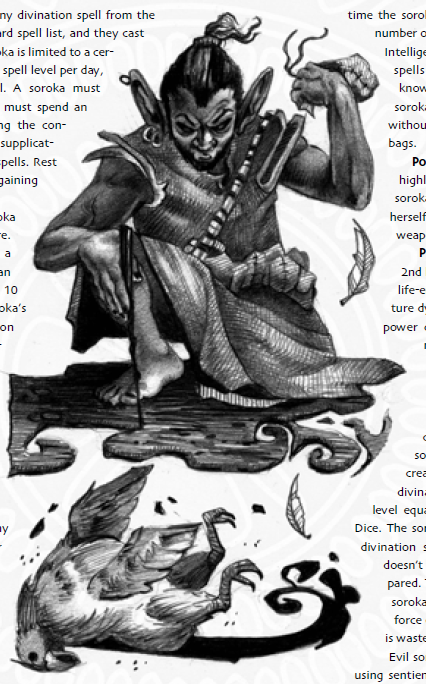
Soroka: Commonly known as poison oracles, soroka are spellcasters who enhance their divination spells via analyzing the death throes of a poisoned animal, seeing ominous portents in their seemingly random spasms. Unlike standard D&D, poison use in Nyambe is not inherently evil and the soroka find their talents in high demand.
Although they are a primary caster, they have a whopping d12 hit die and can learn any spell from the cleric, druid, or sorcerer/wizard list provided it is of the divination school. They use mojuba bags but are divine casters. Their trademark feature is Poison Divination, where if a creature within 30 feet dies from poison they can absorb its energy to cast a divination spell without wasting a spell slot. This can even apply this to spells they do not have prepared, but is otherwise limited by level based on the killed creature’s hit dice (total HD divided by 2, round down). However, you must limit your sacrifices to non-sentient monsters if you’re not of evil alignment.
The soroka’s other features are minor, relating to crafting poisons without needing raw materials (but time and Craft checks still apply), gain immunity to poison and poison weapons without accidentally poisoning yourself, etc.
This PrC is one I like, for it both naturally fits within the setting lore and is a potent class option. One of poison’s largest drawbacks in 3rd Edition was its expense, costing hundreds or thousands of gold pieces per dose. Although restrictive, the ability to potentially gain infinite casting of divination spells under proper circumstances really opens up utility options for adventuring parties.
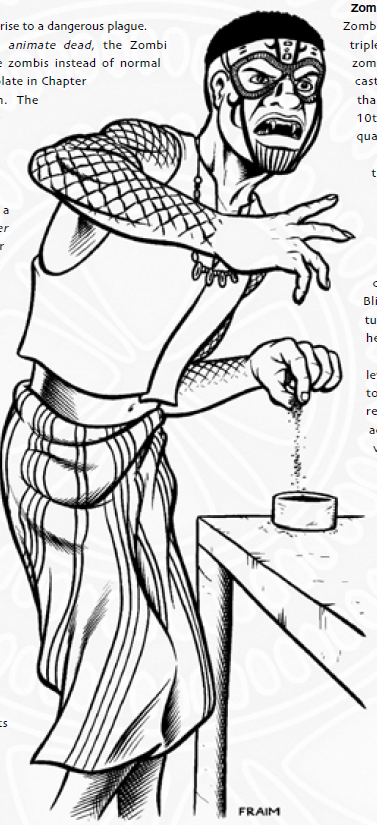
Zombi Cultist: Our final Prestige Class is restricted to those of evil alignment, meaning that is NPC-only in most campaigns. This is especially true given that you must kill and reanimate a loved one to prove your devotion. The description is exactly what it says on the tin: you’re an evil necromancer who gave up your traditional magic and disciplines for increased power over true zombis. The class is caster-centric with its own 9-level progression and is able to cast any necromancy spell on the cleric and sorcerer/wizard lists but are treated as divine spells. They also apply the True Zombi template on undead they animate, gain the ability to control more Hit Dice worth of undead at once, a “lifesense” blindsight out to 30 feet, scaly skin that grants a natural armor bonus, an extra cleric domain related to Zombi’s portfolio (Death, Evil, Magic, or Serpents), and gain natural fang attacks which are permanently imbued with Strength-draining poison.
While the loss of typical spellcasting class progression is a bit of a downer at early levels, the ability to be an even better necromancer with more undead minions has always been a strong option in 3rd Edition.
Thoughts So Far: I have mixed feelings about the new Prestige Classes. The “like a core class but prestige” feels unnecessary, and I feel that the mganga could’ve been incorporated into the mchawi core class as a non-evil option. Several of them seem inappropriate for adventuring dungeon-delvers and more in line with the kind of characters said adventurers buy supplies from when visiting civilization. I liked the Magic Eater, Nibomay Amazon, and Soroka the most on account that they are both effective and appropriate for a broad variety of PC parties, while the Leopard and Zombi Cultists make for potent villains.
Join us next time as we peruse the new skill uses and feats in Chapter Six!
Skills, Feats, and Combat
Original SA post
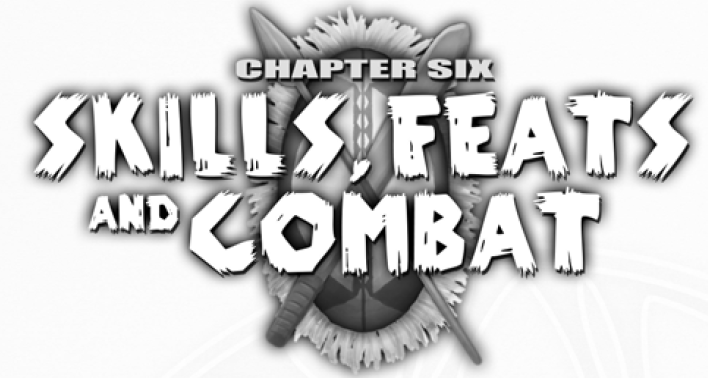
It just wouldn’t be a D20 game without feats, and while we do have new modes of combat and skills they do not occupy the lion’s share of this chapter.
We have a new skill, Natural Medicine, which is basically a variant of Alchemy but reflavored to be less chemistry/laboratory-related. It is more a combination of wilderness lore, knowing the languages of features in the natural world, and such. It’s rather superfluous in that it does and crafts everything Alchemy does, although it has new rules for foraging material components in the wilderness. We get a new use for the Scry skill,* the ability to read omens based on the preponderance of specific colors. We have a brief table explaining what things are associated with which colors and whether they’re good or bad: blue can mean either loyalty or envy, pink power or poverty, etc.
*which was its own skill in 3.0 and interfaced with the spell of the same name
Speak Language details the languages of Nyambe. The three major ones of the continent are Kordo (the “common” tongue which originated in Nibomay), Daka-Alif (Kordo/Near Eastern common in the north), and Daka-Kara (Kordo/Far Eastern common in the east and coastal settlements). We also have Daka-Dia, the extinct hieroglyphic language of the Water People, Daka-Kosa of the Kosan Empire which is often used in arcane rites, and finally the unique Talking Drum Language. Talking Drum is a kind of morse code where you can transmit information over long distances with wind and percussion instruments. Some particularly large and stationary drums can carry for miles, but most handheld instruments can carry anywhere from a half mile to 2 miles depending on whether they’re masterwork and the loudness of a particular instrument. The Near Easterners and Far Easterners have their own languages, and the standard D&D ones (Abyssal, Celestial, Draconic, etc) all exist save for Common.
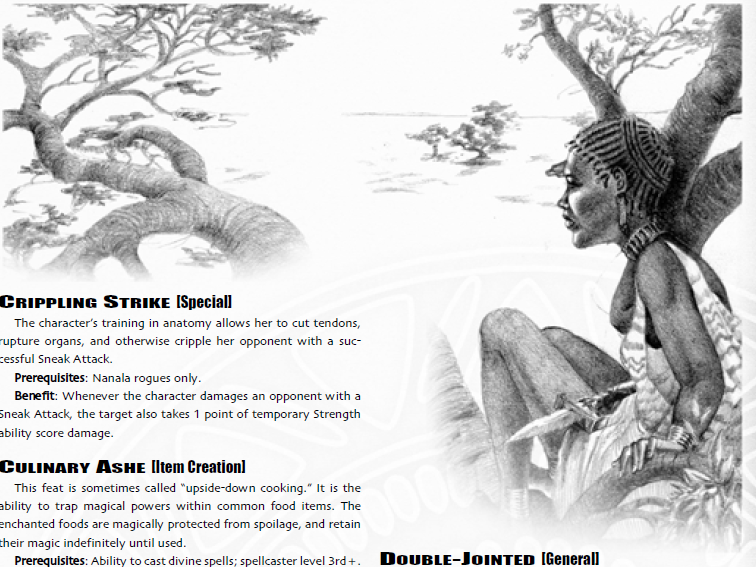
Feats
Now we’re in the meat of the chapter. We technically have 59 new feats, and for obvious reasons I’m not going to go over all of them. Rather, I’ll highlight the most interesting ones. A fair amount are +2/+2 to 2 skills, a tried and true way for D20 books to extend their own word count. The book does mention that for the sake of balance that the DM should make the Skill Focus feat grant +3 to a single skill instead of the standard +2. Yup, back in 3.0 days Skill Focus was worse than most skill feats unless you took it in conjunction with Alertness/Persuasive/etc.
Sanguar: This one is put first for special reasons. First off, it’s a bonus feat for all native Nyambans to reflect the development of martial arts dodging developed to compensate for lack of heavier armor. If you’re a foreigner you need to have the Dodge feat in order to qualify, and it grants you a Dodge bonus to Armor Class based on your Base Attack Bonus: +1 with 1-5 BAB, +2 6-10, +3 11-15, and +4 16-20. Wearing armor reduces this dodge bonus by one point per weight quality (light/medium/heavy).
This feat is extremely underpowered even if you do not use armor (only the gamba core class has light armor proficiency); even light chain shirt armor grants a +4 armor class bonus, and that’s not getting into magical enhancements and special qualities. Personally I’d recommend enhancing the dodge bonus by far higher, perhaps +4 minimum and +8 at the highest levels to make up for the lack of armor.
Rogue Class Features: Due to the nanala variant, a lot of rogue class features are now feats. Some require you to be a nanala to qualify, but there’s no “X level” gatekeeping and some you don’t even need to be of that class at all! This really opens up some of the cooler abilities, like Skill Mastery and Slippery Mind who end up with more generous prerequisites. One of the truly new feats is Analyze Unliving, which allows one to make Sneak Attack damage against creatures normally immune to it but with d4 damage die.
Magic Item Variants: First off, there’s no Scribe Scroll or Brew Potion. Both feats are replaced with Create Gris-Gris and Culinary Ashe, respectively. Gris-Gris are small bags whose trinkets are brewing with mystical energy, while culinary ashe imbues food and drink of all kinds with one-use magical properties that trigger when consumed. The mchawi and mganga get Create Gris-Gris as bonus feats, and any class or feature which would ordinarily grant the PHB equivalent feats are substituted with these.
That’s enough about the special variants. Now on to the rest!
Astrological Magic: If you succeed a DC 20 Knowledge (Astrology) check that can be made once per day, your Caster Level increases by 1 for 24 hours. Very nice.
Breath Weapon: Unthlatu only. You can breathe out a cone or line of energy dealing 3d6 damage. It has a long recharge time ranging from 8 to 32 hours depending on a 1d4 roll, and taking this feat multiple times reduces the waiting period by half. Good for low levels, but is quickly eclipsed by most damaging spells.
Fated: Can only take this at 1st level. You’re blessed with good fortune, and if you lose against a Save or Die spell you can reroll a second saving throw. If you succeed, you lose a level (or 2 points of Constitution drain if 1st) but otherwise remain alive. Can be great to have if you’re playing in more lethal campaigns or Killer DMs, especially so given that resurrection magic is less reliable in Nyambe. The reverse-leveling requires quite a bit of paperwork as a downside.
Fire Blood: Another 1st-level only feat, you have +4 on saves vs hot things and cast fire-related spells at +1 Caster Level which can stack with Astrological Magic. You’re born with red hair, a sign of efreeti heritage.
Foreign Weapon Proficiency: Select Northern, Near Eastern, or Far Eastern. You no longer treat their weapons as Exotic but rather as their appropriate category of Simple or Martial. The Northern equipment is the standard Player’s Handbook, while Far Eastern is implied to be 3rd Edition’s Oriental Adventures.
So this is covered in the next chapter, but Nyambans use a mixture of common generic weapons (daggers) and ones specific to their culture. Those not on said list from other sources are considered Exotic, such as the Longsword and Greatsword.
Impulsive: On the first round of combat you can charge and make a full attack. Requires only Improved Initiative as a prerequisite, but it’s quite powerful. You may ask if it’s superfluous with the Nibomay Amazon, but said Prestige Class allows you to move normally rather than charging, which has to be done in a straight line. It’s still a very good feat.
Parrying Shield: Basically Deflect Arrows, but stacks with it (deflect two projectiles per round) and you can do so with a shield. Unlike Deflect Arrows it is not automatic: you must succeed on a DC 20 Reflex Save to bat it out of the air.
Ritual Cannibalism: Associated with the utuchekulu dwarves but can be taken by anyone of non-good alignment, you regain hit points when you consume the heart of a living being equal to 1d8 + the creature’s Hit Dice. It’s usable a number of times per day equal to the amount of times you take this feat. Creepy and thematic, but a Wand of Cure Light Wounds outstrips it in usefulness.
Ritualistic Combat: You’re trained at inflicting grazing blows in combat. You no longer take a -4 penalty on attacks when inflicting nonlethal damage regardless of the weapon you wield. It cannot make spells nonlethal, however.
Scent: Ngoloko only. You gain the scent quality common to monsters, allowing you to detect and track other creatures. A great means of foiling invisible and hidden foes.
Shadow Dodge: Kitunusi only. Three times per day you can wrap yourself in shadows, imposing 20% miss chance on attacks directed against you for 3 rounds. A pretty good defensive boon.
Shadow Sight: Kitunusi only. You can see into the Shadow World at will, and thus ethereal creatures and objects. You can activate or deactivate this ability as a full-round action.
Strong-Arm: Substitute your Strength or Constitution for Charisma when making Intimidate checks. Most groups I know already use something like this as an automatic house rule.
Trailblazing: You and fellow party members gain a faster overland speed, and treat the quality of the terrain (trackless/road/highway) as one category higher. A bit situational save in games where time is of the essence to get somewhere.
Weapon Display: When in combat you can add your Base Attack Bonus to Intimidate, provided you spend a full-round action doing sweet-ass battle moves. Can be good in conjunction with fear-based debuff builds like the infamous Zhentarim Fighter.
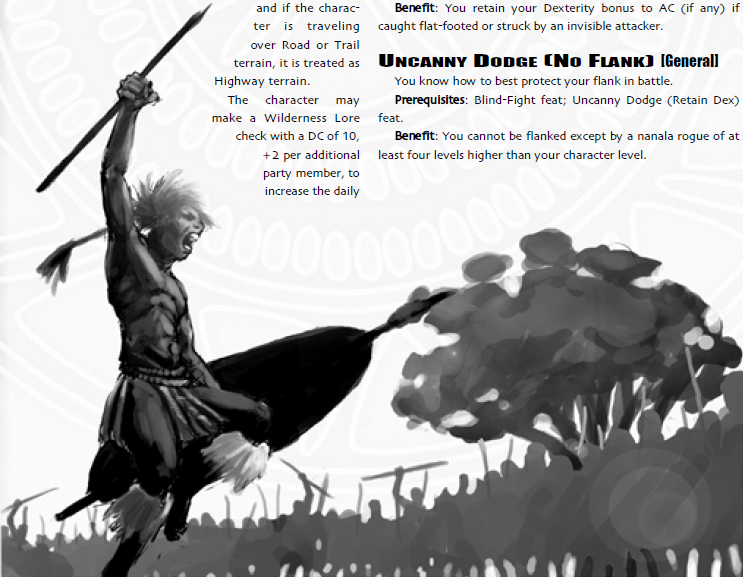
Combat
We get some brief new rules for specific kinds of combat in Nyambe as well as some conventional rules of warfare. This section is brief, only two pages long, so I can sum up most of them here.
Brush Fires are a tactic in savannahs and grasslands where someone lights a patch of dry grass on fire. It can spread further by wind, covering a lot of ground quickly as a means of battlefield control. Basically you make a Wilderness Lore skill check (Survival in 3.5/Pathfinder) as a full-round action to create a fire and have it spread in a compass point direction. There’s a 10% chance each round the wind shifts and the fire spreads in another direction. Most brush fires last 1d10 rounds, although certain fuels and circumstances can make them burn faster and longer (DM’s discretion). Given that fires can create smoke which can suffocate or grant concealment, this can be more useful for those effects than the otherwise weak damage of mundane fire. Not only that, the fact that the fire is growing means that it can create a larger AoE for the Pyrotechnics spell.
Ritual Warfare is basically a mock battle where two opposing groups line up in opposite parallel rows, armed with only shields and blunt throwing weapons. All damage is nonlethal and spells and melee weapons are forbidden, although critical hits deal lethal damage meaning that death is possible. The battle ends when all members of one side fall unconscious, surrender, run out of ammunition, or run (this part is considered cowardly and unsportsmanlike). This is done as a means of resolving disputes between groups with a minimum of casualties, usually over land rights.
Cattle Raids have no set game rules, but is when one group attempts nonlethally to break through a fort or village’s defenses in order to abscond with their cattle. This is common among the Shombe, although any group with herds animals has been known to practice it. It is most commonly done due to an affront to a rival clan or group’s honor, but not egregious enough for blood to be spilled. As a result, cattle raids are considered a gentlemanly sort of warfare where there’s cultural expectations to not shed blood but still threatens a stake in losing. Those captured in a raid are returned to their host clan minus equipment and clothes which are taken as ransom.
Nuba Matches are where two wrestlers enter a circular ring and grapple each other until one is either thrown out of the ring or loses their footing and collapses. Direct hits are banned, and the match is conducted with maneuvers such as bull rushes, trips, grapples, etc. Although non-lethal, such matches are popular, meaning that the victor gains Experience as though they defeated their opponent in a real fight...and do not have to share the Experience Points with the rest of the party! A great way for a PC to level up quickly!
Engolo Duels are illegal, more dangerous version of a Nuba match where more lethal strikes, small weapons, and sometimes even firing arrows and poisonous snakes into the ring by onlookers is employed! But despite the risk, there is a great amount of money to be made as well as bragging rights for surviving such a deadly sport. Engolo matches often have a prize of 100 to 1,000 gold pieces depending on the lethality and the infamy of the contestants.
Thoughts So Far: The skills are a bit unnecessary: the omen-reading can be made into a flavor thing while Natural Medicine is already served by (Craft) Alchemy. The feats range from blah to useful, and few of them felt overpowered save Astrological Magic. I did like the opening up of Rogue class features for others to use, and some of the racial ones were quite useful in utility. The alternate combat contests were short and thematically interesting ways in providing rules for sports and conflict resolution besides “kill ‘em all.” The Nuba and Engolo sports I have mixed feelings on, as in most group games only one PC will participate while the others sit around and watch. The brush fire rules are perhaps my favorite due to their tactical potential.
Join us next time as we scour the marketplaces in Chapter Seven: Nyamban Equipment!
Nyamban Equiment
Original SA post
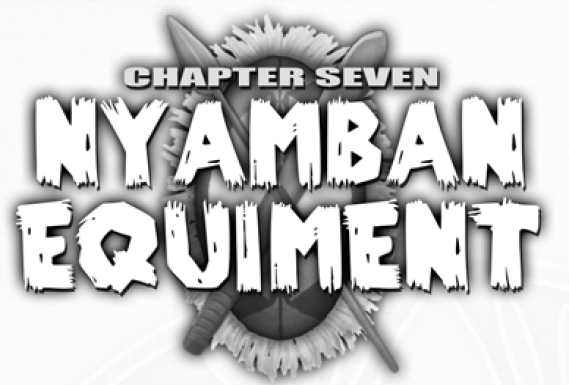
Weapons, armor, and mounts oh my! Here we not only see new gear in Nyambe, we also see how existing ones are reflavored from a Fantasy European to a Fantasy African context.
Trade Goods
First off, most of Nyambe-tanda uses one of three forms of currency to varying degrees of mixture: the gold/silver/copper piece standard that is the D&D default and most common in the Empire of Mabwe and big cities; bartering or cowry shells, which are worth one silver piece per shell and most common in rural and poor areas; and finally livestock, most common among herding and hunter-gatherer cultures. We even have several common varieties of cattle and their gold piece list, from cheap as dirt two copper piece chickens to princely 15 gold piece cows and 25 gold piece oxen.
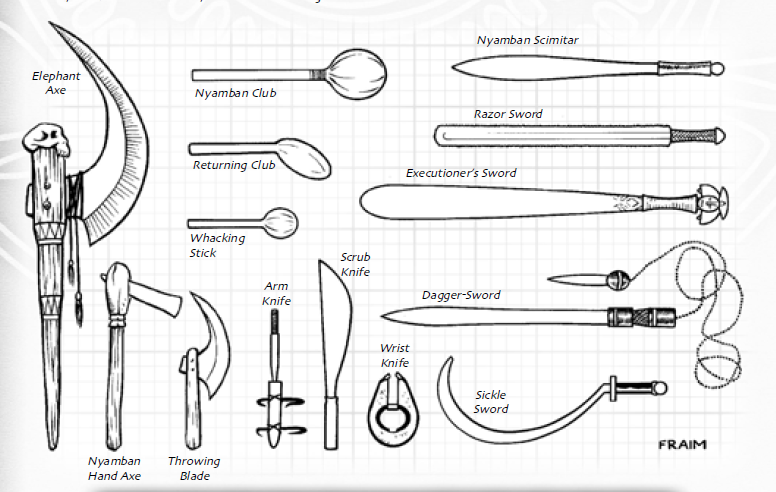
New Weapons
I mentioned this back in the Feats chapter, but Nyamban weapon proficiencies use their own category in this book. This means that those found in the Core Rules or other supplements are culturally foreign and thus fall under Exotic Weapons. This is not all-purpose: some of the more simple and utility Player’s Handbook weapons, such as bows, daggers, maces, sickles, quarterstaves, and even scimitars have been transferred over, but more explicitly European or Fantastical items such as the Greatsword did not.
We do get new weapons to make up for this loss, covering the more interesting ones. The wrist knife is an oval blade worn like a bracelet that treats strikes as unarmed but lets you deal slashing damage; elephant axes are huge crescent-shaped blades Nibomay infantry use to hamstring Mabwe elephants dealing a lot of damage (1d12/x4 critical) with 10 foot reach but are so large they impose an additional -4 to hit; returning and throwing clubs are two thrown weapons, the former able to fly back into your hand after being thrown and the latter capable of doing nonlethal damage despite being a ranged weapon; bolas which can grapple at range and reduce an airborne creature’s flight speed to 0 if grappled; dagger-swords which are copied from Far Eastern chijiriki and consist of a sword and dagger connected by a cord, capable of being used as a dual-wielded weapon or as a dagger capable of trip at a 10 foot reach; barbed spears which cause targets to bleed for one point of damage for 1d4 rounds if they fail a Fortitude save; the trademark razor swords of Niomay Amazons which are one-handed yet deal a large amount of damage for their size (1d10/18-20 x2 critical), yet the wielder cannot apply one’s Strength bonus to damage (lame!); and the javelin thrower, which is a grooved stick with a notch for holding javelins to throw with greater force and range: javelins thrown this way have range increments of 40 feet, threaten a critical on 19-20, and deal triple damage!
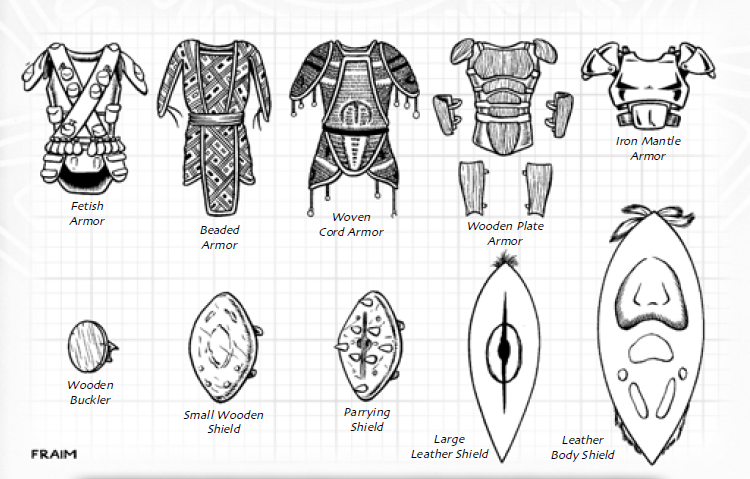
New Armor and Shields
Most Nyamban armor and shields are entirely new, with only a few such as leather and hide-based armor making the transfer. There is no heavy armor made domestically, although in the Ancestral Vault supplement it’s explained that a few specialized smiths have been learning to make foreign metal and plate armor with fire resistant magical enhancements to negate the perils of heat and humidity.
Our new armors include beaded armor, highly decorated pieces made from beads and woven leather cords and thus the kind most often worn by noblemen and stylish adventurers; fetish armor which is not S&M gear, but clothes made up of tiny pouches for holding magical components. It has no inherent armor bonus but can be enhanced as magical armor; iron mantle, which is the heaviest kind of Nyamban armor commonly found and is made up of iron plates held together with leather straps; wooden plate armor which is the same but made up of wood; and finally woven cord made from raffia fibers. All of these armors reduce the Fortitude save penalty by as much as 1 or 3 for operating in hot environments due to superior ventilation.
For new shields we basically have leather shields replacing iron ones, bucklers are made out of wood, and we have a new leather body shield which provides a +3 shield bonus and is the half-way point between a heavy and tower shield. Tower shields exist in Nyambe, but it’s unclear whether they’re made of iron or the cow-hide Nguni shields which is what I think of when I think of big African shields.
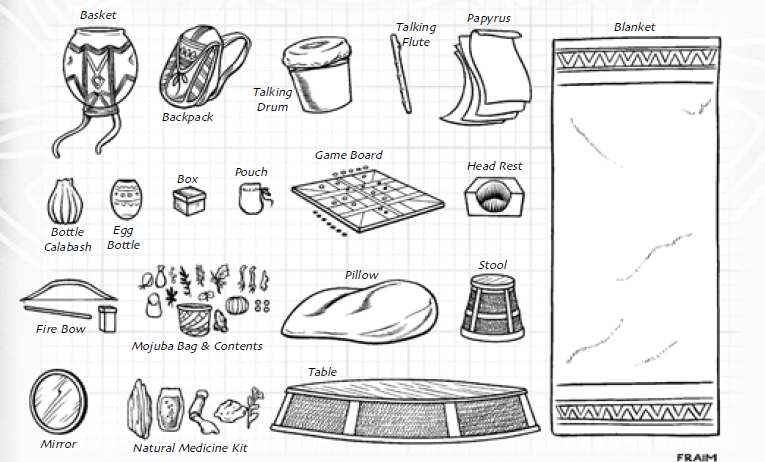
New Adventuring Gear, Kits, etc.
A lot of this is a remix of old and new material. For example, we get explanations of how iconic gear such as the backpack is made from woven plant fibers, how ostrich eggs and calabash gourds are used instead of glass for drinking vessels, and due to pillows being unsanitary in humid and sandy places carved wooden headrests are used which support a person’s head when sleeping. The most common musical instruments include bells, clappers, drums, fiddles, flutes, gongs, harps, talking hand drums, and the xylophone! A new and innovative way to Inspire Courage
Also the most common board games in Nyambe include mancala, boa, and oware, which can all be easily played with seeds or polished stones and involve rules for “capturing” other player’s seeds as a means of resolution. The art of gaming holds special properties when it comes to divination, and casters gain +2 bonus on all scrying rolls when using a board game as a magical focus.
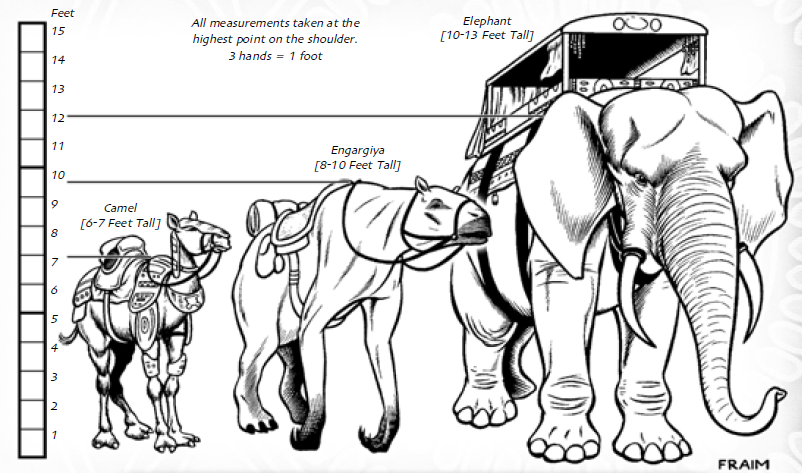
New Mounts
A lot of core rules animals can be found as mounts in Nyambe, from riding dogs and mules to horses and camels. However, the most interesting addition are the engargiya, a new creature in this book which is akin to a larger and tougher horse, and the elephant (both normal and wartrained)! An interesting thing to note are that elephants are relatively cheap to get for their power; an elephant for labor is 150 gp, whereas a war elephant (one trained to fight and carry riders in battle) is 400 gp. A heavy warhorse from the Player’s Handbook costs the same amount as a war elephant, but an elephant is a strong Challenge Rating 7 beast which can dish out a hellish amount of damage with its tusks or trampling enemies in a charge. The only comparative downside is that they are far more expensive to feed than horses and camels, with daily feed costing 2 gold and weighing 300 pounds. Elephants can graze for grass and plants in more fertile regions, but even then they can spend as much as 16 hours a day doing nothing but this.
The engargiya, by contrast, costs 200 gold pieces to buy, and is a Challenge Rating 3 beast which is not much stronger than a heavy warhorse but has Darkvision and Scent.
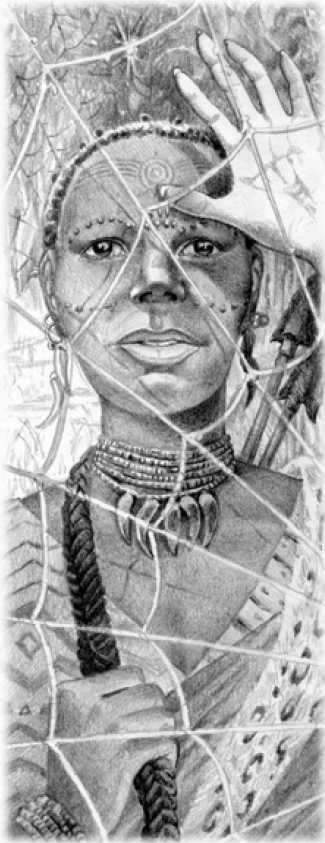
New Special Items and Poisons
This details alchemic and poisonous items. For those that played D20 before Pathfinder came along, you’d recall that alchemy was overall a low-powered novelty. Wizards of the Coast made alchemical items craftable only by magic-users, but in comparison to actual magic they just never amounted to much. Unfortunately Nyambe is the same, its new items pathetic in this regard: healing salve converts 1d4 lethal damage to nonlethal, but can be used once an hour per applicant and makes users feel drowsy for -1 on all d20 rolls. Marsh water, which is actually made from distilled water found in tree bark, allows the brinker to take 10 on saving throws against malaria. Sunscreen is made from hippopotamus sweat and grants +4 on Fortitude saves vs. heat exhaustion for 24 hours.
Now we get to poisons! A special note is that unlike standard D&D poison is commonly employed by people of all alignments and is not considered evil to use unless done in a cowardly fashion or in furtherance of an evil deed. We get a comprehensive one-page spread of Nyamban poisons which sadly are mostly copy-pasted from the Dungeon Master’s Guide but include a few new ones: aboleth mucus grants you the ability to breath underwater at the expense of suffocating in air; carrion crawler brain juice can paralyze you for 2d6 minutes, while jellyfish sting extract dazes you for 1 round initially and can stun you for 2d6 rounds as a secondary effect; poison frog secretions deal 1d6 Constitution on initial and secondary damage and 1 to 2 points of said damage can be a permanent drain; raw sewage of all things is a new poison which can nauseate you for 24 hours, and spoiled food for 1d10 hours; spitting cobra venom and spotted toadstools have a chance of blinding or deafening the victim respectively, said affliction becoming permanent on a secondary failed save.
The new poisons are quite deadly and innovative, but suffer the D20 problem of most: namely they’re expensive one-use items which may have effects too delayed to be practical in combat. Fortunately the Soroka prestige class obviates the money concern, but the time delay will require game mechanics from elsewhere to overcome.
Thoughts So Far: Overall I like this chapter, my main complaint being that the alternate weapon proficiency rules may be too restrictive. This is especially the case given that many new supplements released over the course of 3rd Edition will put more options out of reach barring Foreign Weapon Proficiency. As time goes on I’m not really fond of the concept of weapon proficiencies in general, in that I do not see why a longsword would be harder to grok than a scimitar.
I feel that elephants may be a bit too cheap for their power, even despite the inherent weaknesses of their size and lack of ranged attacks. But every PC party worth their salt will want to unleash a war elephant on an enemy at some point, so I think a more reasonable price would be somewhere around 1,000 to 3,000 gold pieces.
Join us next time as we get mystical and contact the Spirits of Nyambe in Chapter Eight!
Spirits of Nyambe
Original SA post
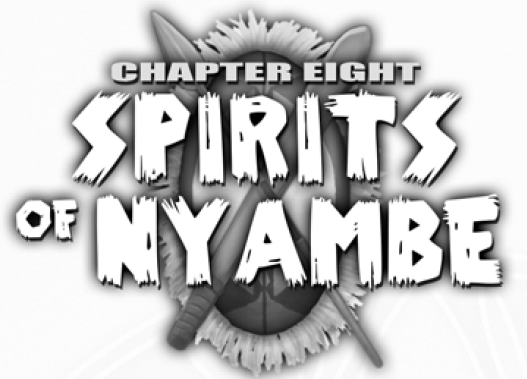
The shortest chapter of all, this covers the religious practices of Nyambe and the game mechanics for the orisha. Basically Nyambe never answers prayers directly, so normal people and divine spellcasters use the orisha as intermediaries. Every individual and culture has their own favorites, and one’s profession or circumstance may mean that one honors an orisha or group of orisha enough that they are effectively their patron.
An interesting thing to note is that barring some exceptions the holy symbols of orisha are not mere symbolism: tools related to the orisha’s domain of influence most often serve this purpose. For example, Nimbala the Judge and Shonamu the hunter treat scimitars and bows both as favored weapons and holy symbols, while Ancestor orisha treat items owned by the dearly departed as such; but in this last case can only be used for ceremonial purposes without defiling it.
One other thing separating Nyamban religion from most D&D pantheons is that barring the Celestial and Fiendish orisha, the “patron orisha” game options are not single specific entities but rather broad concepts. The Ancestor Orisha option can be anything as broad as the Tisambe people to those of your hometown, while the Animal Orisha option can range from herd animals to reptiles.

Ancestor Orisha: These are the ghosts of past generations, and while worshiped by virtually every Nyamban they only grant prayers to their descendants. They are Lawful Neutral and have the Fertility, Luck, Protection, and Strength domains.


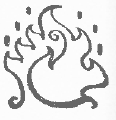

Elemental Orisha: These are spirits hail from the four elemental planes and whose presence in the mortal realm manifests as natural phenomena. Although collectively True Neutral, worshipers may be of any alignment. Their four domains are Air, Earth, Fire, and Water but n’anga must honor one of the four elements as a patron and choose their related domain as one of their two options.



Natural Orisha: These are spirits of animals, plants, and specific geographic features, and are split into these three options as patron deities. Due to the myriad variety of such things in the natural world, most priests venerate a group of related animals or plants. In the case of geographic orisha, they honor a region in which they live. All three orisha groups are Chaotic Neutral and their domains vary: Animal orisha have Animal, Birds, Fish, and Hunting domains; Plant orisha have the Plant, Sun, and Water domains; and Geographic orisha have Earth, Iron, and Water.



Celestial Orisha: Celestial orisha are good-aligned outsiders who were never mortal or who ascended so long ago their origins are forgotten. The book notes that they’re often referred to as “gods,” which kind of contradicts the idea that only Nyambe is worshiped. Regardless, both Celestial and Fiendish orisha are famous enough that their titles and roles are virtually the same among all cultures and ethnicities. Each individual orisha of both categories are much like standard D&D deities: they have their own individual alignment, domains, and favored weapons.
Araku the Warrior is the patron of blacksmiths, warriors, and laborers, granting blessings to those who create and defend. Bedaga the Trickster is the patron of doorways and roads, who upends established social orders to empower the weak. Easafa the River is the patron of rivers and romantic love, and her n’anga are renowned as excellent peacemakers. Nimbala the Judge is one of the most popular celestial orisha, but whose moral standards of law and justice are so high that few n’anga receive his blessings. Ramaranda the Diviner is the orisha famed for the creation of the sei and overthrow of the Kosan Empire, and encourages careful foresight and planning. Shonamu the Hunter presides over those who live off of and seek protection from the dangers of the wilderness. Siama the Dead watches over those who passed on and who makes her will known through thunderstrikes targeting grave-robbers, murderers, necromancers, and all who would defile the natural boundaries of life and death. Tarango the Drummer is a free-spirited and artistic entity associated with fire and music, and is popular among the lower classes but despised by the rich who consider him a threat to public order. Tisanda the Ocean is Easafa’s sister, who presides over rain and harvest in addition to the ocean, and her n’anga specialize in providing fertility rituals to those suffering reproductive problems.

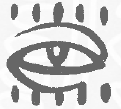

Fiendish Orisha: The fiendish orisha are invariably evil-aligned and often called demons or devils. Worship of them is banned in most lands, although some people honor them in private to stay their fury if not out of genuine devotion.
Bokor the Arcane is the orisha of arcane magic, associated so for being the first to discover how to steal magic from the Overpower.* Dar!ak the Bloody is the orisha of assassins and cold-blooded murder and encourages killing everyone who disagrees with you in a dispute or debate (sounds fun at parties). Dogar the Haggler is the orisha of
*I feel this raises several questions. Why be just a cleric of Bokor then, when you can be a mchawi? The text does acknowledge that evil arcane spellcasters are his typical worshipers, but why the domains then?
Thoughts So Far: I do like how Nyambe departs from the standard monolatrist pantheons of D&D by having clerics worship broader concepts or groups of related spirits as a single “patron deity.” But even then I couldn’t help but notice how the celestial and fiendish orisha are a compromise to familiarity. I do like how most holy symbols become some variety of physical item; it makes the honoring of orisha feel more keyed-in to their follower’s daily lives.
That said, I am not a fan of the association of mental illness with evil entities. Although not restricted to Nyambe, it’s part of a broader media trope which portrays these people not as victims but as a clear and present danger to others regardless of the disorder in question. I can get the idea of evil entities breaking people’s minds, but having said victims worship and honor them is a bit much.
Join us next time as we master Nyamban Magic in Chapter Nine!
Nyamban Magic
Original SA post
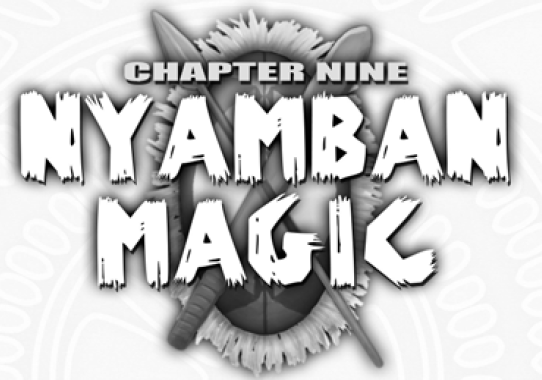
This is a collection of new setting-specific spells, along with some alternate rules reflecting the magical foundation of the universe.
Alternate Magic Rules
These are not suggested house rules, but rather specific variants taking into account the unique practices of Nyamban magic and the world’s history. First off, we get a deeper explanation on mojuba bags: mojuba literally means “to prepare a spell” in Kordo, so the bag is a container with the necessary objects for spellcasting. The contents include seemingly mundane trinkets like metal shards, rocks, animal parts, and so on, but another spellcaster can recognize them as the literal building blocks of a spell. The items are referred to as mojo.
Secondly, summoning works differently. Instead of the standard Summon Monster and Summon Nature’s Ally spells we have variants. Other summoning spells such as Insect Plague, Planar Binding, etc are unchanged. Rangers and clerics (including the Nyamban variants) who use the druid spell list have access to a new spell, Summon Elemental, while every other class and n’anga who use the cleric spell list cast Summon Dragon. Although dragons and elementals are quite diverse for monsters and have some utility functions, this is a bit of an overall downgrade.
The tale of the frog and the bat is no mere fable: reincarnation and resurrection magic is less powerful in Nyambe, the existing spells reflecting an imperfect understanding. There’s also the fact that the spirit world is a very busy place, and the departed often gain new duties and obligations preventing their return. The reincarnation spell works best on those without living descendants, as those who do have descendants are expected to serve their family as ancestor orisha and being brought back as another bloodline would sever that obligation. Secondly, all forms of resurrection spells including raise dead function mostly for those with living descendants; those without descendants are waiting in Da’s oceans to be reincarnated and Siama is not fond of breaking this cosmic order. All such spells, even true resurrection, requires a grave to be made and ashes gathered from the hearth of a temple to be sprinkled upon it.
What does this mean in game effects? Well these revival spells have anywhere from a 10% to 20% chance of failure, the latter if you’re using the wrong spell in regards to descendants or lack thereof. If any attempt at reincarnation or resurrection on a specific creature fails, all future attempts will also fail. This makes perma-death much more likely in the setting.
Finally, spells which grant any kind of Armor Class bonus (even non-armory ones like deflection or insight) require additional valuable material components with a cost of 25 gp per level of the spell. This is to simulate the setting’s lack of heavier armor by bringing down spellcasters to a similar restriction.
Gasp, a setting which is actually weakening spellcasters in numerous ways? Shocking!
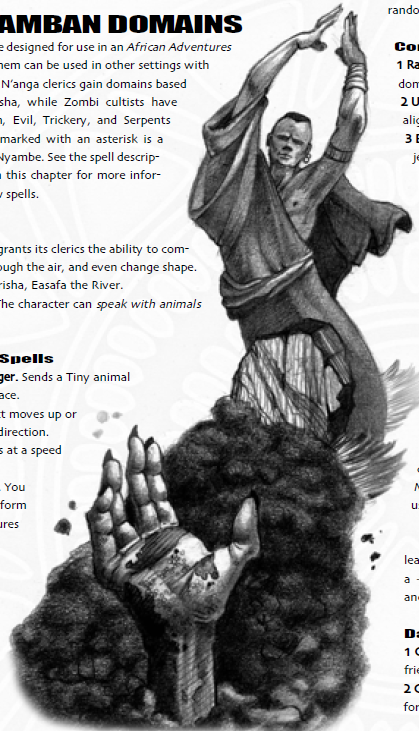
New Nyamban Domains
We have 16 new domains for n’anga, and 10 of those include at least one new spell from this book! Half of them are the province of a specific orisha and are highly themed after their nature.
Bird relates to the skyborne masters of the animal kingdom and includes various flight, weather, and shape-changing related spells with the restriction to winged creatures only. Its special power grants speak with animals at will in regards to birds
Confusion is the province of GuDuGu the Obscene One, granting immunity to all insanity-related effects and has various mental debuffs. It also includes the Random Action spell which never made the transition to 3.5, a rare relic from pre-2003!
Dance teaches you how to wield the power of music and magic together like Tarango the Drummer. Its granted power grants synergy bonuses on various physical skills if you have 3 ranks in Perform (Dance) and whose spells are based around mobility, sonic damage, and a few buffs and debuffs.
Darkness seeks the death of all light as Gamal wishes. Its granted power includes 60 foot darkvision and focuses on shadow magic and various creepy debuffs such as nightmare, phantasmal killer and power word blind.
Exile teaches those banished from communities self-survival, in line with Tu the Outcast. Its granted power is +2 on Hide and Move Silently and its spells revolve around avoiding detection (invisibility, blink, sequester) or imposing restrictions on action (sanctuary, dimensional anchor, imprisonment, etc).
Fertility harnesses the power of creation, and not just in reproductive manners. Its granted power increases the amount of hit points gained via natural healing and rest, and its spells are themed around creating and repairing objects and sustenance.
Fish grants province over marine life. Its granted power allows for rebuking and commanding aquatic creatures, and its spells revolve around water and polymorphing in regards to marine life (not just fish).
Flesh teaches the deadly arts of inflicting ruin upon others’ bodies, and as such is taught only by fiendish orisha. Its granted power increases your Hit Points by 5 instead of 3 whenever you take Toughness, and its spells are almost exclusively physical debuffs of some kind.
Greed is what trickle-down economics looks like in practice; being less about wealth creation and more preserving what wealth you have. Its granted power includes a +4 on all Pick Pocket skills and Spot checks to detect pickpocketing yourself. Its spells are diverse, ranging from guarding against scrying to protecting them from unwanted intruders such as guards and wards, or leomund’s secret chest.
Hunting teaches one how to take advantage of the natural world as well as ranged combat. Its granted power allows you to learn the Animal Empathy skill (in 3.5 it became a Druid/Ranger class feature), and its spells are a mixture of debuffs, mobility, and two new arrow-themed spells described later.
Iron is considered a fifth element beyond the classical four (but is not affiliated with the Elemental Orisha oddly enough). Its granted power allows you to ignore the Hardness, Damage Reduction, or armor bonus from iron creatures and objects three times per day, which is a great way of effectively turning weapons into touch attacks against armored opponents...if iron armor was a common option in Nyambe. Its spells are diverse, ranging from buffs and debuffs such as keen edge and rusting grasp, to battlefield control such as wall of iron and blade barrier.
Lightning is the destructive right of Siama the Dead and is anything but subtle. Its granted power grants 10 points of Electricity Resistance to the n’anga and almost every spell is directly offensive with lightning or sonic attacks.
Love can be used for both good and evil for its ability to literally change hearts and minds, and as such n’anga with this domain are not trusted until they’re needed to gain the hand of another or dissolve a tense situation. The granted power allows the cleric to automatically know how to brew love potions (or at 50% cost if Brew Potion/Culinary Ashe is known). Its spells are predictably various forms of enchantment.
Plague is taught by Sama/the Poison One, a domain that is one of the most hated in Nyambe-tanda for obvious reasons. Its granted power grants immunity to ability score damage (but not permanent drain) from diseases while still allowing the n’anga to incubate and spread them. Its granted powers include the summoning of insects and vermin or poison and disease-related debuffs.
Serpents are the dominion of Zombi, whose fell empire’s legacy still casts a shadow of ill omen across the continent. Its granted power allows the n’anga to rebuke or command reptilian creatures including dragons! The spells tend to be animal-themed around serpents, ranging from offensive buffs such as magic fang and animal growth to more offensive ones such as Poison and Snake Staff.
Wisdom is associated with both the madness of GuDuGu the Obscene One and Ramaranda the Diviner. N’anga with this domain often find themselves as advisors to nobles or community spokespeople for their foresight. Its granted power is a lame +1 bonus to all Wisdom-based skills, and the spells are exclusively utility divination.
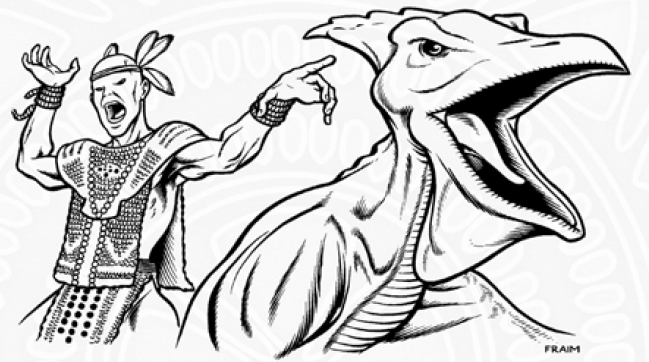
New Nyamban Spells
Nyambe has 24 new spells, 40 if you count the nine iterations of Summon Dragon/Elemental as their own individual magic. And to reduce confusion, new abbreviations are made for the new Nyamban core and prestige classes, with the Player’s Handbook abbreviations in parenthesis. I’m also getting some Dragonlance 3.5 vibes in that several of the spell descriptions include in-universe lore of the spell’s inventors and/or most infamous uses which I like. In keeping with divine magic being common and socially acceptable, all but the new Summons are included as a domain spell, 4 of which are domain-exclusive.
Arrow of Slaying is a Hunting/Dembe spell privately taught among the greatest monster hunters and as such is never incorporated into charged magical items. It grants the slaying enhancement upon already-magically arrows, the type of monster designated upon casting. If such a creature type is hit with an arrow, they must make a DC 20/23 Fortitude save (lesser or greater) or die. This is a multi-use save or die spell and really effective.
Babble is a permanent AoE debuff which renders afflicted targets unable to speak or write intelligibly. Non-linguistic communication is possible, but it renders verbal spellcasting impossible.
Bite of the Plague Rat is a powerful 9th-level spell which afflicts everyone in a 30 foot radius with the red death disease on a failed save, a new one in this book (1d6 Constitution damage per day). The disease is highly contagious airborne plague which manifests no symptoms, allowing for a devastating chain spread.
Convocation of Eagles is a Bird domain specific spell, summoning 12 giant eagles to your side.
Drums of Panic is a cool Bard/Dance domain spell which requires drums as a focus. For one round per level you roll Perform (drums) which sets the DC for the spell, and enemies within a 30 foot burst who fail the DC become panicked for 1d4 rounds. Given how easy it is to cheese Perform bonuses, this is a potent spell.
Fertility Charm is perhaps the most well-known spell in Nyambe-tanda. For one hour per level a touched creature is able to impregnate or become pregnant based upon their physical sex as well as gaining Endurance as a bonus feat. ( ͡° ͜ʖ ͡°)
Incantation of the Broken Limb is a low-level (2nd, or 1st with Flesh domain) spell, but is quite devastating. It doesn’t deal much damage (1d4 to 5d4) but can render a limb of the caster’s choice to be broken on a failed Fortitude save, imposing a -2 penalty on all d20 rolls relating to the use of said limb until the damage is healed.
Iron Golem is a 9th-level spell for spellcasters on a budget. Instead of building your own iron golem you can summon one for 1 round per level and are automatically capable of communicating with and commanding it. However in exchange for this “golem on the go” there’s a 10% chance every round that said golem will turn on the caster.
Lesser Water Breathing is one level lower than its standard counterpart, lasting only 10 minutes per level rather than 24 hours.
Lighting Storm and Lightning Strike are a pair of electricity-themed spells known exclusively to n’anga druids (Storm) and/or those with the Lightning domain (Strike). The first spell fills a bunch of 10 foot cubes with ambient electricity dealing 1d6 damage per caster level, while the second spell is a lightning version of flame strike.
Lobir creates an invisible insect construct of the same name for 1 round per level, commanded by you and capable of burrowing under an opponent’s skin to deal internal damage. The spell is the only known means of creating a lobir to inhabit the world, for they cannot be permanently built. Although detailed in Chapter 13, a Lobir is a Challenge Rating 3 fly-sized construct with an amazing Armor Class and Damage Reduction (27, DR/15), are naturally invisible, and deal 1d4 constitution damage per round they remain embedded in a target via a touch attack. A pretty nifty and powerful spell.
Lockjaw causes the jaw muscles of a target to clench up on a failed Fortitude save, rendering them incapable of speech or verbal casting and lasts indefinitely until the target succeeds on a save they can make once per day. Although second-level (1st if Iron domain), this is a really powerful anti-spellcaster debuff. Much like Babble but targeting less people and with a shorter duration.
Lover’s Curse is a reverse charm spell, a permanent curse which causes the target to suffer a -10 penalty on Charisma checks as people instinctively hate or dislike them.
Phase Arrow is the other Hunting/Dembe spell. It enchants 10 normal arrows into +1 weapons which can travel through the Shadow World to ignore physical barriers. They ignore all armor, natural armor, and cover modifiers, turning physical and damaging a target normally once it reaches its intended destination.
Snake Staff turns a quarterstaff into a snake for 1 round per level, capable of being wielded as a weapon dealing 1d8 piercing damage and 1d4 Constitution damage as a poison. The staff has an infinite supply of poison but cannot be “milked.” It’s rather underpowered for a 7th-level spell.
Solid Darkness creates a cloud of physical darkness, granting full concealment to all within and blocking out even Darkvision. Creatures move at 1/10th normal speed, and is charged with negative energy dealing 1 damage per round, making it a good means to heal multiple undead minions the same amount.
Sticks to Serpents turns a pile of branches and twigs into 3 fiendish small vipers per level, and you can communicate with and command them. For comparison, a single fiendish small viper can be summoned with Summon Monster I, but higher-level SM castings max out at 1d4+1. As this spell is 6th-level it’s a great means of potential action economy abuse, but these monsters are so weak that they can be easily destroyed by an AoE spell.
Summon Dragon and Summon Elemental are our two replacement spells for the ubiquitous Summon X spells which are the bread and butter of standard D&D. Both go all the way up to IX and function similarly to their replacements. Summon Dragon is pretty good, as the 3rd Edition designers intentionally under-CRed true dragons so as to make them “even tougher fights,” and those of sufficient age can outright cast sorcerer spells. Depending on how liberal your GM is with granting you control over who you summon, this can be an effective way of getting a more minor spellcaster to perform a spell upon your behalf.
As for Summon Elemental, it is weaker in that said creatures do not have as much function, but can have useful utility. They can do things mundane animals cannot, but unlike fey they do not have as much versatility.
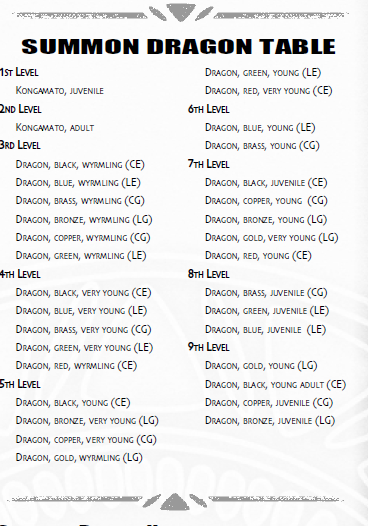
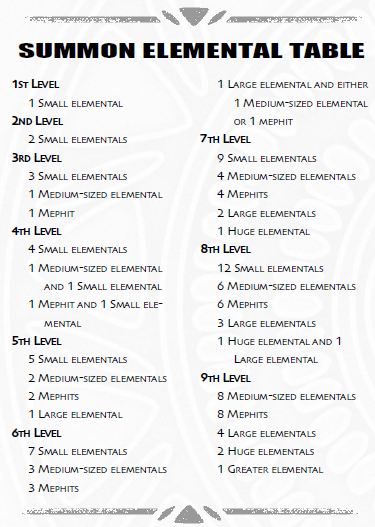
Tear the Open Wound is a powerful necromancy debuff permanent in duration. A targeted creature who has taken damage from a slashing or piercing weapon becomes unable to be healed from any cure spell on a failed Fortitude save, although natural healing and healing spells without the word “cure” in their name work normally. This spell can only be dispelled by break enchantment or the wish series of spells (limited wish, wish/miracle). Given that casting healing magic in general is not action-efficient in D&D, this is rather underpowered.
True Love is either a 9th-level Love domain capstone or a 6th-level bard spell. It causes two targets within range to permanently become hopelessly in love with each other, and both must fail their Will saving throws in order for the spell to take effect. In addition to regarding each other as beloved and trusted companions, they both physically sicken if separated for more than 24 hours, ranging from Strength and Dexterity penalties to becoming bedridden at 0 hit points at worst. This is of limited utility given the double-fail-save as well as being a slower-acting debuff.
Weaving Dance is the 9th-level capstone of the Dance domain, and is a multi-purpose personal buff spell. It effectively grants you Dodge, Mobility, Fast Movement, Evasion, Improved Uncanny Dodge, and +4 Trap Sense which can stack with existing modifiers of said features. It only lasts for 1 round per level, and I found it rather uninspiring in that the individual effects pale in comparison to lower-level spells such as haste, displacement, etc.
Wings is a 5th-level Bird domain exclusive spell. It functions much like Overland Flight, but is personal in use, causes you to physically manifest wings which have a faster 90 feet per round speed (60 if wearing medium or heavier armor) at good maneuverability. You also get Flyby Attack as a bonus feat for the duration, and if your spell ends while you’re still in the air you begin to float slowly down for 1d6 rounds at a rate of 60 feet per round. This slow fall even occurs if said spell is dispelled or you get caught in an anti-magic field.
Thoughts So Far: The new domains and spells are overall quite cool. In a few cases they are underpowered for their level and a few are quite potent, but the latter case tends to be spells exclusive to one of the new cleric domains so as to reward taking it. I am not exactly fond of the variant rules: although I can understand the sentiment of not making shield/mage armor widen the Linear Warriors Quadratic Wizards gap, Nyamban adventurers are already quite AC-starved with the pitiable Sanguar feat. The unreliability of magical reviving nicely ties into the world, but given the preponderance of Save or Die spells may make Nyambe campaigns unexpectedly lethal. I can imagine the “forever dead” percentage chances being more unwelcome than not in gaming groups.
Join us next time as we take a tour of the continent in Chapter 10’s Lands, Nations, and Societies!
Lands, Nations, and Societies
Original SA post
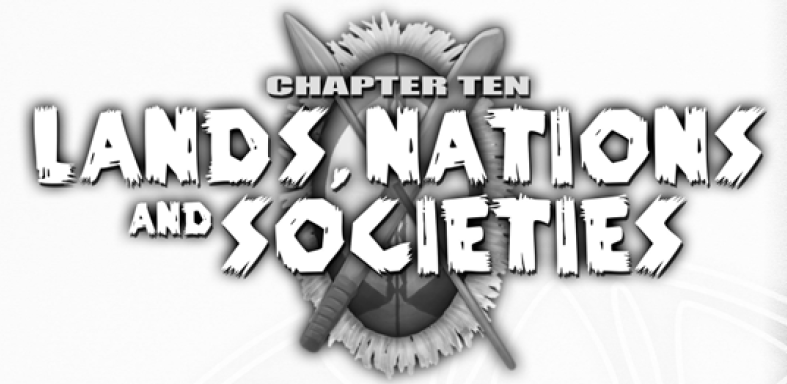
Our chapter first starts out with the major geographical regions of Nyambe, along with comprehensive random encounter tables for each of them. In regards to this last part the average Encounter Level, or level of challenge of comprised monsters, tends to hover around the low-middle range of 5 to 9. Only one region drops as low as 2, and only the most dangerous places, the Isle of the Overpower and Kayalu Island, go above 10. What this means is that going by the book wilderness travel in most of Nyambe is very dangerous for starting-level groups, but once you hit high level most of the encounters become trivial. I’ve never been a fan of this on such a large scope, as it has the unintended effect of “gating off” entire nations and regions from casual travel. In such cases this makes sense, but if you wanted to do a 1st-level game in a bIda Rainforest village you’re out of luck.

Going by regions, we have two large mountain ranges, the Giko Taaba and Kuba Taaba prized for their rich mineral veins, with the former rumored to have vicious monsters in the depths and the latter’s peaks home to icy ruins guarded by white dragons. The Gudu Ji Pingu Desert is the hottest and least hospitable place in Nyambe in which humans can live, which is why the Marak’ka prize it for they don’t have to worry about outsiders fighting them over resources. The D’okan Desert of which Bashar’ka is built upon is strangely one of the coolest regions in Nyambe, being more badlands than sandy dunes. As a result, armor of all varieties may be worn normally here. The Great Mangrove Marsh is absolutely teaming with all manner of deadly monsters, from dragons and hydras to the legendary snake-like lau. The mighty bIda Rainforest covers 25% of Nyambe-tanda and is so huge that many simply call it bIda, or “forest.” It is home to verdant resources prized by many in spite of its dangers. Lake Gomala is one of the largest freshwater lakes in Nyambe, but some mysterious curse scours all life in a 5-mile radius every few centuries. The four major oceans vary wildly in their climate and danger, with the placid Eastern Ocean the most-traveled by foreigners, while the deadly Northern and Western Oceans are plagued with sea monsters and violent weather. The Southern Ocean contains sunken cities of possible Kosan origin, and the Empire of Nibomay is gathering mages to conduct a deep-sea diving expedition.
Our regions are topped off with several islands: the Isle of Shadow is a fortress of ngoloko who only accept members of their own, and those admitted are never seen again once they set foot inside. The nearby nation of Mademba is worried as to what they’re up to, especially given the entire place is scry-proof. Marak’pInga is an island where the Marak’ka sail to in order to bury their dead, but as of late said departed souls have been resurrected by an unknown party as mummies which cross over to the mainland and harass their descendants. The Isle of the Overpower is so named for it’s said that this is where the god ascended to the heavens on a spiderweb. The place is covered with crystalline formations and portals to celestial realms, and is also home to the vaunted artifact the Throne of the Overpower. Kalayu Island, by contrast, is said to be where the Kosan made first contact with the fiendish orisha and is home to all manner of fiends as well as the Tarrasque!
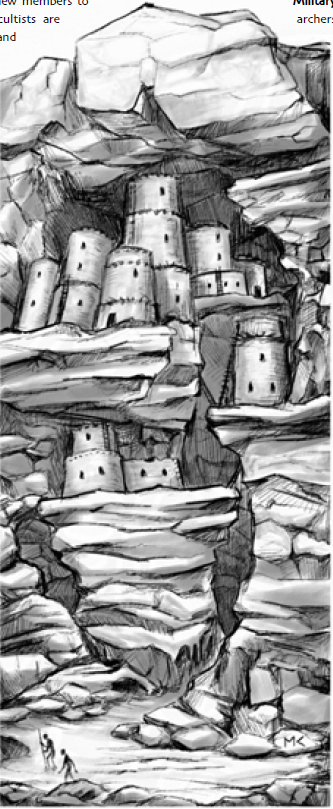
Nations of Nyambe
At this point we get some rather in-depth discussion of Nyambe’s population: it has an average population density of 5 humanoids per square mile in a continent around 9 million square miles, slightly below real-world Africa’s 11 million. This is not universal across the board, as certain regions are vast wilderness while others are more settled. This works out to a population around 43 million, and monsters and nonhumanoids are not included due to being much harder to estimate. The book also says that it came up with these figures based on the world population of 1200 AD being around 360 million, so that Nyambe would contain around 12% of your campaign setting’s population. This feels a bit in-depth for most gaming groups, although I can appreciate this on some level given that global population figures and density aren’t something many settings take into account.
The below nations include both seven large nation-states with an overarching form of government, as well as more informal cultural and geographic regions. The latter examples are often titled after the land of the people who traditionally reside there: Marak’ka-Land, Shome-Land, or even things like Entare-Land and Silwane-Manzi-Water for monster-dominated regions. About 28.5 million Nyambans live in one of the seven proper nations, the rest under more localized governments.
Bashar’ka: This theocratic nation is ruled by fire priests. The mightiest among them takes the title of “king” or “queen” but said title is not hereditary. Instead it’s determined by whoever has the most truck with the orisha of flame, heat, and related phenomena. In spite of this fluctuating leadership the country as a whole has a largely peaceful history, although Queen Nyathera’s son will spell a possible war with the Caliphate of Boroko. She has yet to launch an invasion on account of wishing to gain the Great Udamalore artifact first. This ivory scimitar traditionally served as the badge of office for a Barshar’kan King or Queen, so she’s offered the princely sum of 250,000 gold pieces to whoever can bring it back to her.
Boroko: The Caliphate of Boroko is independent, but highly reliant upon trade with the Near Easterners and as such Caliph Ragheb is akin to a puppet-prince. The capital city of T’ombo is the largest settlement on the continent, and its Great University teaches a variety of subjects. Alas, the city is plagued by a monster of unknown origin known as the Devil of T’ombo which stalks lone individuals and small groups at night. Caliph Ragheb has been instructed by the Near Easterners to deny fathering the Queen of Bashar’ka’s son, while more domestic problems speak of a conspiracy of Nuba wrestlers planning a coup for having their sport outlawed on Near Eastern holy days.
Entare-Land: The greatest foes of the Shombe are this race of lion-folk. Said monsters do not go out of their way to invade other lands save to steal cattle, and those brave or foolish enough to go into their territory are charged with “protection fees” of valuables. However, due to being Lawful Evil the entare are sticklers for oaths and contracts and are not in the habit of killing people who peacefully surrender their belongings or offer to serve them for a short time. Unfortunately they do not extend this mercy to the Shombe who usually fight back, and it’s said that a powerful entare chieftain is planning to invade and slaughter all of Shombe-Land.
Kaya Vua Samaki/East Nyamban Merchants’ Confederation: Seven city-states and a northern peninsula form a loose alliance of trade hubs. They do not have a large standing army, instead relying upon private soldiers and adventurers to guard trade routes and estates. They accept goods and coinage of all kinds, and the fish-catching towns are a cultural blend of native Nyamban and Far Eastern styles. This multiculturalism is not necessarily a peaceful one: many Nyambans fear the foreign traders and their faiths as threats to their way of life, and this sentiment helped formed the Leopard Cult. In fact, said cult has grown into a multi-city issue to the point that the lycanthropes are widely believed to rule the city-state of Kogo in all but name. The anti-arcane magic attitudes may result in military action which may put many innocent Kogons in danger. There’s also a secret conspiracy among some merchant groups to seize Mabwan gold mines in the Kuba Taaba Mountains once the nation gets distracted by the next convenient crisis.
Mabwe: The most powerful nation on Nyambe-tanda, both in military and economy, is also its most repressive. The veritable gold mines are the largest source of its kind in the world and are exclusively owned by the nobility. A great emphasis is placed on law and order, and the death penalty is common for a large number of even victimless crimes. The high number of divine spellcasters to ascertain truth and guilt has prevented some cases of innocents being unpunished, but this is not always enough to overcome classism and corruption. The upper class are descended from merchants, and the Oba (or king) has come from varying lineages due to various assassinations and civil wars. Its capital city, Dzimba Dza Mabwe, is made of stone with an impressive wall and whose royal palace has magically-treated acoustics so that the Oba’s proclamations can echo far into the city. Most curiously, the general public has not seen the Oba’s face in generations, leading to some rumors that a replacement is posing as the original king. A cavalry of elephant-riding warriors guards the capital, and there’s an entire industry of wakyambi merchants dedicated to scouring the rainforest for edibles in order to sustain these powerful beasts.
Mademba: In spite of scenic hills and mild weather, many humans regard Mademba as some kind of hellish place nobody would willingly go to on account of how “soulless” the native kitunusi appear in addition to them living in underground cities carved from volcanic rock. But Mademba is overall a safe place. The major cause of concern is the Isle of Shadow off the coast, as well as rumors of Bashar’ka’s Great Udalamore being spotted here causing many foreign adventurers and mercenaries to flock to the nation. Mademba’s government is purposefully baroque, its membership unknown and only major government building a windowless Office of Test Administration. Decrees carved upon stone appear in public spaces bearing new legislation, and a magical mouth-shaped glyph reads the contents in both Kordo and Gnomish for the illiterate.
Marak’ka-Land: Besides the dangers of the desert Marak’ka-Land is a rather boring place for adventurers. There’s a lack of bustling cities to visit, dangerous monsters to fight, or notable ruins to explore. The Marak’ka themselves are largely peaceful, which ironically is why they need outside help as of late. Their ancestral burial ground, the Isle of Marak-pInga, has been overrun with undead. This is a huge issue, for this island is where all Marak’ka bury their dearly departed. In addition they must also conduct rituals to ensure their safe passing.
MbUi-Land: The gnolls of MbUi-Land have more males than females among their fighting force, an overall oddity for the otherwise-matriarchal race. But they do share a penchant for violence and slavery, making raids into Nibomay, Shombe-Land, and Utuchekulu-Land for captives for labor and nourishment. They are allies of the Entare and keep out of each other’s way, although most MbUi as of late are locked in a civil war between followers of Na/inga the Warrior Queen and Dar!ak the Bloody. The fighting’s gotten so bad that some even contemplated hiring outside adventurers, although nobody’s taken them up on their offer on account that most people would rather see them kill each other than their own civilizations.
Nibomay: The proud Nibomans refer to their nation as the First Empire, and their capital Arabo as the First City. And while they have a rich history, the country has faced a decline and loss of terrain. Where they once possessed a monopoly on iron weapons and armor, technological advancements by others allowed foreign nations to stay their hand. The JamIkadi (ruler) of Nibomay has begun seeing visions of Amazonia herself, to the concern of the court who cannot verify the accuracy of such premonitions. That the JamIkadi claims that Amazonia wishes her to invade and reclaim old territories, included allied countries such as Mademba, has riled the more jingoistic members of the populace into action. More domestic issues include a high disappearance rate among the Tuslan minority, and people suspect human sacrifice by fiendish orisha cults to be the culprit. But the Tuslan believe that the Amazons are responsible instead! Sadly it is not a tolerant land, as its majority population is almost exclusively Tisambe human and those of other races and ethnicities are not allowed entry into Arabo.
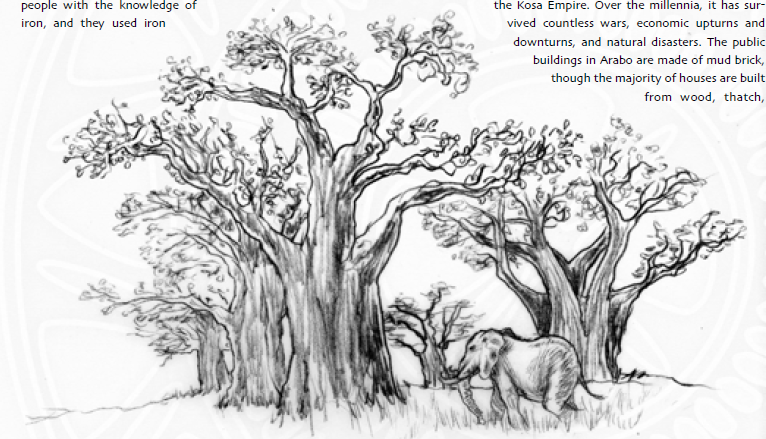
Shombe-Land: There’s not much to say here that hasn’t been covered in the races and culture chapter besides the foundations of their villages and makeup of their buildings. Villages known as kraal are surrounded by thorny branches, with houses made from mud and savannah grass reinforced by cattle dung with a central pen to hold in herd animals at night. Their most pressing conflicts include escalating skirmishes with the entare that threaten to blow over into full-scale war, as well as violently reacting to Taumau-Boha’s attempts at “civilizing” them via teaching them how to farm.
Silwane-Manzi-Water: Silwane-Manzi is the Nyamban name for sahuagin. Primarily living in the Northern Ocean, they attack vessels which cross their waters and live in sprawling underwater cities far off the coast. As a result not much is known about their culture besides the fact they worship Sama/ the Poison One and their own creation myths claim they arrived in the Material Plane from another world long ago. They recently found ways of appearing many miles inland, raiding otherwise landlocked settlements. Many fear that they found some means of living on land indefinitely.
Tauma-Boha: Mabwe has gold, Kaya Vua Samaki a gateway to the East, and Nibomay a proud history and martial traditions. Taumau-Boha’s claim to fame is more humble, possessing the most fertile farmland on the continent. Although technically two kingdoms, Taumau and Boha, they are ruled over by a single Mwanamutapa with the Boha Kingdom having its origins in the near-vanished Boha-Boha people. Both they and the Azzazza share a common history in being former slaves of the Water People, and the latter group’s pyramids are now used as storehouses in large urban areas. Being bordered by jungle, mountains, and ocean prevents the kingdom from expanding, which encouraged them to try their hand at ‘civilizing’ neighboring Shombe-Land.
Unthlatu-Land: Dangerous monsters, diseases, and unfarmable land mean that most people rarely visit the Great Mangrove Mash. People more or less leave the Unthlatu alone, and when they seek trade with outsiders they rely upon a blind barter system where piles of rocks and samples of items are left in a commonly-designated area for both parties to negotiate. The unthlatu are some of the best sorcerers in Nyambe-tanda, so those seeking arcane secrets often venture into the Marsh at great personal risk. The other resource of interest here includes skin from the monstrous lau, giant tentacled snake-like reptiles, of which a merchant is will to pay in great sums of gold. A rumored treasure vault guarded by the “king” of the lau only sweetens the deal.
Utuchekulu-Land: Not much new information here besides the fact that the dwarves call the Giko Taaba mountain range Utuchekulu Taaba, and there are large excavation projects underway into returning to their ancestral homeland. Unfortunately ghostly undead giants known as the rom are stymying efforts, and attacks from MbUi-Land and Tuan-Ti-Land have divided the dwarves’ attention.
Wakyambi-Land: Once widely spread out over the bIda Rainforest, the wakyambi suffered greatly in the ongoing war against the Yuan-Ti invaders. They lost most of their land to the serpents, and while Mabwe’s willing to provide them with weapons their own warriors have not directly intervened. Almost every elf knows of a friend or family member who was killed or carried off in battle, and their alliance with the agogwe and Nghoi one of their few advantages.
Yuan-Ti-Land: The ruins of the Kosa Empire, avoided by all save daring adventurers and scholars of forbidden lore, now have new occupants. The Yuan-Ti came among the Far Easterners for reasons unknown, conducting major expeditions to claim territory in the bIda Rainforest. And while they retain some of their own faith, a large number of these monstrous reptiles found a kindred spirit in Zombi the Serpent Lord, and like many other fiendish cults seek out slaves and sacrifices. Little truly know of their plans and the Yuan-Ti go out of their way to kill all witnesses and loose lips. Some theorize that they seek ancient Kosan magic for world domination.
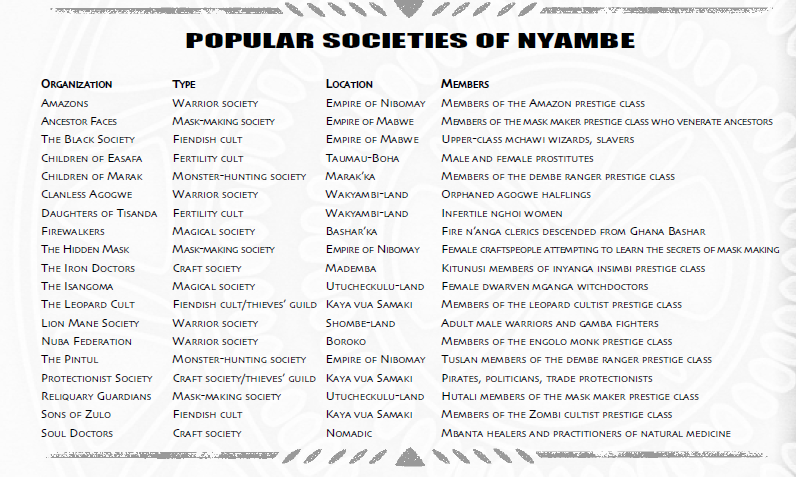
Nyamban Societies
This very brief section outlines twenty major organizations of the setting. They are organized on a table detailing their title, location, and primary members and goals. Specifics beyond this do not exist, instead briefly going over the generic society types. Most are self-explanatory with a few exceptions: fertility cults range from ritual sex workers to support groups for childless couples, who all have their own means of encouraging conception. Fiendish cults subject prospective members via alignment screening to weed out do-gooders and those lacking the stomach for their misdeeds. Mask-making societies are pseudo-secret and serve as a combination lorekeeper and police force afforded protection in their anonymity. Organized religion is rare save in Bashar’ka and Boroko, and most temples and shrines are locally funded and open to the public. Finally, warrior societies are often public organizations but have their own secret hand signs, passwords, and other means of communicating information to fellow members.
Thoughts So Far: The main setting chapter takes a very big-picture approach, but even then it feels sparse, as the nations are described in broad sweeping terms with information on specific locations relegated to the capital city at most. There is a healthy assortment of conflicts and adventure hooks, but many nations feel like they have one big problem rather than a bunch of smaller ones GMs can build off of and rework. In some cases we get repeated information from earlier chapters, which makes the truly new information for some regions barely perceptible. There’s a relative lack of “wondrous” locations, be they dungeon environs or overtly supernatural areas with mysterious powers, perhaps in part due to the big-picture overview. Although the second-longest chapter, only the random encounter tables of the geographical areas felt the most fleshed out.
Join us next time as we cover some sample plot hooks in Chapter Eleven: Adventures in Nyambe!
Adventures in Nyambe
Original SA post
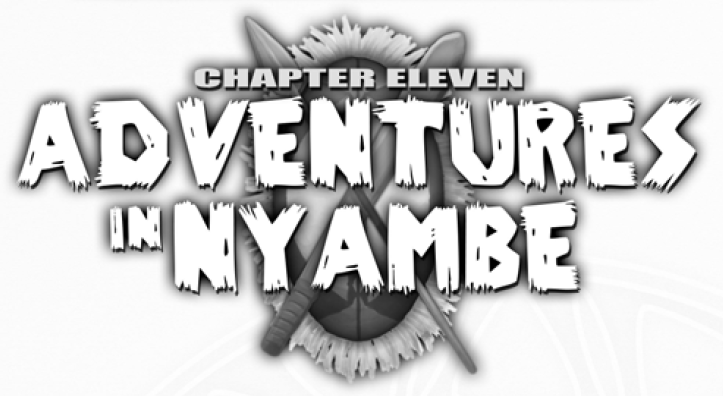
This is the Miscellaneous GM’s Section of the book, a collection of material which doesn’t fit in the other chapters. On a similar note the artwork here feels like placeholders, few of which is directly relevant to the adjoining text. The majority of content focuses on new adventure hooks and what’s going on behind the scenes of the various lands.
Advanced Disease Rules
Certain regions of Nyambe are home to terrain and animals capable of spreading illness, who in colder climates would have their numbers reduced during the harsh winters. As a result, every region has a percentage chance per week of game time to check if a character needs to roll a Fortitude save against an illness. Foreigners suffer -4 on this save due to not having built up immunities, and vice versa for Nyambans encountering foreign diseases. The exception are magical diseases which the humanoid body cannot naturally build a natural resistance against. In fact, due to the preponderance of divine spellcasters with cure disease many diseases have naturally developed Spell Resistance. Additionally, there are new rules for Prevention which allow you to automatically succeed on saving throws in regards to certain illnesses: cauterizing injuries, wearing gloves, purifying and boiling water, etc.
We have 12 new diseases, ranging from the mild yet disgusting worms which are parasitic eggs found in ingogo feces and tainted food supplies; blood fever spread by rats which can drive one to fever-driven hallucinations; malaise is basically malaria and spread by mosquitoes which deal Dexterity damage in the form of joint pain; fiend touch which is spread by evil outsiders and causes rapid Intelligence damage from the swelling of the brain lining; to the infamous red death which is a highly magically-resistant airborne virus that deals daily Constitution damage from internal hemorrhaging.
Diseases have always ranged from inconveniences to slow death for adventuring parties, and Nyambe is no different. The Spell Resistance combined with new Prevention rules may cause gaming groups to become overly cautious, although the novelty may wear off when players announce that the PCs boil their water for every meal and sleep in mosquito-proof net tents.
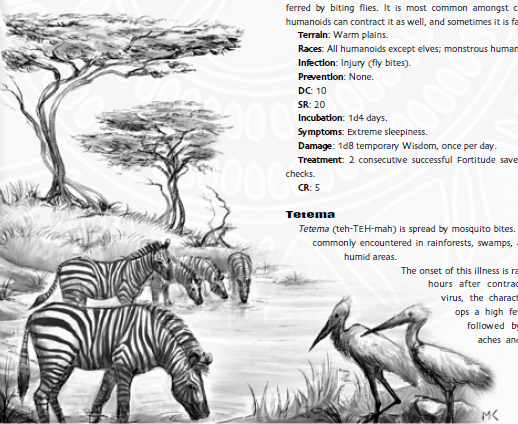
Secrets of Nyambe
This is technically an addition to Chapter Ten’s regional and national issues, sorted by adventure hooks. Each hook has three sample pieces of information about “the real behind-the-scenes plot” so as to prevent players spoiling themselves by reading the book. There is a bit of a recurring sample secret where the conspiracy/rumor/etc is bunk and there’s no big monster/invasion/etc going to happen. This feels like a bit of a downer, but may make for a good twist...if used only once, and provided with an alternative so the adventure does not feel like a waste.
I won’t cover all of the hooks, focusing instead on the more interesting ones. For example, the lost Great Udamalore may have already been reclaimed as a ploy to deceive Boroko into believing that Bashar’ka is not ready to attack; alternatively it is in the possession of the ngoloko on the Isle of Shadow; or it may in fact have gained sentience and now runs Mademba behind the scenes! The orcish slave raids on the western coasts may be your mere typical slaver-baddies, or in fact remnants of the fallen Kosan Empire who made a beachhead on Kalayu Island. Boroko’s Devil of T’ombo may be either a depraved serial killer, a group of terkow undead, or the lost lich Zulo who is killing people to slowly rebuild his necromantic power base. The Oba of Mabwe may be dead, his corpse animated to look real and controlled by duplicitous necromancer advisors, or in fact has been replaced by a shapeshifting monster seeking to escalate tensions with Nibomay. The orcish Isle of Shadow’s secret may be a genuine project to build a ngoloko utopia, an assassin’s guild, or guards a portal to an alternate Material Plane where the Kosa Empire never fell. The yuan-ti may either seek to turn the bIda Rainforest into a new home, to reawaken their ancestral race (the Samat) from their tombs, or established contact with the few remaining Kosan orcs and are working together to conquer all of Nyambe in the name of Zombi the Serpent Lord.
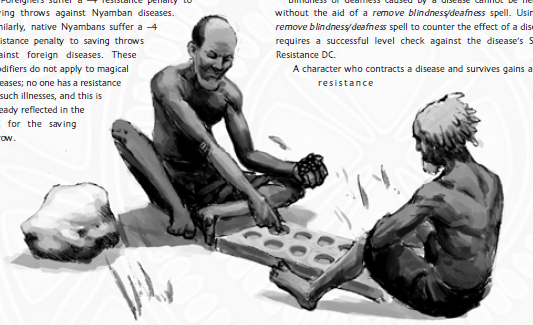
Nyamban Treasure
This brief section explains that different types of currency and items result in slightly different random treasure generation, and provides new tables for various item types. Nothing major to say, although the example objects are nicely reflavored, while a table for mundane items and adventuring gear are changed to include the new equipment types and mounts. Here’s an example for one art object result:
Beaded ostrich egg drinking vessel, Expertly carved wood cup, Expertly carved wood bowl, Iron necklace, Pigmented wood and raffia fiber ceremonial mask, Bolt of mud cloth (Bogolanfini)
Thoughts So Far: I overall like the adventure hooks, and the individual options are sufficiently different enough from each other to result in very unique campaigns. The new item generation tables and disease rules are more of a novelty which I cannot see myself using, but may be of help to some gaming groups.
Join us next time as we gaze upon the new wonders in Chapter Twelve, Magic Items!
Magic Items
Original SA post
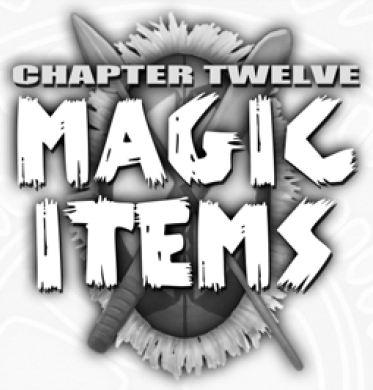
If Feats are the First Estate of D20 supplements, then New Magic Items would be the Second, with monsters a close Third. And hoo boy do we have a lot of new trinkets, artifacts, concoctions, and all things supernatural!
Magic Armor is actually just as common in Nyambe-tanda as it is in other realms on account that the mystical qualities are often seen as a worthy price to pay for heat exhaustion. We have some new special enhancements such as Ritual Combat which converts a limited amount of lethal damage to nonlethal, and Sun Resistance which treats armor as being light clothing for the purposes of surviving in warm environments.* New specific armors include an Armor of Cowries which grants Damage Reduction 10/+5 but has a regenerating “pool” of 200 points before it loses this quality, and the Mantle of the Iron Body which can let the user transform into living iron.
*and is a new and recent magical development, preventing it from being too ubiquitous.
Magic Weapons present us with some new unique enhancements such as Impaling which increases the critical multiplier of piercing weapons by 1, and Subduing which lets you make nonlethal attacks without penalty. New specific weapons include a Death Cult Dagger which casts the Death Knell spell whenever you kill a dying opponent, and the Spear of Heart-Piercing which is like a vorpal blade but for stabbing.
Potions have special Advanced Rules in Nyambe-tanda. Nyamban spellcasters with Brew Potion/Culinary Ashe who are at least 5th level can imbue multiple spells into their creations as well as ones do not have a range of touch. GP and XP cost for “multi-potions” increase as usual, but is really useful for allowing characters to gain the benefits of multiple spells at once rather than drinking one potion per round.
The new potions here include Bloody Teeth which is tooth dye granting the ability to suck blood like a vampire, Plague Powder which explodes in a noxious 5 foot cloud brewing with disease, and Greater and Lesser Zombi Powder which can be planted on corpses (or forces a Save or Die on those who breathe its fumes in the case of Greater) to turn them into True Zombis the following night.
Rings also have their own Advanced Rules; due to a variety of lip plugs and other jewelry which can pierce other body parts, rings do not necessarily have to take up finger slots but are still limited to a maximum of two affecting the wielder at once. The new rings of Nyambe include the Ring of Fertility which lets you cast Fertility Charm once per day, Listening which grants +10 on Listen checks, and Scent which grants you the Scent special ability.
Rods’ Advanced Rules include the magical symbolism of sex and reproduction. If one places a magic ring (vagina) over a magic rod (penis) this will combine the two items into a new intelligent item, granting the benefits of both special abilities to those who wield it. Different combinations of rods and rings will awaken different personalities representing the “birth” of different beings, although only one intelligent combined item can be active at once this way.
New entries include the Ring of Darts which can shoot blowgun darts coated with poison placed in a container that doesn’t run out (magical cloning), while the Rod of Rust functions as a light mace which inflicts the effects of a Rusting Grasp spell on metal objects it touches.
Gris-Gris do not give us any new information we haven’t read in prior chapters, but it says that when rolling a result of 91-100 on magic scroll generation to substitute a specific Nyamban spell of the DM’s choice.
Staves bear a special reputation for great power, and it is expected that only spellcasters of sufficient age and experience should wield them; those who flout these rules are regarded as supremely arrogant. The two new staves include Lesser Domain and Greater Domain, which allows the wielder to cast spells pertaining to a single cleric domain via a number of charges depending on the spell level. A Lesser Domain staff only casts spells of up to 5th level, while Greater Domain staves can go up to 9th level.
Wands tend to take the form of rattles, pompons and other small handheld objects. As wands containing offensive magic were employed by the Kosa Empire, there’s a big cultural taboo against creating them.
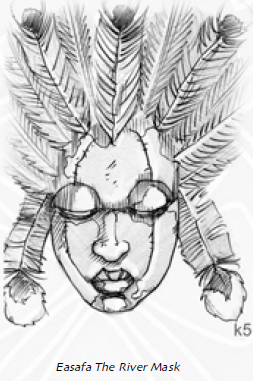
Wondrous Items include everything that doesn’t fit the above, and heavily focuses on masks and nkisi. The non-mask/nkisi new magic items include Headrests of Slumber which cast a triggered mental Alarm spell which sounds whenever anyone approaches within 60 feet (seems a bit overkill), a Magic Fang File which can turn your teeth into a permanent magical bite attack, a Bow Stand of Victory which can temporary grant a +1 bonus on any non-magical bow which rests on it for at least 8 hours, and the Fertility Doll which can alter the possible gender of a born child by 20% if continuously carried for one week.
Masks and nkisi are grouped together, but are activated in different ways. A mask is fashioned in the likeness of a specific orisha and grants the powers of said spirit when worn. Whereas nkisi are tiny figures made in the likeness of an orisha, and their magical effects activate when a nail is pounded into them and grants their benefits to a carried wielder for 24 hours.
The masks’ and nkisi’s powers vary depending on the orisha in question: Ancestral grants luck bonuses on attack and weapon damage rolls, or on AC and saving throws depending on whether they’re made for spiritual advice or protection; Celestial grants competence bonus on relevant skill checks (Scry/Spellcraft for Ramaranda, Diplomacy/Swim for Easafa, etc); Elemental grants energy resistance or Damage Reduction in relation to the element in question; Fiendish grants the ability to cast a single spell once per day, usually of a dangerous or macabre variety; Geographic grants a specific bonus type to Armor Class (deflection for Ocean or Wind, natural for Iron); finally, Natural grants a bonus to a single ability score based upon the related animal or plant (Intelligence for clever animals like jackals, Constitution for sturdy creatures and trees, etc).
Finally we have Trinkets, minor magic items worth 25 gold pieces or less which are widely popular and designed for entertainment or quality of life purposes. They include minor magic such as a self-heating gourd bowl for food, a comb which instantly untangles hair, and so on.
There are no new Intelligent Items here, but we do have some spooky scary Cursed Items! Most cursed items are masks and nkisi made by evil spellcasters for their powerful religious association, hoping to trick people into using them. The two new ones include the Death Mask which permanently bonds to a wielder’s face and inflicts fire damage every round, while a Vodou Nkisi inflicts a powerful debuffing spell on whoever strikes a nail into it. There are rumors of the possibility of using body parts and cast-offs from a target to affect them, but thankfully no mchawi or n’anga have found a way to do this yet.
Minor Artifacts used to be more common items in the mythical past, but the secrets of their creation have been long since lost. They include the Blade of Scarring which grants you a permanent ability score bonus by carving a pattern into your flesh; Lesser Udamalore are ceremonial ivory swords designed to deal nonlethal damage and cast Dominate Person on any humanoid they strike on a failed Will save; and the Greater Nail Figures are found in the major temples of Mabwe and have protective spells anchored to their radius. Additionally, anyone who pounds a nail into it while reciting an oath imposes a Geas/Quest spell on the oathtaker, and the orisha will strike divine lightning on anyone who tells a lie while laying a hand upon the Nail Figure.
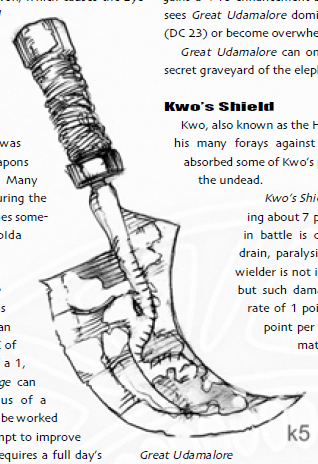
Major Artifacts are truly unique items, created from the foundations of the world or gifts from the orisha themselves. We have a lot more than the Minor Artifacts, 10 in total. They include the majestic Adamu Dwa, possessed by Nibomay’s rulers since ancient times and grant a host of powers to those who sit upon it (Spell Resistance 40, +5 caster level, +6 AC); the Drum of Tarango which grants +10 to Perform (Drums) and lets a bard or ngoma know all spells from the bard spell list as long as they play the drum while casting; the crystal ball-like Eye of N!ok which allows anyone with Kosan blood to cast spells through the scrying interface; the Forge of the Kosans which can increase a weapon’s enhancement bonus beyond the +5 maximum with no XP or GP requirements...but instead requires a living humanoid sacrifice; Great Udamalore which has a more powerful Dominate Monster than its Lesser counterparts and grants +10 Charisma to the wielder; Kwo’s Shield which grants immunity to all manner of undead and energy-draining abilities as well as the ability to recover ability score damage at 1 point per minute rather than per day of natural healing; the Mask of Nyambe which bears the face of the Overpower itself but blinds all who see it while granting Blindsight and the ability to cast Miracle once every 5 days from the Overpower themself to anyone who wears it; the Opon TuIda, which was made by Ramaranda in an attempt to teach dragons divine magic, can grant 100% accuracy to all divination spells cast upon it albeit at risk of attracting the attention of a dragon who will retrieve the item from the “unworthy” owner; the Skin of Zombi was once worn by Zulo and grants the advantages of the Undead type with none of the drawbacks, but slowly turns the wearer into a True Zombi over time; and finally the Spear of Z’idan, an intelligent bronze weapon inhabited by a spirit of the same name who taught many secrets to the ancient Boha-Boha people.
One last thing: each entry lists ways of reflavoring existing corebook magical items into Nyambe. Most of them are cosmetic, like changing boots to sandals, but some such as Bracers of Armor have a price increase if they grant an armor or natural armor bonus.
Thoughts So Far: Overall I like this chapter. I particularly enjoy the new rules for existing items, and the new gear is both effective and thematic to the setting. The Trinkets are quite a cool touch, as it lines up well with omnipresent spellcasters (at least of the divine variety) being present in even more rural communities. It also shows that items not immediately applicable to adventuring exist in society, an all-too-common aspect lacking in the world-building of many D&D settings.
Join us next time as we cover the final chapter, Monsters of Nyambe!
Monsters of Nyambe
Original SA post
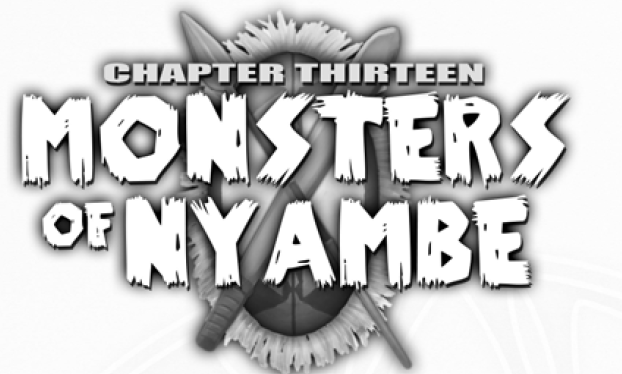
We got plenty of lions and a few imported baers, but no tigers! The final chapter is by far the longest, taking up 25% of the book’s content with nearly 60 new monsters, all but a few with their own artwork. For obvious reasons I’m not going to go in-depth on specific monster types, but will holistically cover what I can. Here’s the table on the monsters by CR so you can get a feel for their intended power levels:
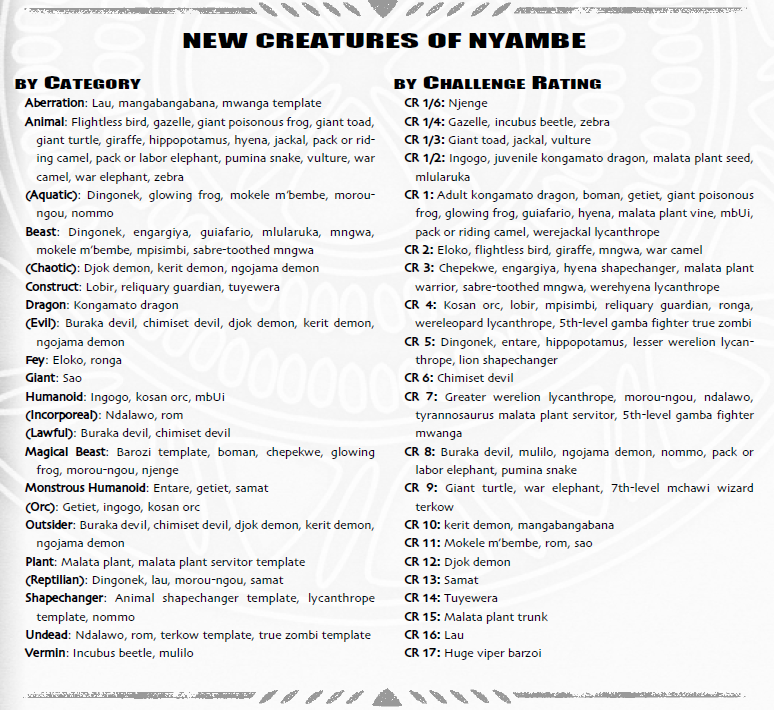
Existing Creatures
In this section we include both monsters from the core rules as well as the broad monster types. The entries are overall brief, with some such as the chimera and dire animals getting a surprising amount of detail. A few are reflavored to fit the setting, such as chaos beasts being servants of GuDuGu and chokers being engolo monks corrupted by evil magic. Some interesting tidbits:
- The JamIkadi of Nibomay keeps a stable of chimeras as pets.
- Dire animals are more common than elsewhere, and instead of dire wolves Nyambe has dire hyenas. Dire bears live in the Kuba Taaba Mountains, likely imported but nobody has any idea of the responsible party.
- Dragons were the only race not created by the Overpower, instead born of the world itself. This gave them the ability to naturally work arcane magic. As part of their deal with creating the Sei, Ramaranda the Diviner taught them how to use divine magic, so all Nyamban dragons can choose spells from the cleric as well as sorcerer/wizard spell list, which more easily makes the Summon Dragon spell “Summon Spellcaster” at higher levels.
- Ethereal Filchers and Ethereal Marauders are servants of orisha sent to respectively steal items from or attack those who fail to make proper sacrifices. As such they are known as shadow thieves and shadow warriors.
- The Greco-Roman monsters (hydras, harpies, medusa, etc) are personal servants of various fiendish orisha and often have specific tasks. Hydras guard Zombi’s temples, harpies procreate by killing women and mating with men at the behest of Molamu the Seducer, medusa are known as anath and are Amazons corrupted by Zombi’s magic, etc. Gorgons are an exception, being the cursed forms of humanoids who committed the crime of bestiality.
- Genies, lammasu, and manticore hail from the Near East, and Sphinxes once had an unknown relationship to the Water People given that they now tend to avoid humanity.
- MbUi were once humans infected with werehyena lycanthropy, but became a race of their own when they ended up locked into their hybrid forms for unknown reasons. They are statistically identical to corebook gnolls save they have better Armor Class due to better equipment and natural armor.
- Ogres are known as dimU and believed to be the reincarnated souls of those who committed infanticide.
New Monsters
Boman are the descendants of the bat who swallowed the frog in the Mythical Ages, thus preventing people from learning the secrets of resurrection. They all bear this sort of original sin, now invariably evil creatures who can drain the blood of those they bite. Anyone killed by boman are forever denied the ability to be resurrected (but can reincarnate).
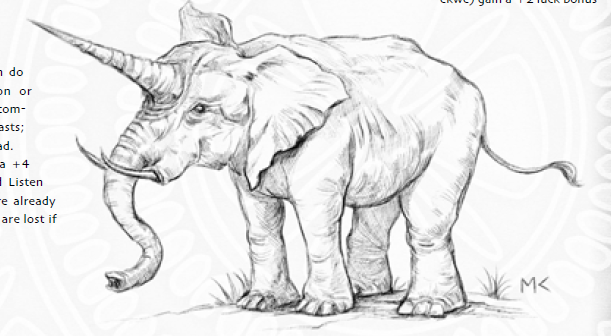
Chepekwe are small elephant-like creatures who radiate good luck and have some utility spells. They are friendly and helpful to those who do not bear the taint of evil.
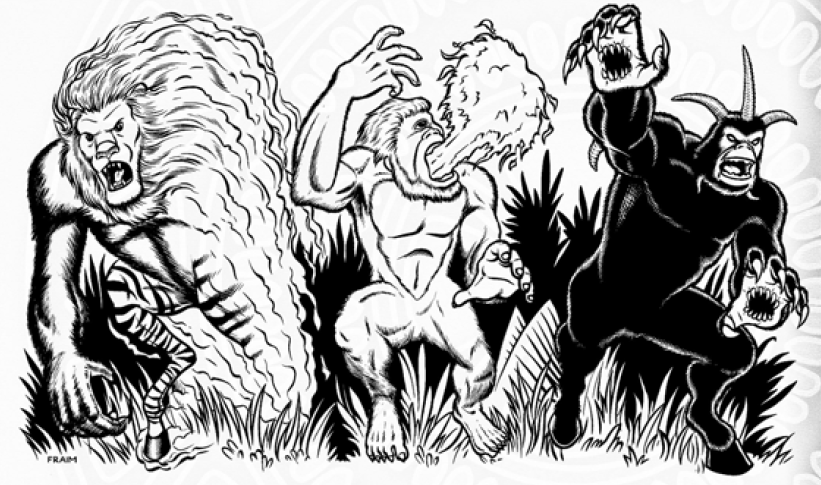
Demons of Nyambe are servants of the fiendish orisha, and we get 3 new ones: Djok are murderous entities who can possess the bodies of animals and vermin colonies, and all n’anga of animal orisha can detect them and know a special chant to force them out of a possessed body. Kerit are fire-breathing gorillas who lurk in the most remote areas of the bIda rainforest, their howls capable of literally draining strength. Ngojama bear three mouths, two on their palms designed for enhancing their natural claw attacks.
Devils of Nyambe are the more lawfully-inclined fiendish orisha servants. The Buraka act as spiritual advisors and tutors to mchawi wizards and radiate an aura of bad luck. Chimiset are cowardly bird-like things who kidnap children and livestock by luring their prey in with hypnotic songs.
Dingonek are intelligent elephant-sized monsters who bear the head of a lion and body of a crocodile. Their scales can be made into masterwork armor, and while they normally prey on herd animals they hate it when humanoids violate their hunting grounds.
Eloko are short fey who love the taste of humanoid flesh and bear magic bells capable of charming their prey. They often gather together in groups, and as they do not possess racial hit die and advance in classes they can technically be played as PCs...although they are a bit strong given they have some pretty nice ability bonuses to all but Charisma, good Spell Resistance, natural armor, and two bonus feats.
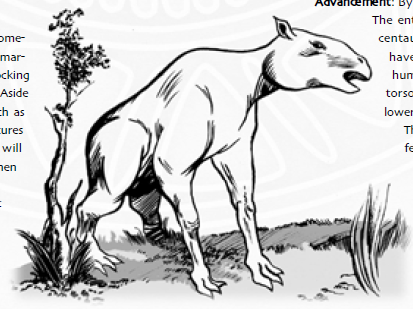
Engargiya were used as pack animals in lands outside of Nyambe-tanda, but were turned into fierce war mounts by Kwo and are now extinct in the rest of the world. They are like heavy warhorses, but have stronger claw attacks rather than hooves, darkvision, low-light vision, and scent which make them great trackers. They are Beasts rather than Animals, and only the most determined riders can master them due to their sloped backs, imposing a -5 penalty on all Ride checks.
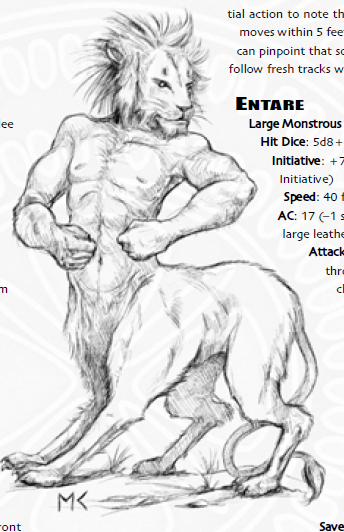
Entare have the head and lower torso of a lion, but the arms and upper torso of a human. This makes them incredibly strong, and alongside the Shombe are the most infamous warriors of the tUbi Grasslands. They gather in family-based clan units and have a variety of melee-based abilities such as pounce, rake, and improved grab along with scent, making them excellent ambush hunters as well as warriors.
Getiet look like an orc/gorilla/cheetah hybrid, the descendants of kosans who long lost their vaunted status. They are overall rare but gather in bands to attack small groups and lone travelers. In spite of having opposable thumbs they are incredibly stupid (6 Int) and haven’t really comprehended how to use weapons and tools, instead relying on their fast sprints (300 feet per round once per hour) and rending claws.
Glowing Frogs are tiny heroes dedicated to fighting the forces of evil...that is, if they had any reliable offensive powers. Instead they do the next best thing, finding other creatures to aid in this honorable endeavor. They can use telepathy and bear inherent psionic abilities focused around utility and debuffs.
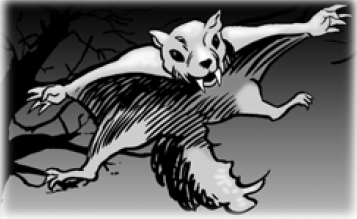
Guiafario are flesh-eating flying squirrels who can attach to bitten victims and damage them over time. Somehow their picture is both terrifying and adorable...adorably terrifying.
Ingogo are the other “degenerate kosan” race, appearing as human-sized baboons. They’re smarter than the average orc (12 Int) and have mchawi as their favored class, but one would not ordinarily tell as they mostly communicate in swear words with outsiders. They can use handheld tools and weapons and also can throw their dung as a ranged touch attack which can impose the worms disease on those struck.
Kongamoto Dragons are an animal-intelligence “protodragon” which look like pterodactyls and likely included in this chapter to give low-spellcasters with Summon Dragon the ability to summon something useful. They are typical hunters, eating fish and small animals near rivers, and some lucky few have trained them to carry messages across great distances. They have a sonic-based breath weapon and the typical claw/bite attack.
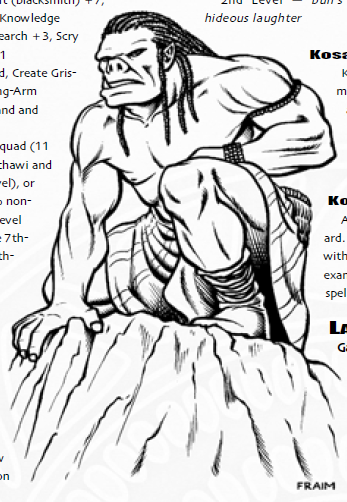
Canonically, Kosan Orcs are extinct, but starts are provided for DMs who want some isolated bands still around or for certain rumors from Chapter 11. They’re physically identical to orcs but are smarter and take better care of their personal belongings. They have racial hit dice and can cast spells as though they’re 4th-level mchawi (which can stack if they take levels in the class). While they prefer to rain magical devastation down on their opponents, they can make for tough “warrior-mage” types.
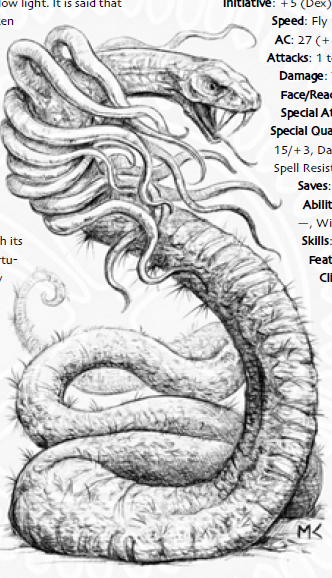
Lau are one of the most powerful and infamous creatures in all of Nyambe. They are gigantic snake-like beasts, possessed of great intelligence and bear poisonous tentacle-like spines. Nobody knows their origins, and the rumored “king” of the Lau is a Colossal-sized 30 Hit Dice being 100 feet in length (most Lau are Gargantuan, around 40 feet)
Lobir are non-intelligent flying invisible constructs created by the spell of the same name, and appear as small insects or cones of metal to those who can see invisible creatures. They are very squishy (6 hp) but they have a boatload of natural defenses: in addition to flight and invisibility, their Armor Class is a stellar 27, and they have 20 Spell Resistance and Damage Reduction 15/+3. If they hit a victim with a touch attack they can burrow into their skin, dealing 1d4 Constitution damage per round, and they can only be dislodged via a Heal skill or powerful healing magic of at least 7th level.
The dreaded Malata Plant is 4 monstrous stat blocks in one, each creature bearing a symbiotic relationship to the whole. They are otherworldly beings from one of Da’s coils, who survive by turning nearby communities and ecosystems into mindless servants. The “trunk,” or heart of the expanded network, appears as an 80 foot tall baobab tree with a maw-like opening, capable of creating nearby plantlife such as thorn bush walls and minions. Malata plant seeds are tiny fibrous husks with bat-like wings which can grow into new trunks in mere days once they take root somewhere. Malata plant vines are the “hands” of the trunk, appearing as 20 foot long vines which can constrict prey and manipulate tools. Finally, the malata plant warriors are humanoid-shaped extensions of the trunk, connected by a stem to the trunk or a nearby thorn bush wall, dying if the stem is severed.
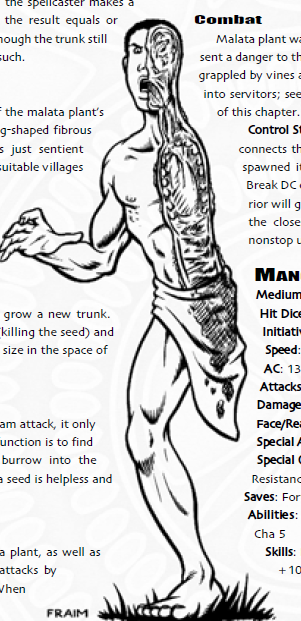
Mangabangabana are a race of humans who became separated in two due to an ancient curse. They move around by flying through the air and feed on the flesh of humanoids, with children being a favored prey. Mangabangabana are natural spellcasters, learning and preparing spells as though they were 8th-level mchawi, and have an 18 Spell Resistance.
Mlularuka are flying jackals, keeping aloft on warm updrafts in the savannah. They are not directly dangerous to humanoids but do steal food and small items by swooping down from the air.
Mngwa are feline predators about the size of mules native to most of the continent. Some have scythe-like fangs which make for powerful natural weapons, and they can be domesticated.
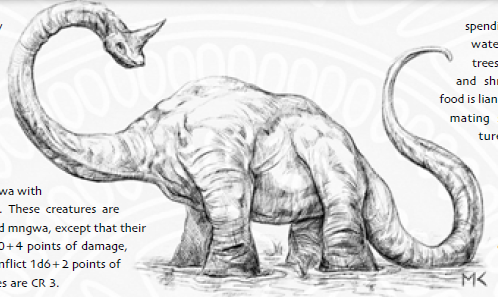
Mokele M’bembe goes by many names due to their fame as gigantic dinosaurs native to the swamps and forests of the continent. They avoid contact with humanoids, but they are big enough to capsize boats (which they commonly mistaken for edible fish) and their flesh is highly poisonous, capable of killing most humanoids within a minute.
Morou-Ngou are elephant-sized amphibious felines who have scales instead of fur. They are also semi-intelligent (Int 4) and can magically generate whirlpools and strong currents in nearby bodies of water to waylay prey.
Mpisimbi are a magical crossbreed created by MbUi priests long ago to serve as hunting and guard animals. They look like yellow and black-striped leopards with the speed of a cheetah and a crafty intelligence (5).
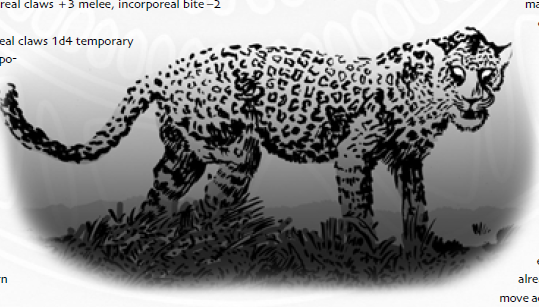
Ndalawo are leopards who died from undead known as shadows. They are incorporeal and create spawn, its form either a mere shadow or a fellow Ndalawo depending on what they kill. They are very deadly, possessing the pounce ability and claw attacks in addition to a Strength-damaging touch.
Njenge are goat-like beings with magical powers, causing nearby plants and crops to grow rapidly from soil they magically enrich by mere touch. They slowly die in captivity, meaning that while villages welcome their presence they do not attempt to constrain their movement.
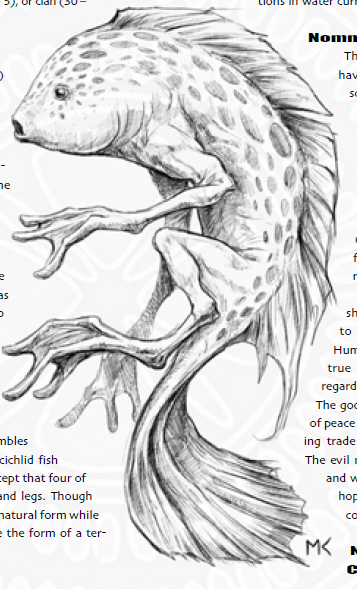
Nommo were the aquatic race who taught the Mbanta people the art of psionics and astrology, and the latter humans’ legends teach that the Nommo came from the stars (aka Spirit World). Nommo society is split into two factions, one good and the other evil, who went to war in the Middle Ages. Their mighty clashes caused the earthquake which sank the Mbanta homeland as well as forced the kitunusi and utuchekulu above-ground. This disaster caused the nommo on both sides to take more subtle approaches in future conflicts. They are capable of shape-changing into humanoids and have some natural psionic powers along with a decent 20 Spell Resistance.
Reliquary Guardians are tiny cat-sized constructs bearing equally-small weapons. They are built by the Hutali people to guard over the remains of their ancestors, animating whenever someone approaches the container of a corpse save for those related by blood. They can supernaturally track the location and distance of a deceased charges as well as their remains and possessions, and have a poisonous bite attack.
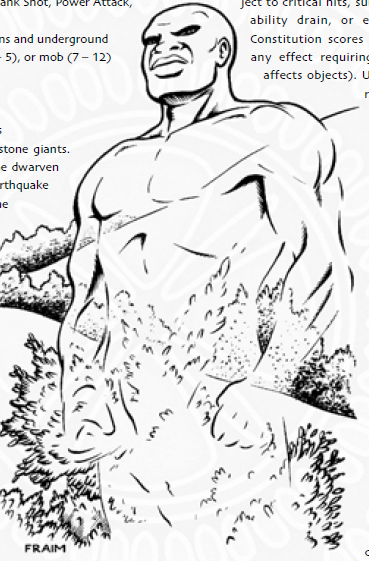
Rom are a race of stone giant ghosts who perished during the earthquake which brought the utuchekulu to the surface. They haunt their dwarven enemies to this day, and are thus the greatest obstacle to the utuchekulu’s attempts at digging back home. Rom are incorporeal but can throw and catch incorporeal rocks which hurt just as much as the real thing, and their club attacks cause Constitution damage. They are powerless in sunlight, keeping them solidly underground most of the time.
Ronga are goblin-like faeries native to the Shadow World, and only ever appear in the heart of the bIda Rainforest when they do visit the material plain. They are unpredictable, capricious creatures, sometimes helping and attacking the very same people over the span of a day. They have a host of tricky fey-style spell-like abilities such as blink and silent image.
Samat are the powerful ancestors of the yuan-ti, just like the Kosan are to orckind. The Samat civilization were allies to the Kosans, unconquered due to their alliance with Zombi the Serpent Lord just as the Kosans were favored by N!ok the All-Seeing Eye. The Samat were slaughtered as well during the Great Rebellion, their survivors fleeing over the ocean to the Far East. They look nearly identical to yuan-ti, and the only ones within Nyambe-tanda are mummified in ruins of the bIda Rainforest. They can be resurrected if a major artifact is touched to a ceremonial shield in the mummy’s hand, or that of a living humanoid creature (who will die from having their life force absorbed). Once awakened, they will work to resurrect their brethren, growing in power over time with the goal of taking over the continent.
Statswise the samat have a host of psionic powers as well as an assortment of snake-like abilities and natural weapons. Their skin can naturally produce acid which damages those who touch it, and can create a long-lasting mental compulsion which forces targets to flee from them and other serpent-like beings on a failed Will save.
NSFW Strategically-Placed Deer
Sao are a race of pacifist giants, so they live in the deepest reaches of the bIda Rainforest in order to avoid conflict with other humanoids. They claim to be one of the oldest races created by the Overpower, although there is little evidence to support this theory. Although physically powerful, they only enter combat as a last resort. Most of their spell-like abilities revolve around nature and helping them hunt, and can intuitively cast the fabled Arrow of Slaying/Phase Arrow spells as well.
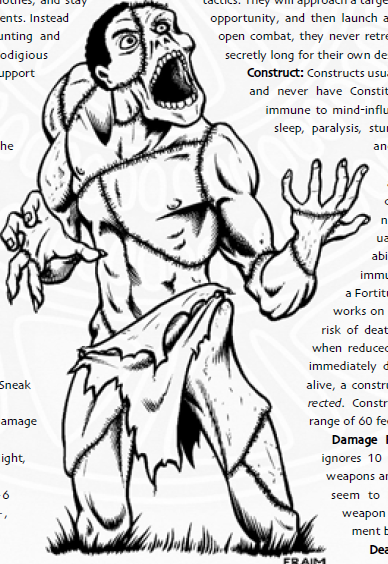
Tuyewera are a type of flesh golem created by mchawi wizards. They are more subtle, human-sized rather than Large and intended for covert assassinations. They are naturally invisible at night and possess Sneak Attack and Death Attack (save or die a struck opponent if you first study it for 3 rounds) in addition to the typical construct immunities.
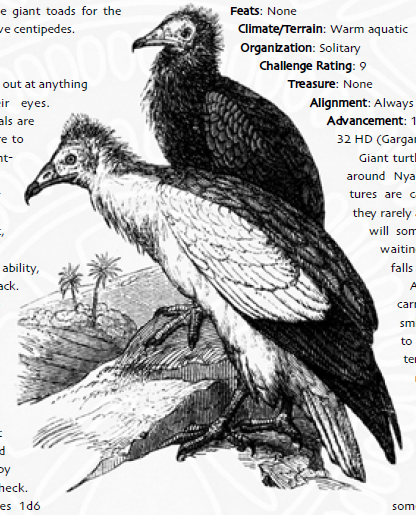
New Animals & Vermin
This section is light on new artwork, unsurprisingly. A lot of the new animals are for stats of existing real-world creatures or altered versions of corebook ones. Thus our “new” animals and vermin include the following: the war camel is a stronger version of the standard breed with more Hit Dice. War Elephants are similarly advanced versions of typical elephants, who deal slightly more damage and have more hit points. Flightless Birds are meant to cover ostriches and similar species, possessing a bite, kick, and even trample attack where they can knock down multiple creatures in a charge. Giant Poisonous Frogs are exactly what they sound like, and not much needs to be said about Gazelles who are weak and virtually harmless but quite fast.
Giraffe are Huge animals but overall quite weak (Huge yet CR 2 and don’t deal full STR on kick/gore attacks). In a D&D twist they formed a symbiotic relationship with the Formians, ant-like extraplanar outsiders whose scouting party got stranded in Nyambe due to a failed invasion attempt. The formian scouts live in acacia trees of immense size, and the giraffe sometimes feed from these trees. As a result, most hunters do not target giraffes for fear of incurring the formians’ wrath.
Hippopotami are quite dangerous and strong, possessing a nasty bite attack, and are often hunted as their natural oils make for excellent sunscreen.
Hyenas and Jackals use wolf and dog stats respectively, although hyenas have a rare chance of their encounters containing actual treasure nearby due to them being scavengers lured to dead bodies. Vultures are often domesticated by monster-hunters for the purposes of tracking down undead. Zebra use pony stats and are inoffensive animals. There are Giant versions of toads and snapping turtles, the latter of which has a very high Armor Class and can retreat into its own shell to gain Cover bonuses (and which can be made into masterwork shields when defeated). The dreaded Pumina Snake can grow up to 60 feet in length, fond of grappling prey and pulling it into the water to drown.
Our two new vermin include the incubus beetles and mulilo. The former are said to crawl into the wombs of sleeping women and impregnate them, the child growing to perform great feats of legend. As such they viciously attack and feast on the flesh of men but are harmless to women, meaning that some Amazons keep them as pets or for warfare purposes. The mulilo is an elephant-sized snail who can spit a stream of mucus which can stick creatures to nearby surfaces like glue.
New Monster Templates
Animal Shapechangers are not lycanthropes. Rather they are animals capable of assuming the forms of humanoids. They have all the natural features of their base animal type, but their roars, laughs, and howls can act as per-day AoE debuffs depending on the sound. They can shape-change into a humanoid or hybrid form, and can regenerate damage and lost limbs like a troll which can only be overcome by fire or a specific “bane material.”
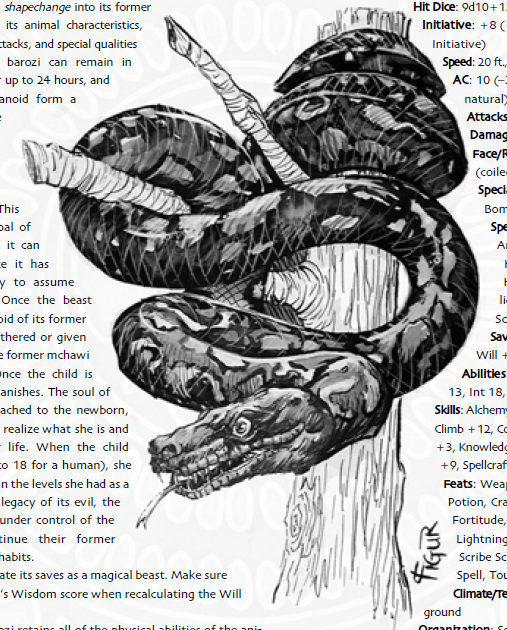
Barozi are mchawi reincarnated into the forms of animals. The “base” stat block is that of a normal predatory animal of an equal or lesser Challenge Rating than the deceased mchawi’s class level. The barozi in turn gains the ability to mentally dominate animals of its type (which then develop a taste for humanoid flesh no matter their normal diet), can pass through torn bush walls without harm, sense the presence of all humanoids within one mile, and can cast all of the Mchawi spells they knew in life. The last part is actually very limiting since most animals lack the anatomy for verbal and somatic means of casting spells. Fortunately the barozi can overcome these limitations by gaining enough Hit Dice to get a humanoid voice at 14 HD and even temporarily assume humanoid form at 16 HD.
In fact, finding the way to gain humanoid form is a great boon: they can mate with fellow humanoids, their souls transferring into the new life once it births with the barozi’s original form disappearing. They have perfect recollection of their former barozi and pre-barozi lives, instantly regaining all their former levels and thus cheating death. Even better, this form of “resurrection” is not limited by a percentage failure chance.
For PC-conscious builds, a barozi can continue to earn XP and gain mchawi levels, or alternatively advance one HD as a Magical Beast every time they’d ordinarily gain a level.
As you can see, this template is a bit of a mixed bag. On the one hand, the lack of verbal and somatic casting is a huge punishment which won’t be overcome easily. Silent and Still Spell metamagic feats can overcome this, but the +2 effective spell level is pretty harsh to put on almost all of your prepared magic. As the templated animal keys to Challenge Rating rather than level/hit dice, getting to 14 Hit Dice may be sooner than usual depending on the animal type you pick.
But on the other hand, certain animals can have some pretty powerful abilities which can make for a nice warrior-mage build (Pounce for a lion, Constrict for snakes) and the d10 Hit Dice and physical ability scores of said animal make up for the common dump stats of wizards.
There are many new Lycanthropes in Nyambe, including the werehyena, werejackal, wereleopard, and even the infamous werelion! Werehyenas are wicked and cowardly, werejackals are benevolent and honorable creatures who fight their more wicked shape-changing cousins, while wereleopards all belong to the Leopard Cult. Werelions come in Lesser and Greater breeds. The Lesser werelions are neutral and their hybrid forms look like entare, while the Greater werelions are Lawful Good and can take dire lion form. The latter are hated by the entare, who send warrior parties to hunt down and kill suspected sightings. Greater werelions are naturally born, incapable of transmitting lycanthropy to others.
Malata Plant Servitors are slow-moving, animal-Intelligence hosts who have been infected by a malata plant trunk’s controller thorn. Their skin becomes green and emerald-colored veins sprout throughout their body. They basically become living zombies with the plant type and only take half damage from piercing and bludgeoning weapons.
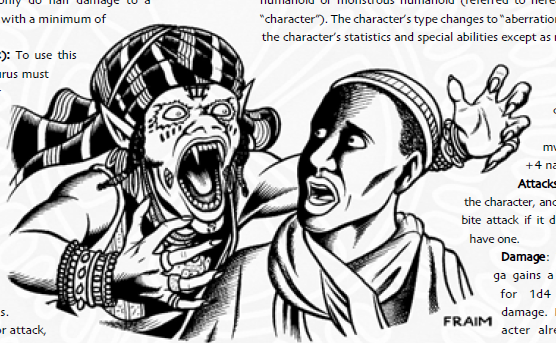
Mwanga are “false vampires,” living creatures cursed to crave the blood of others. The original mwanga was a warrior who struck a devil’s bargain with an animal orisha to become a better hunter. He got his wish granted...and then some.
Mwanga become Aberrations, gaining vampire-like features such as a blood-draining bite attack, a charm-based gaze attack, and the ability to infect others by draining them of blood and mentally enslaving them. They can transform into a leopard, dire bat, or dire rat.
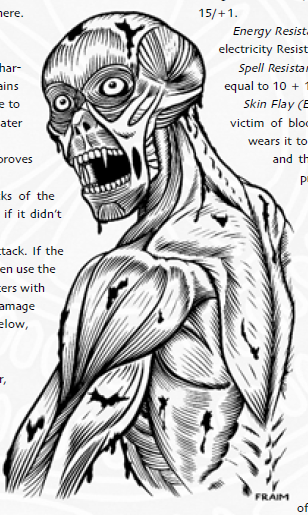
Terkow are Nyambe’s “true vampires,” skinless undead who must suck the blood from others to replenish their fast-draining supply. They can skin their victims and disguise themselves as ordinary humanoids, even gaining the ability to walk in direct sunlight due to this. In addition to typical blood-draining abilities they cause those they drain to death to rise true zombis or fellow terkow depending on their Hit Dice. Terkow lose 2 hit points per day from rapid blood loss but can wear a victim’s skin to partially nullify some of their weaknesses. Finally they are deathly vulnerable to salt water, being damaged by it as though it were lava.
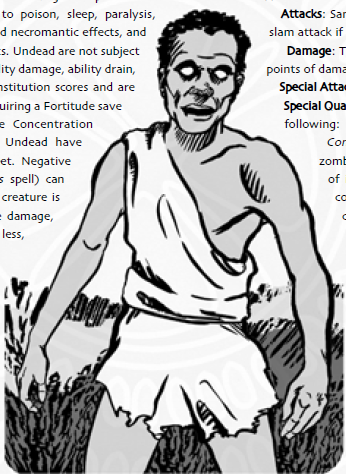
True Zombi gain their title from the fiendish orisha of the same name. Zombi is so closely associated with undead in general that the most common kind has become synonymous with the dread orisha’s title. True zombis are a stronger version of the typical “zombie,” created only via magical Zombi powder or by a member of the Zombi Cultist Prestige Class. The base creature gains typical zombie traits, but the major difference is that they’re still intelligent and under complete control of their necromantic creator. They also have Fast Healing which can only be negated by fire, acid, salt, or holy-based weapons and attacks. In fact, salt is so dangerous that they cannot abide even its mere touch, and a Magic Circle Against Evil imbued with salt can ward them off regardless of their alignment. They are also mute, meaning that raising martial types over spellcasters is preferred. Finally, true zombis retain their original alignment, but their lack of control forces them to take evil actions by their creator. A rather horrifying loophole!
Thoughts So Far: Overall I like the new monsters. They tend to vary in quality; I found the new animals and “big brute” monsters rather uninspiring, but really like the creatures with a non-characteristic role. Creatures such as the Njenge serve a more folkloric or non-standard role that doesn’t boil down to “hunt the monster,” while some of the non-evil intelligent ones such as the Glowing Frog or Reliquary Guardian can be tied to a greater quest nearby. I did like how some of the monstrous entries such as the Nommo and Samat did some implied world-building by referencing earlier historical and political events.
I can also see some inspirations in the monsters in regards to the other two “Fantasy Africa” games I reviewed. The tormented state of True Zombis is similar to Spears of the Dawn’s Eternal, while the Malata Plant monsters are quite similar to Southlands’ Green Walker minions. The Barozi is the only PC-friendly option, but even that needs some care as the choice of animal can leave a mchawi (anti)hero crippled, and all but mandates Silent and Still Spell for said class’ build. The only truly-friendly PC race is the ingogo, as the other monsters which advance by class have a host of abilities which can be unbalancing for most campaigns.
Concluding Thoughts
Nyambe is overall a good setting. The Third Edition ruleset means that it has not aged well, but still remains a unique treasure amidst the smorgasboard of third-party worlds. Its world is more piecemeal, with big-picture conflicts and legacies of days gone by for Dungeon Masters to build upon rather than having plots set in stone. In comparison to Spears of the Dawn and Southlands it does not have the robust “create your own adventure” sandbox of the former, nor the intimate level of localized details of the latter.
It is rather lacking in a “big evil empire/cult/etc” and other major antagonists, the greatest evils confined to desolate corners of the world. Meanwhile, the greatest foes are often all-too-human political ambitions and folly. Even then there’s enough cool little things in both the rules and the world-lore to add to your own games, and it should not be very hard to convert Nyambe to the Pathfinder (1st Edition) system.
Finally, the author provided us with a handy bibliography which he used as inspirational material:
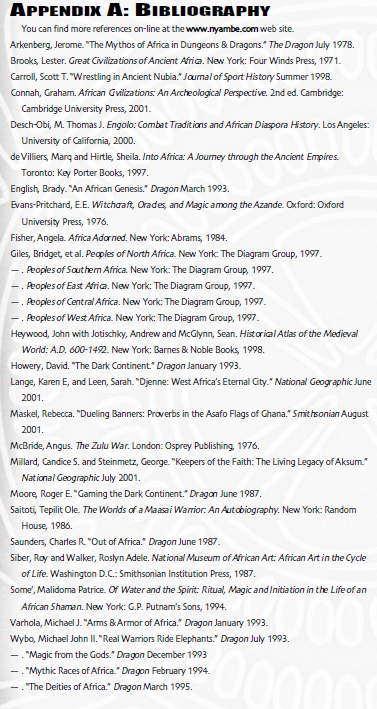
I’d like to thank everyone for reading this far with me. I’m going to take a break from Let’s Leads for the foreseeable future, but I hope that I left you all with an entertaining review and a potential setting to explore!